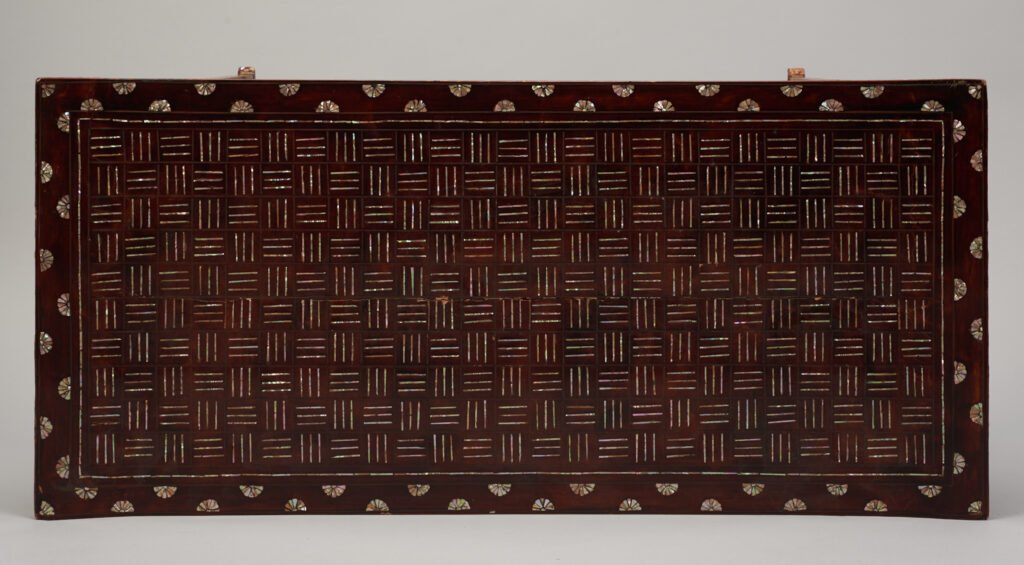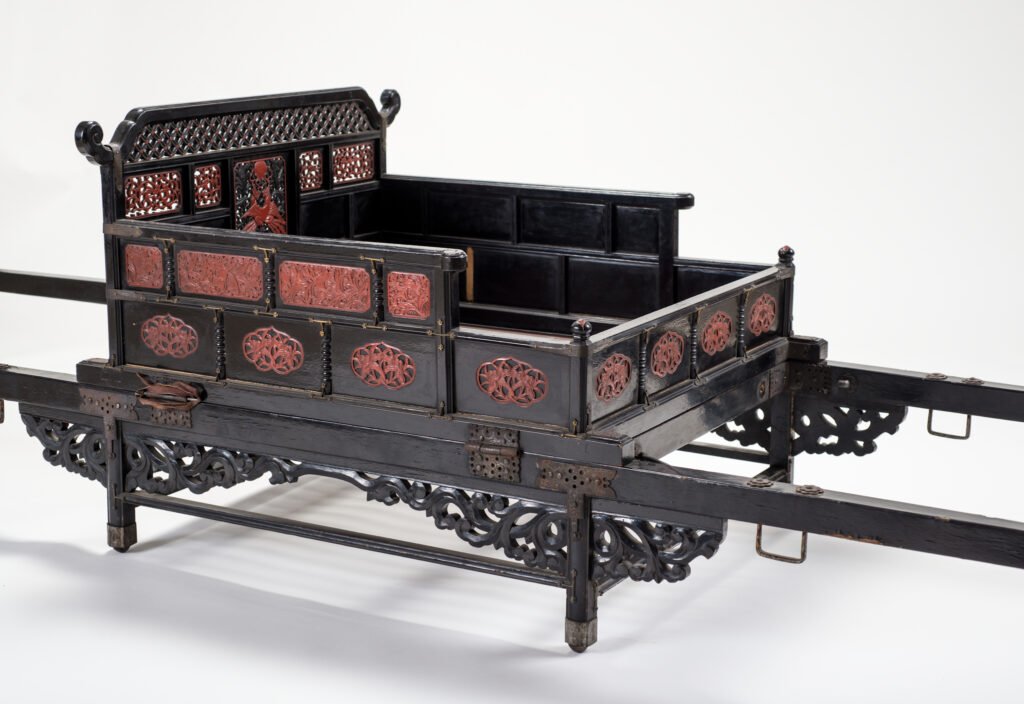INTERESTING LISTING OF KOREAN COLLECTIONS IN AMERICAN MUSEUMS: https://www.museum.go.kr/site/eng/exhiForeignMuseum/list/all
WEISMAN ART MUSEUM – Minneapolis, MN
The collection includes about 200 examples of Joseon dynasty (1392–1910) furniture, 80 Silla dynasty (668–935 B.C.) stoneware pieces, some 150 folk paintings and wooden bowls and utensils, in addition to other folk arts and crafts. The collection came to the Weisman Art Museum as a bequest from Dr. Edward Reynolds Wright Jr. in 1988.
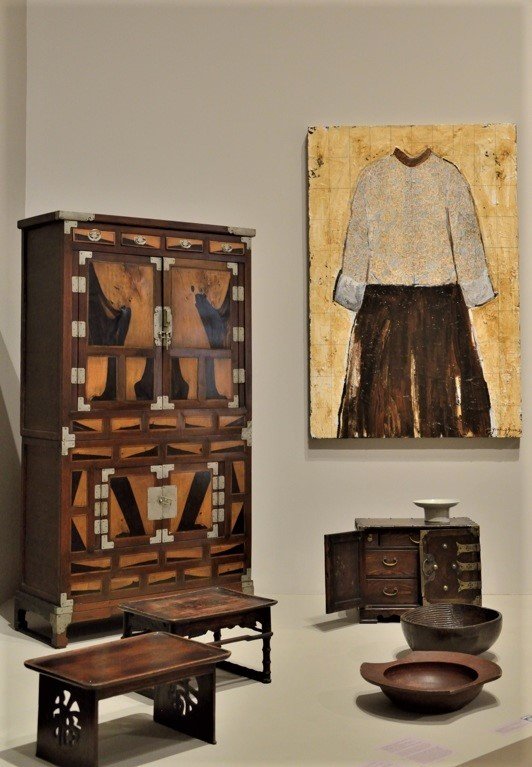
In 1967, when Edward Wright went to Seoul. He soon developed a love for Korea culture and arts and became an avid collector of traditional Korean furniture. Because of the massive dislocation and poverty of Korean families, there was plenty of good furniture for sale. Wright put together, in the eleven years he lived in Korea, a collection that could not be assembled today. He was able to add a number of items from North Korea that are rarely available in the market now.

He collected carefully, to make sure he had all regional styles, all kinds of wood, and all types of boxes represented. His collection includes clothing storage chests for men’s and women’s quarters, bed, headside chests, tray tables for eating and for food offerings to ancestors, boxes for documents and writing instruments, letter holders, desks, kitchen cabinets, rice and bean storage chests, wedding gift boxes, beds, coin chests, medicine chests, make-up boxes and mirrors, tobacco boxes, sewing boxes, book shelves and book chests, and a palanquin (a coach carried by poles on the shoulders).
Nearly every wood, decorative material, and joinery technique is represented in the collection.
This collection has been published in the book “Korean Furniture: Elegance and Tradition” by Edward Reynolds Wright, Man Sill Pai. Published in 1984 (First Edition).

INTERESTING LINK: Elegance and Tradition in Korean Furniture – Gallery Talk with Dr. Lyndel King
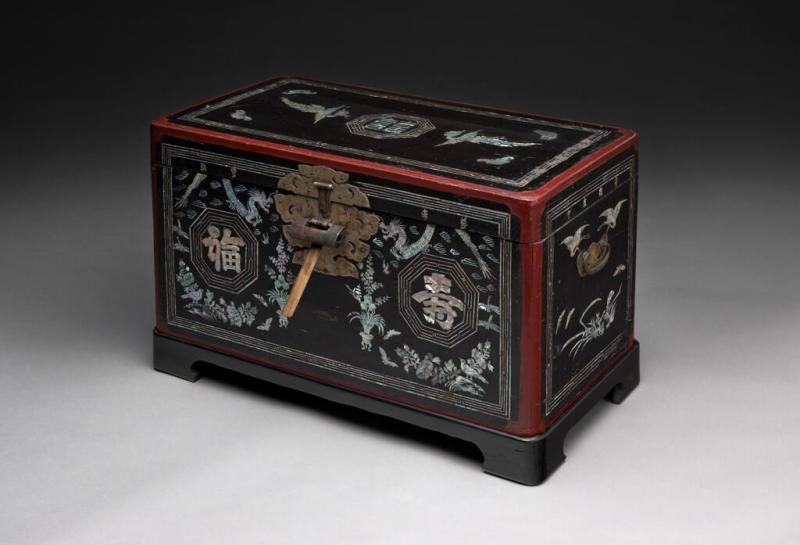
Black and red lacquer on wood, mother-of-pearl, yellow brass fittings
H. 42cm, W. 69cm, D. 38cm.
DATE 1950s
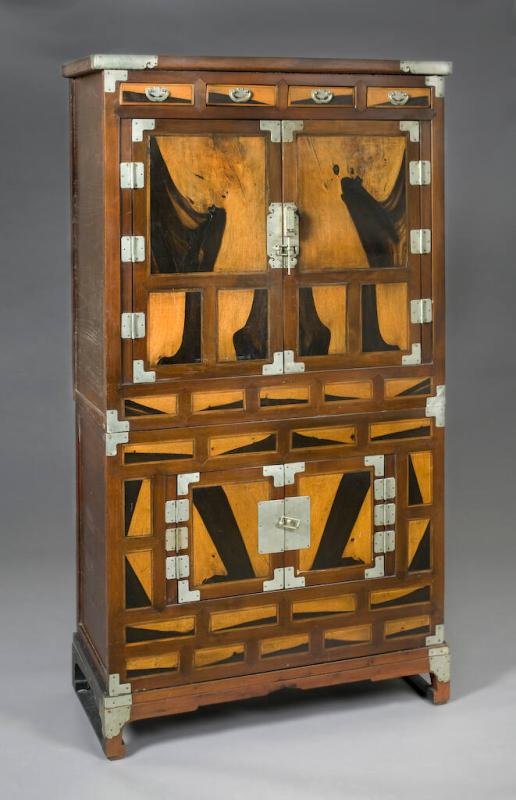
Persimmon, pear, and paulownia woods with nickel fittings and oil finish
H. 170cm, W. 94cm, D. 42cm.
DATE 20th century
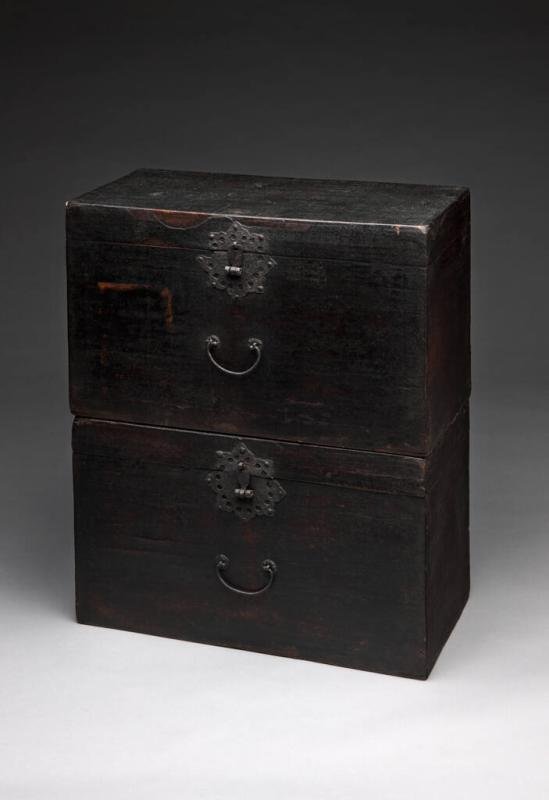
Paper over wood, wrought iron fittings, natural lacquer
H. 36,8cm, W. 62cm, D. 30,5cm.
DATE circa 1900
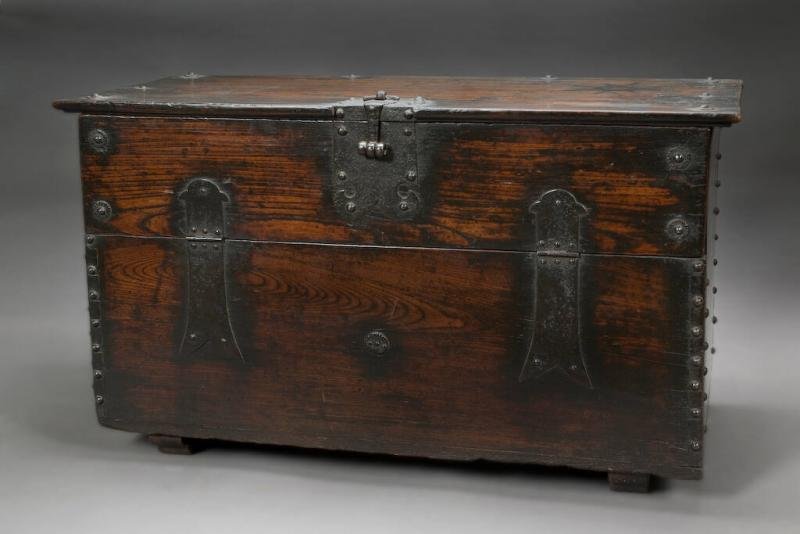
Zelkova and pine woods, wrought iron fittings
H. 50,8cm, W. 87,6cm, D. 38cm.
DATE 1800s
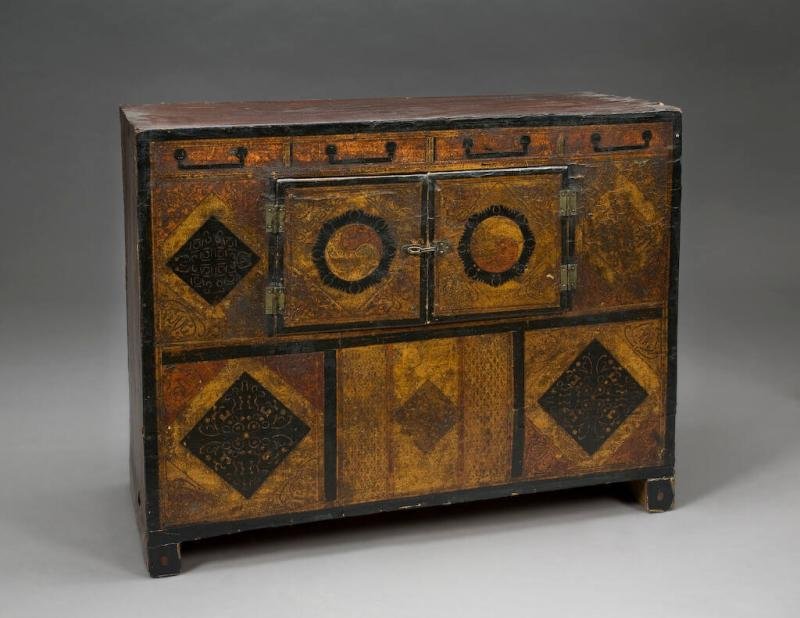
Colored paper, lacquer finish, pine wood, wire, tin fittings
H. 60cm, W. 76cm, D. 32,4cm.
DATE circa 1900

Persimmon and chinaberry woods with brass fittings
H. 38,7cm, W. 94,6cm, D. 27,9cm.
DATE 19th – 20th century
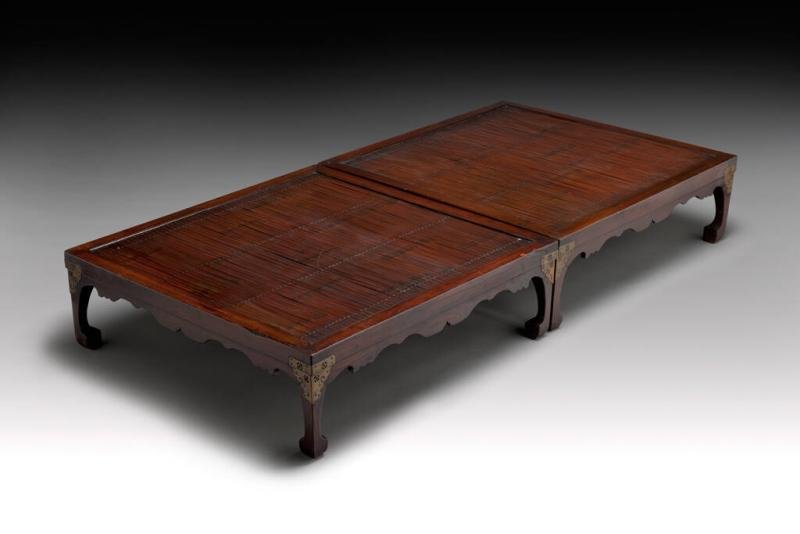
Zelkova frame, bamboo slats, brass fittings. Date: 1800s
H. 31,75cm, W. 198,12cm, D. 94cm.
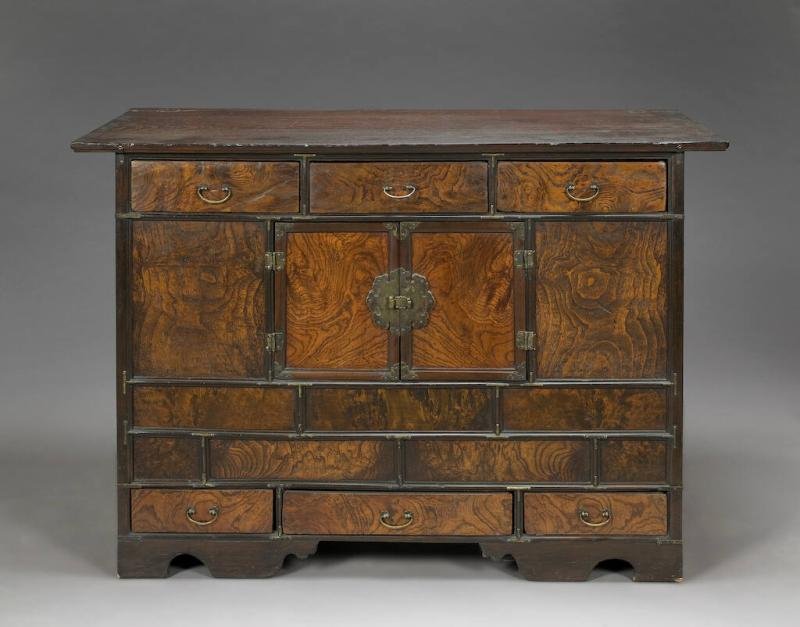
Zelkova, pine, and paulownia woods, brass fittings
H. 78,7cm, W. 111,7cm, D. 47cm.
DATE 1800s
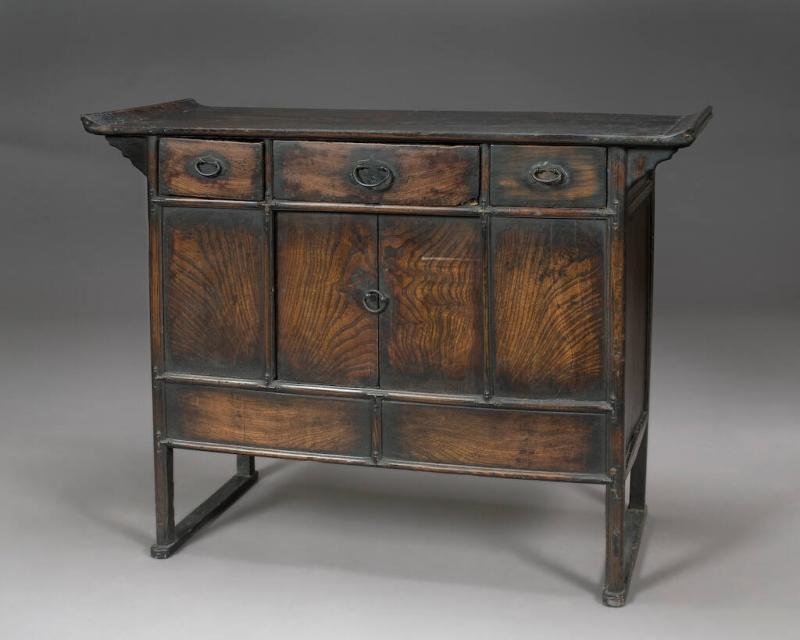
Zelkova wood, iron fittings
H. 71cm, W. 92,7cm, D. 42cm.
DATE circa 1900

Persimmon wood with wrought iron fittings and oil finish
H. 90cm, W. 106,6cm, D. 45,7cm.
DATE 1800s
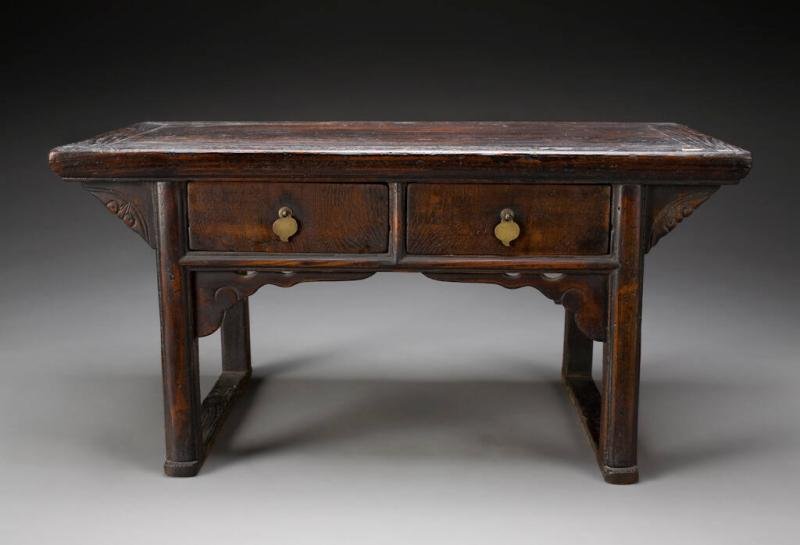
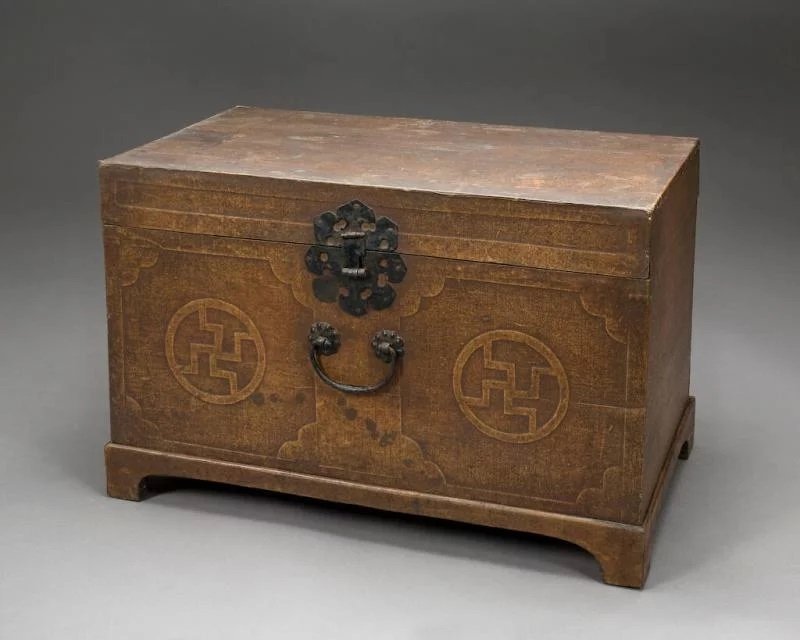
Paper on pine wood, iron fittings, oil finish
H. 38cm, W. 58,4cm, D. 33,6cm.
DATE 1900s
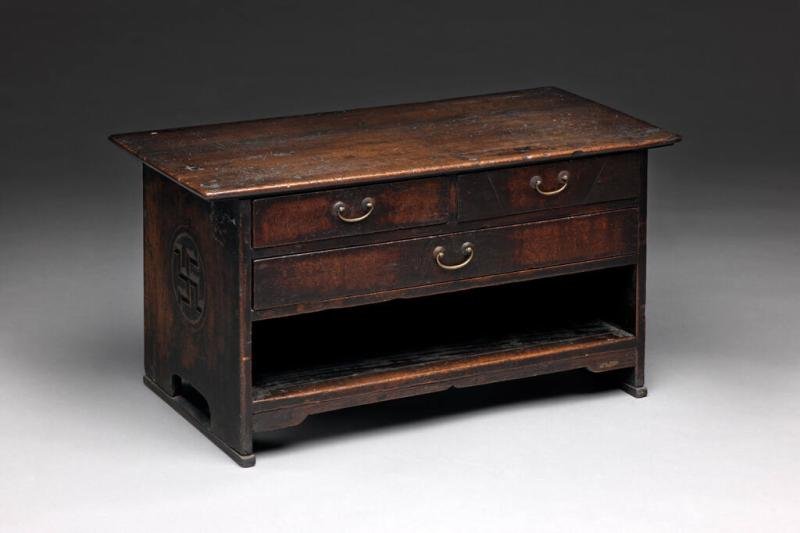
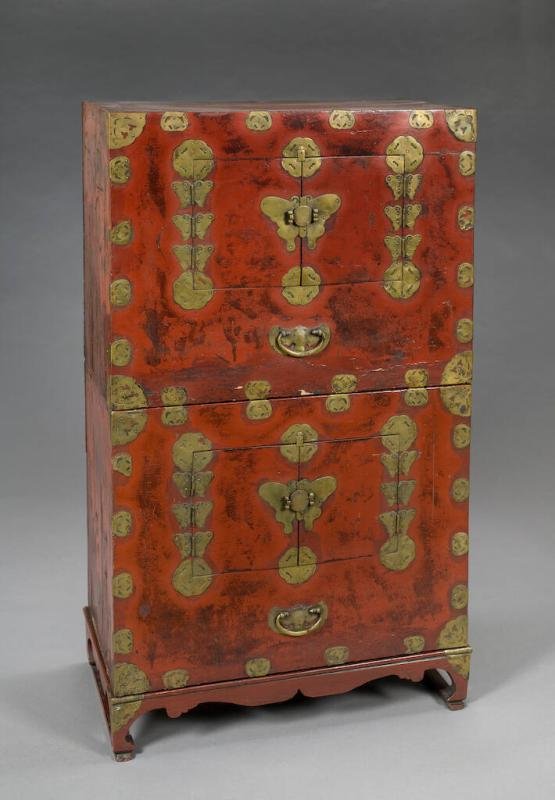
Pine wood, brass fittings, lacquer finish
H. 122cm, W. 69,8cm, D. 36,8cm.
DATE 1800s
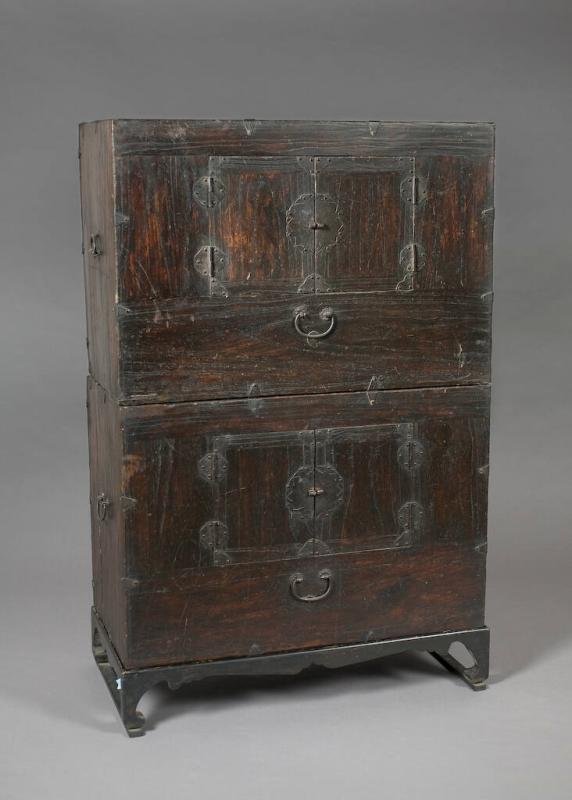
Paulownia and pine woods, wrought iron fittings
H. 120,6cm, W. 78,7cm, D. 38,7cm.
DATE 1800s
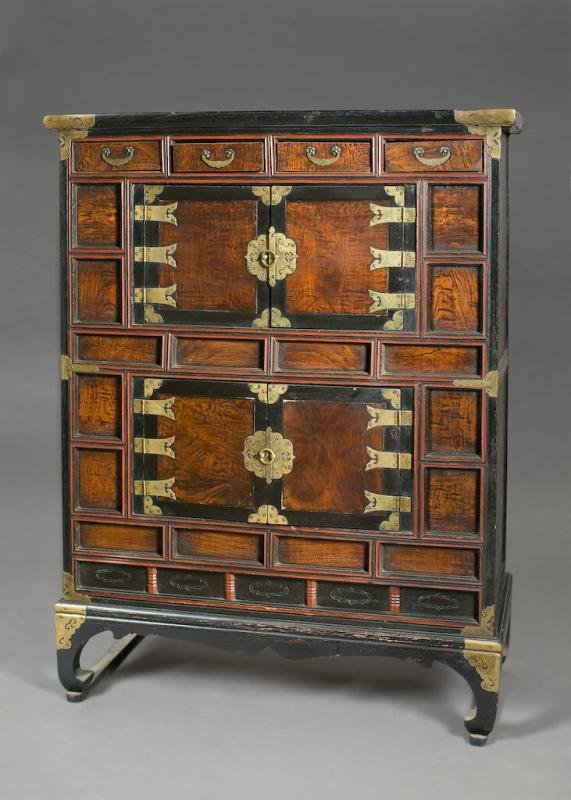
53 1/2 × 40 1/2 × 18 1/2 in.
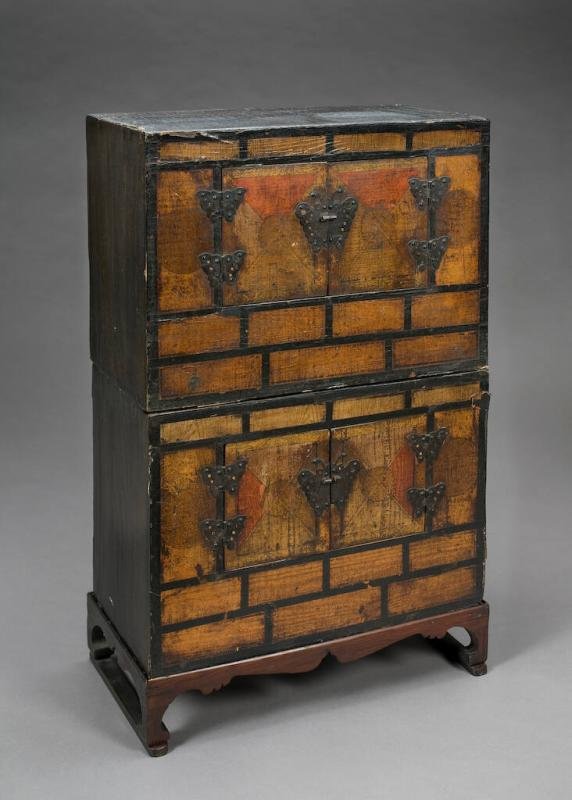
Colored paper on pine wood, iron fittings
H. 86,4cm, W. 52cm, D. 26cm.
DATE after 1910
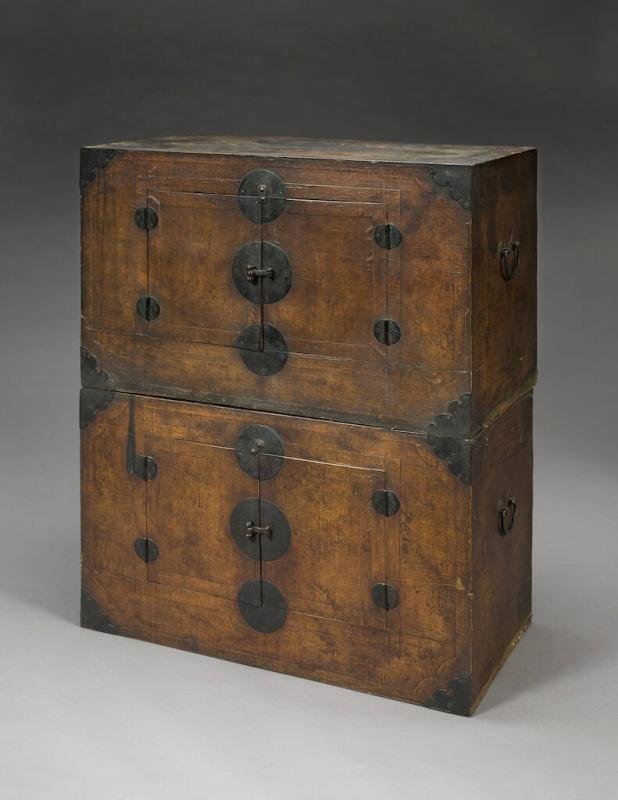
Oiled paper, pine, iron fittings
H. 85cm, W. 70cm, D. 37cm.
DATE circa 1900
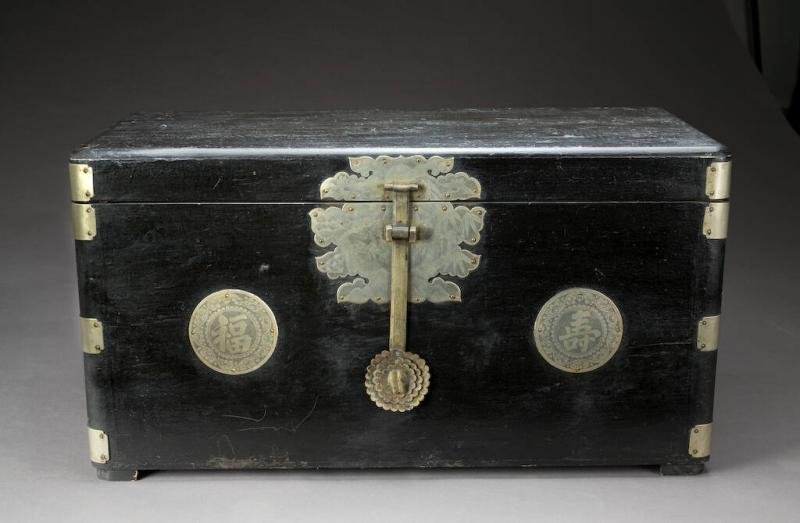
Wood, nickel fittings, lacquer finish
H. 43,2cm, W. 82,5cm, D. 39,3cm. DATE 1850-early 1900s

Pine wood, brass fittings
H. 115,5cm, W. 73,6cm, D. 35,5cm.
DATE 1960s
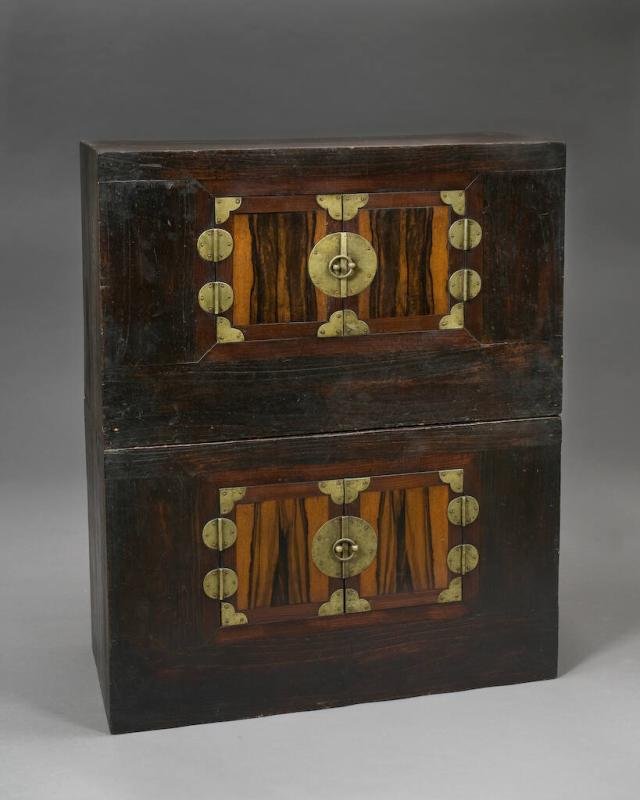
Paulownia, pine, and persimmon woods with yellow brass fittings.
H. 97,8cm, W. 80cm, D. 36cm.
DATE mid-1900s
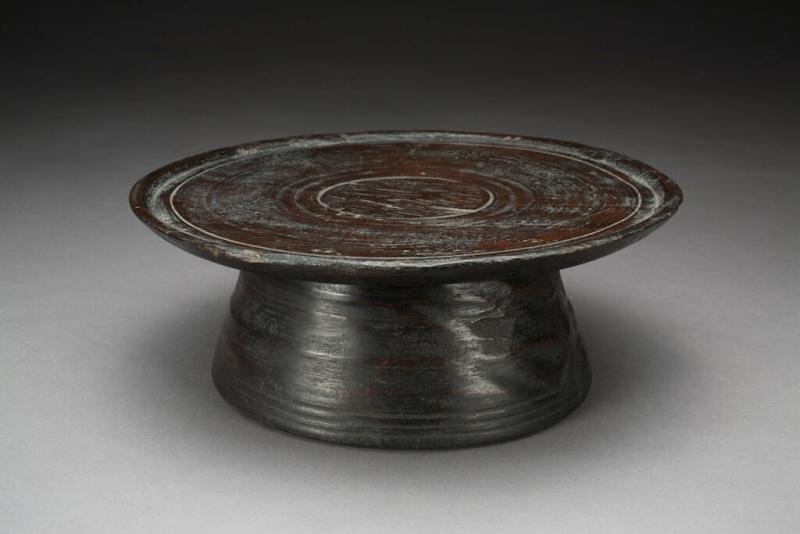
Chestnut wood with oil finish
H. 14cm, W. 43,8cm.
DATE circa 1900
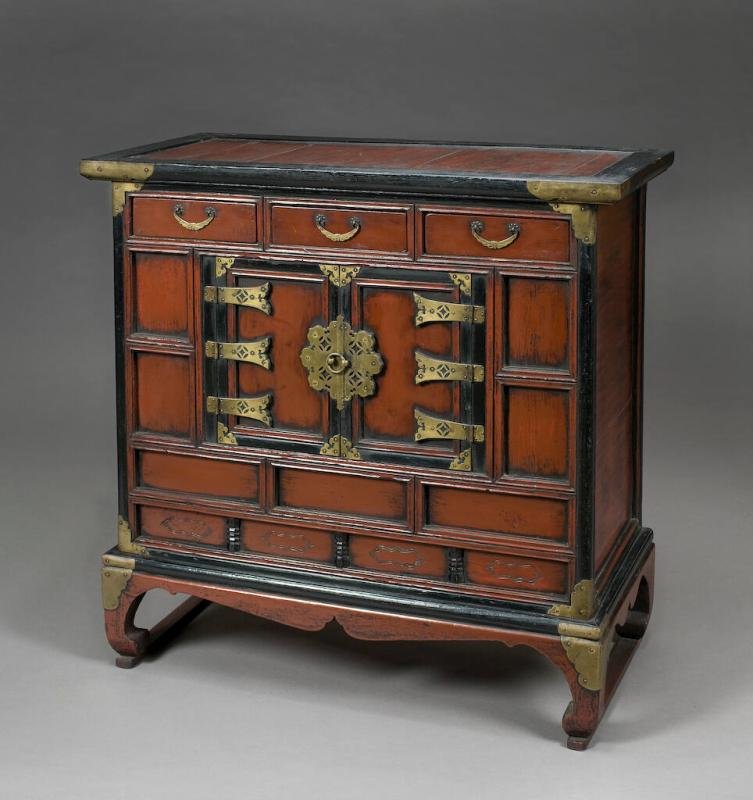
Paulownia and pine woods with lacquer finish, brass fittings
H. 89cm, W. 90cm, D. 45cm.
DATE 1800s

Pine wood with lacquer
H. 48,8cm, W. 47cm, D. 30,5cm.
DATE 1800s

Black lacquer on wood with gloss finish
H. 125,7cm, W. 65,7cm, D. 38cm.
DATE 1700s
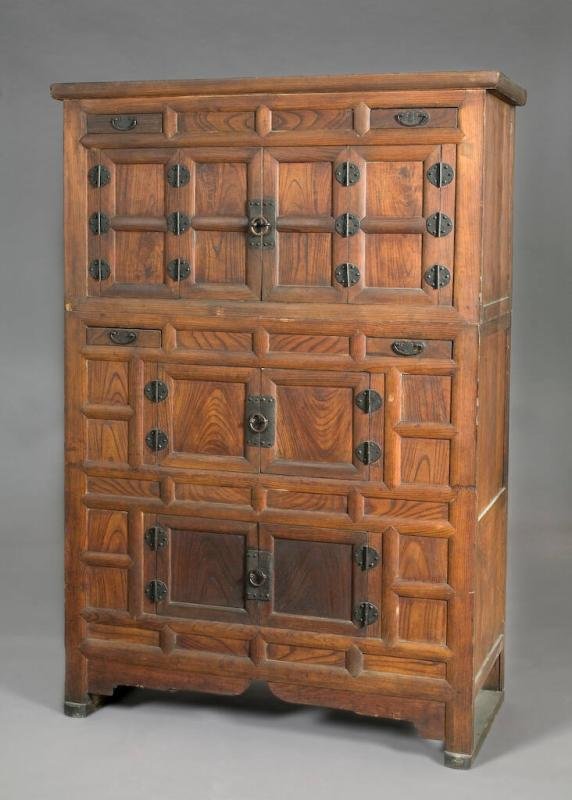
Zelkova and pine woods with cast iron fittings
H. 165cm, W. 113cm, D. 48cm.
DATE circa 1900
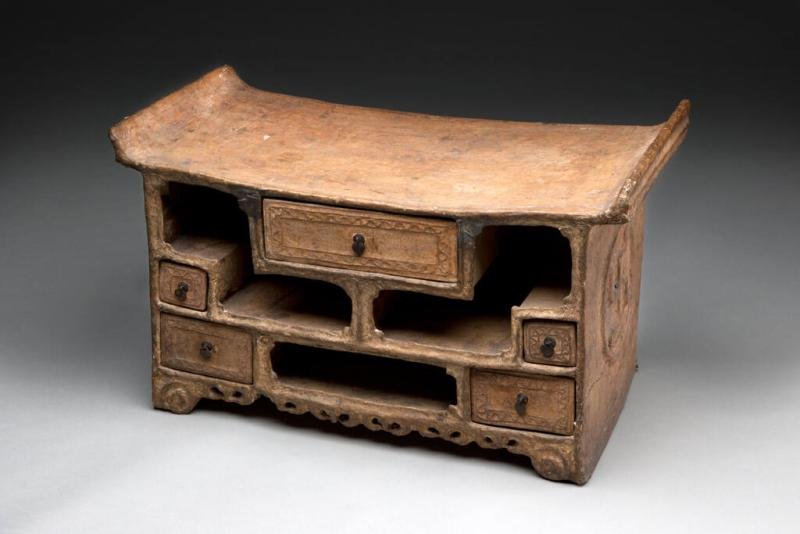
Paper over wood, brass fittings
H. 44,4cm, W. 73,6cm, D. 39,3cm.
DATE 1800s
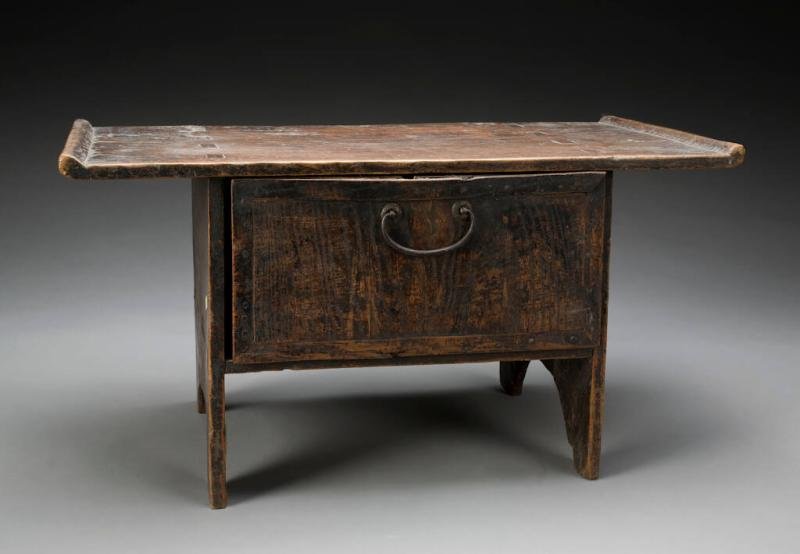
Pine and paulownia wood, cast iron fittings
H. 29,2cm, W. 55,8cm, D. 29,2cm.
DATE 1800s
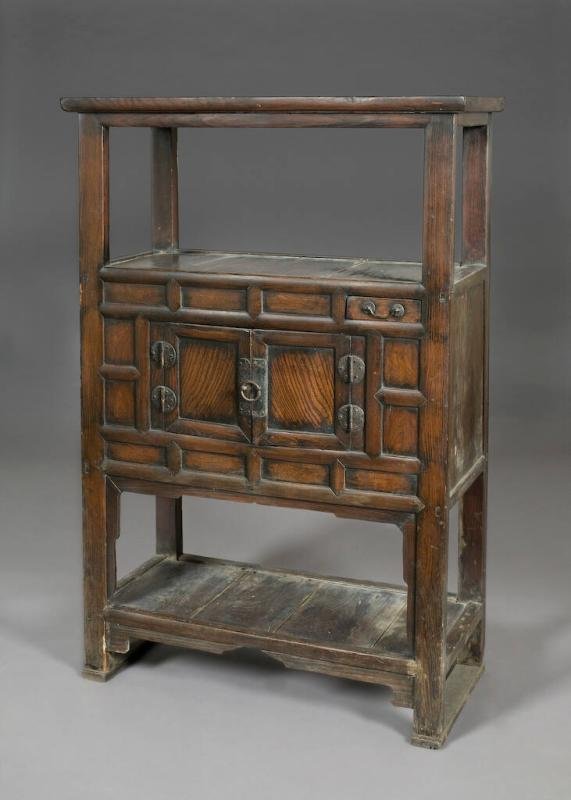
Zelkova panels, pine frame, cast-iron fittings
H. 134cm, W. 89,5cm, D. 40,6cm.
DATE 1800s
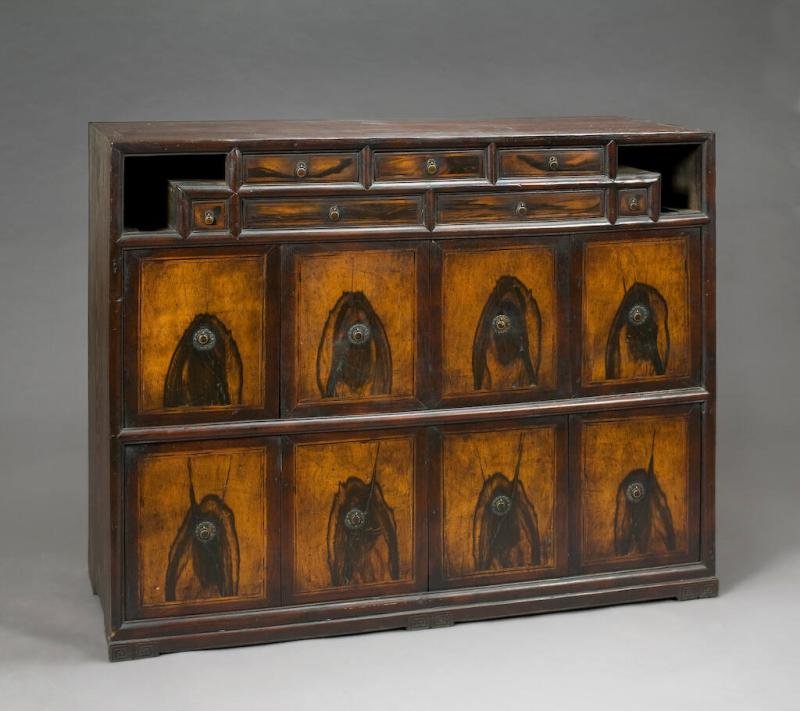
Persimmon doors and drawers marquetry, zelkova molding, pine
H. 94cm, W. 118cm, D. 43cm.
DATE 1900s

Persimmon and pine woods with wrought iron and nickel fittings and oil finish
H. 91,4cm, W. 98cm, D. 48cm.
DATE 1800s
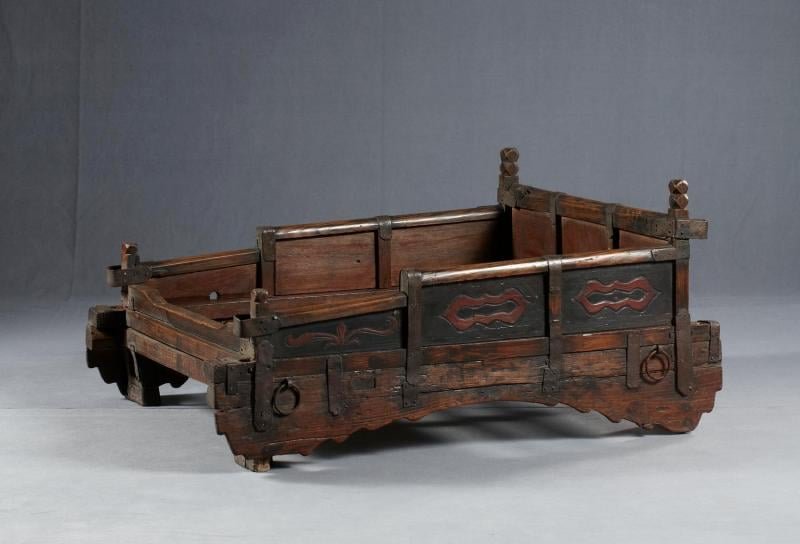
wood, metal
H. 44,7cm, W. 94cm, D. 70cm.
DATE 1800s-1900s

H. 23,5cm, W. 66cm, D. 36cm.
DATE: circa 1900
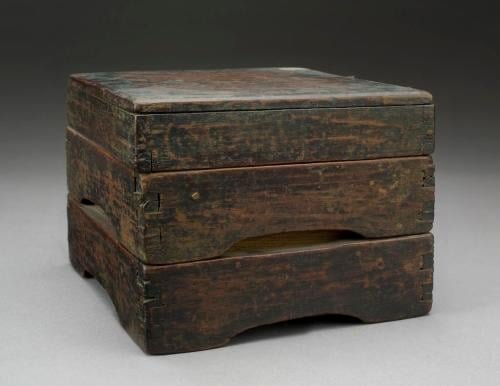
pine and bamboo woods
H. 9cm, W. 19cm, D. 19cm.
DATE 1800s
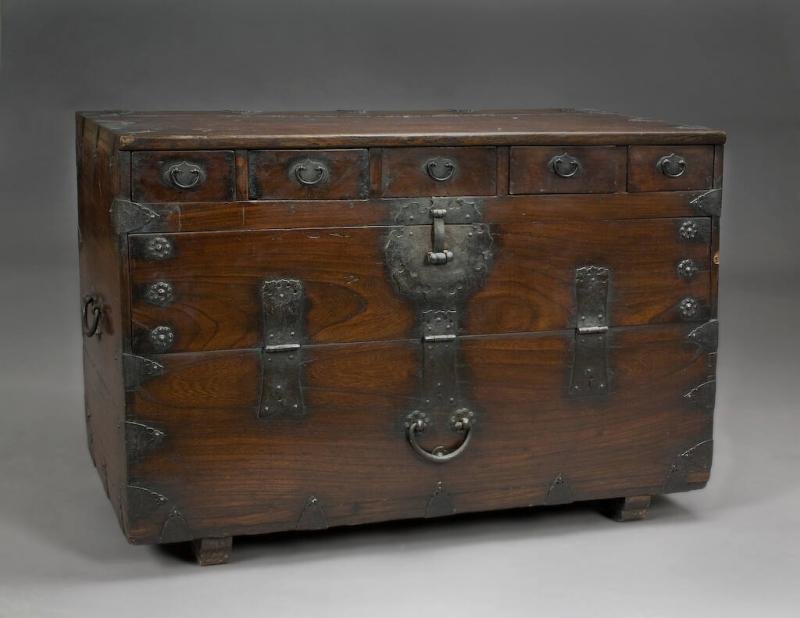
Zelkova and pine wood, iron fittings.
H. 66cm, W. 102cm, D 43cm.
Dated 1800s
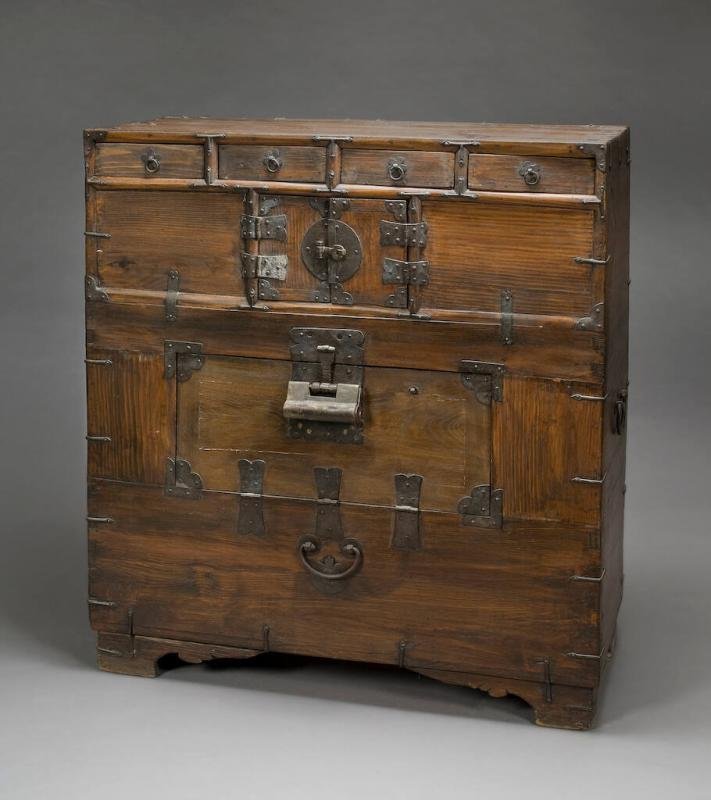
Zelkova, pine and other woods. Iron fittings.
H. 98cm, W. 89cm, D. 41cm.
Dated 20th century.
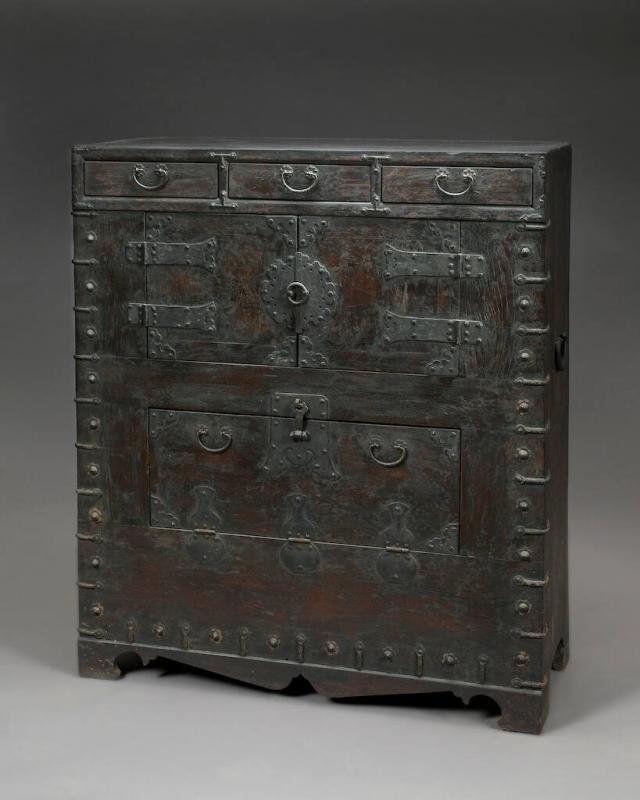
Zelkova, pine woods. Iron fittings. H. 102cm, W. 89cm, D. 39,7cm. Dated 1960s

Pine wood, brass fittings,
oil finish. 1800s.
H. 19cm, W. 43cm, D. 43cm.
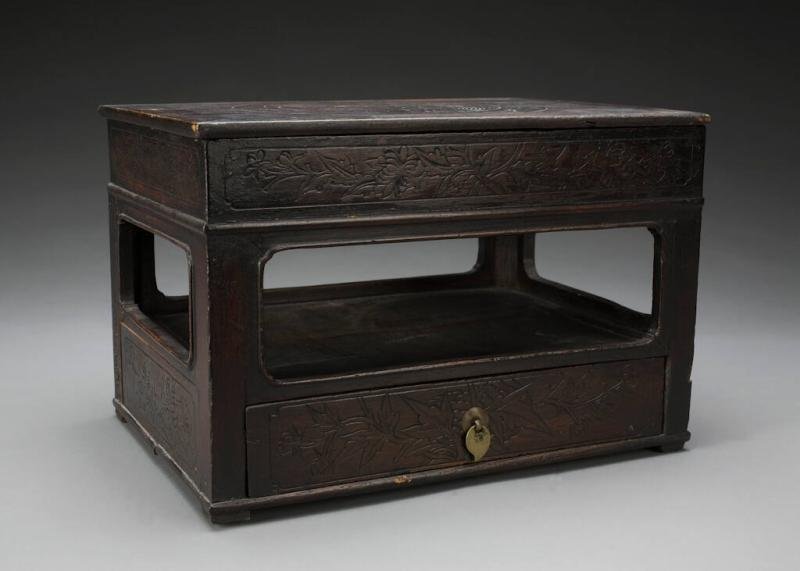
Recycle pine, brass fittings, oil finish. Dated after 1970.
H. 23cm, W. 25cm, D. 35cm.

Persimmon and pine wood, brass fittings, oil finish.
H. 27cm, W. 36cm, D. 25cm.
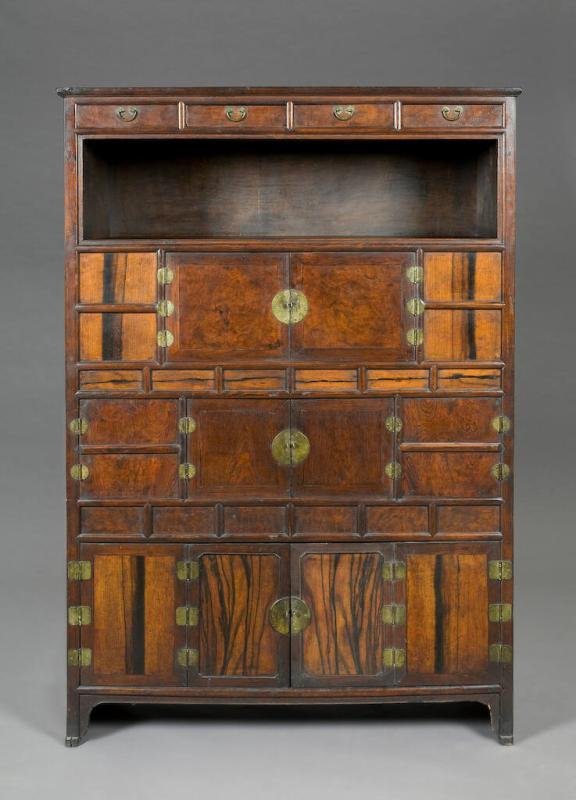
Persimmon, red oak and pine woods, Yellow brass fittings.
Date 1960 -1967.

Pine, persimmon and other woods. Iron fittings.
H. 95,5cm, W. 109cm, D. 48cm.
Date. 1800s

Basswood and pine wood. Brass fittings and oil finish.
H. 85cm, W. 88cm, D. 43,18cm.
Date. 1800s
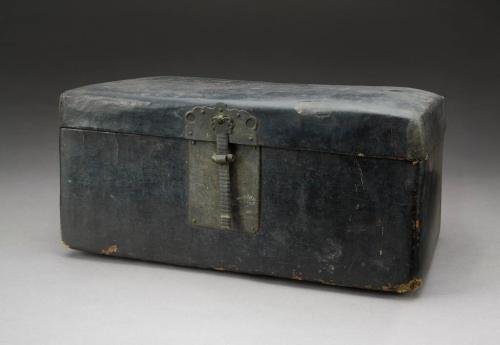
Date 1800s. H. 17,8cm, W. 38cm, D. 20,95cm.

H. 42cm, W. 76,2cm, D. 39,3cm.
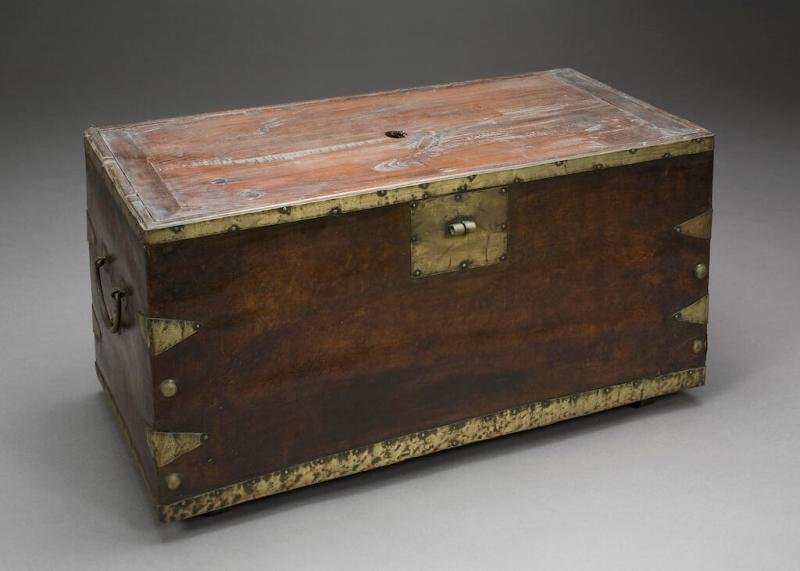

H. 37,5cm, W. 52cm, D. 26cm.
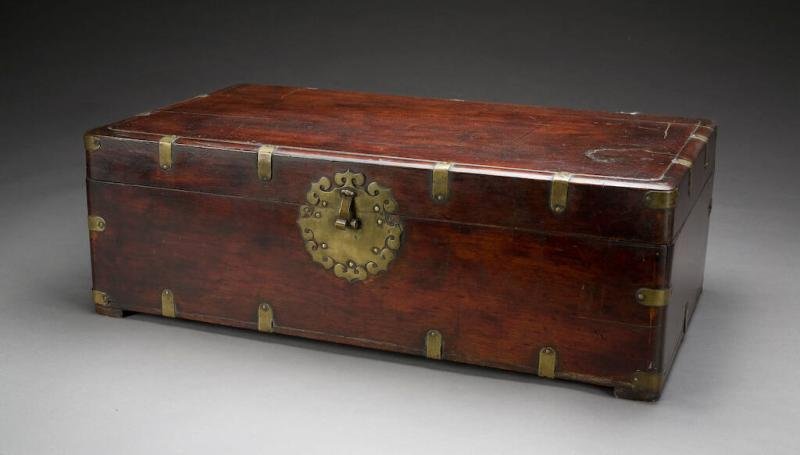
Date 1970s.
H. 22,8cm, W. 68,5cm, D. 38,7cm.
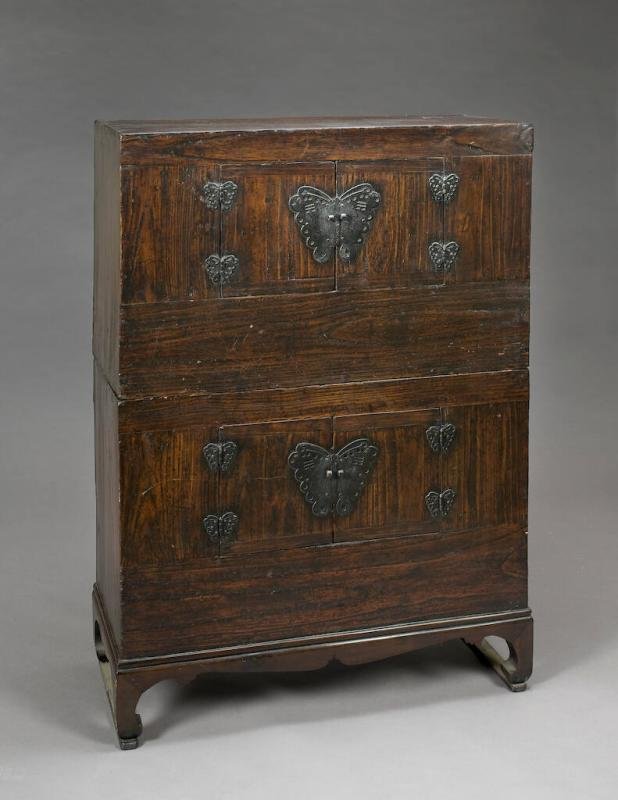
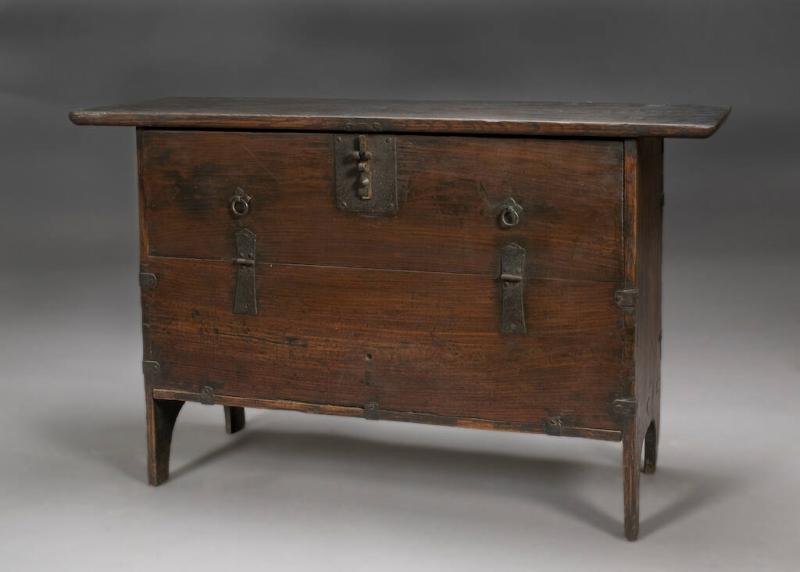
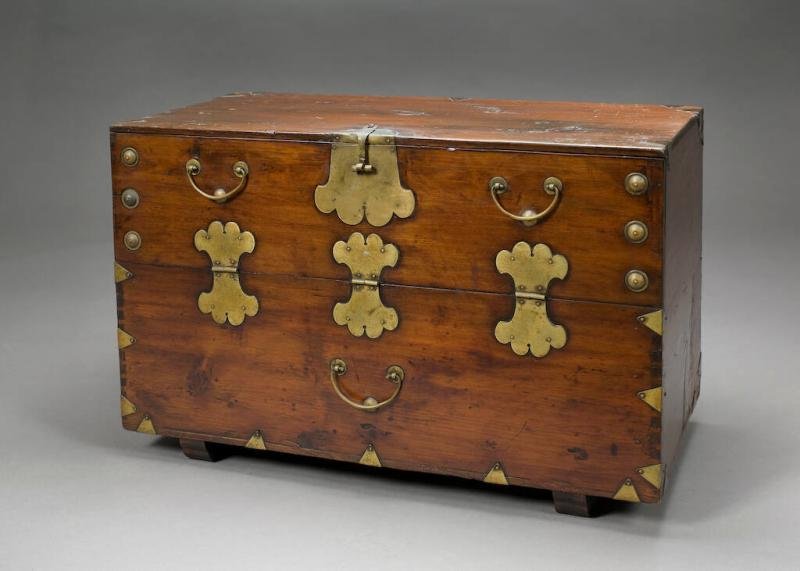
H. 48cm, W. 71cm, D. 35,5cm.

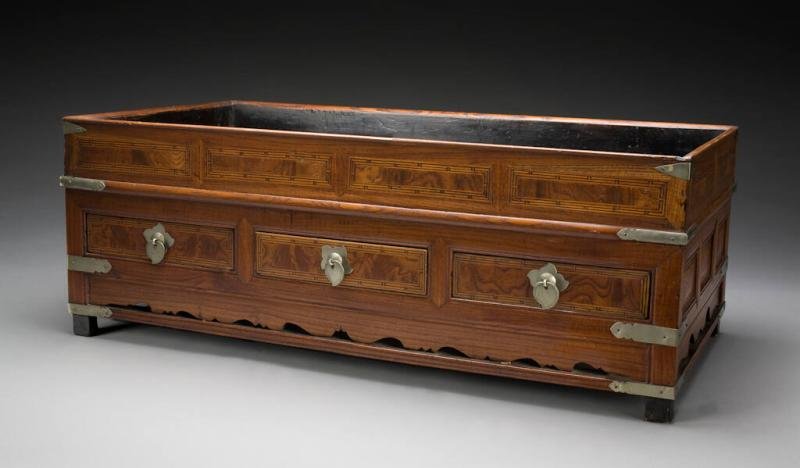
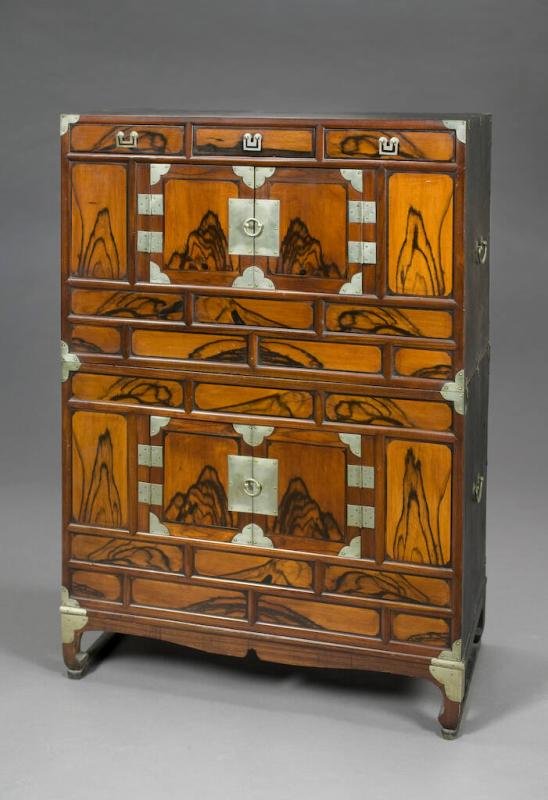
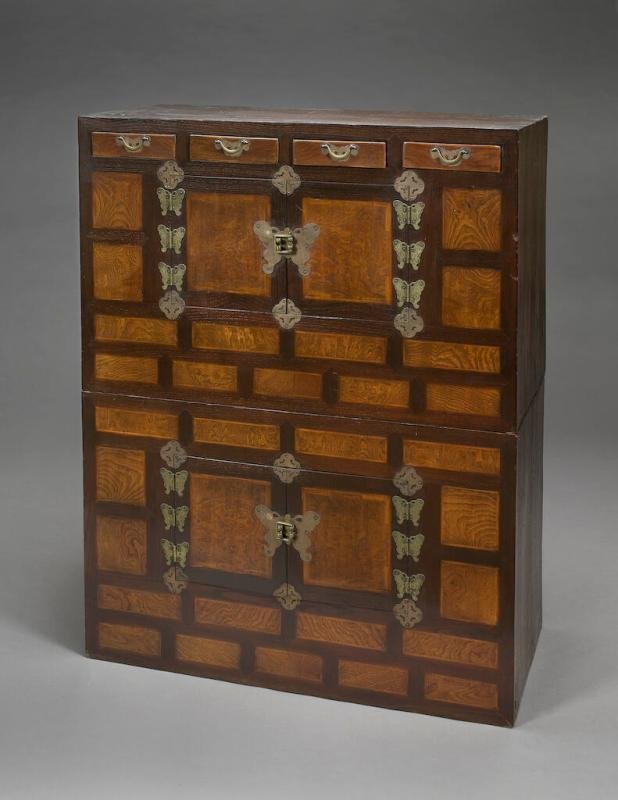
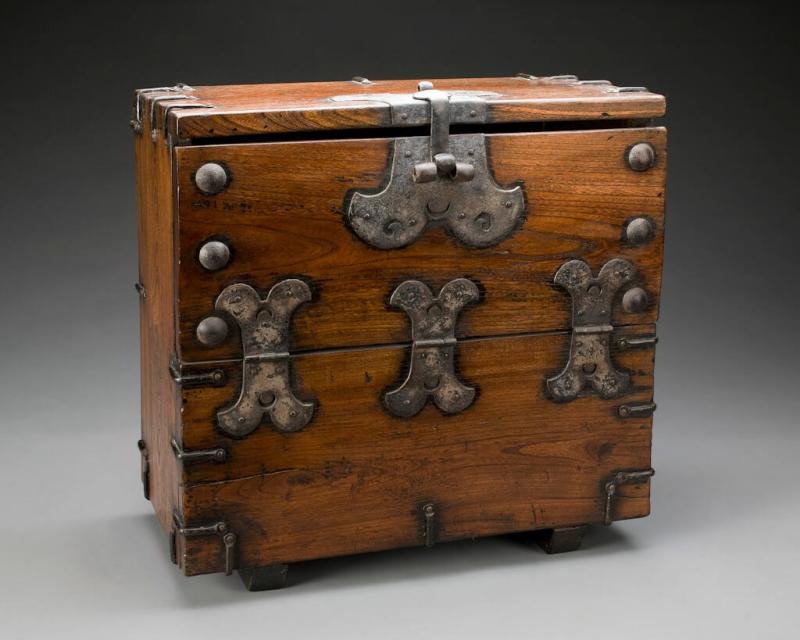
H. 52cm, W. 50cm, D. 25,4cm.
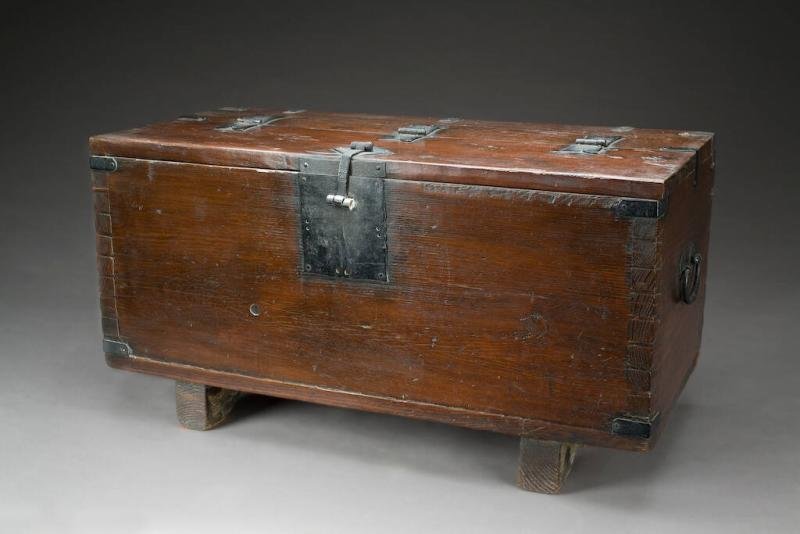
16 × 30 1/4 × 14 1/4 in.

6 1/2 × 14 3/4 × 6 1/2 in.
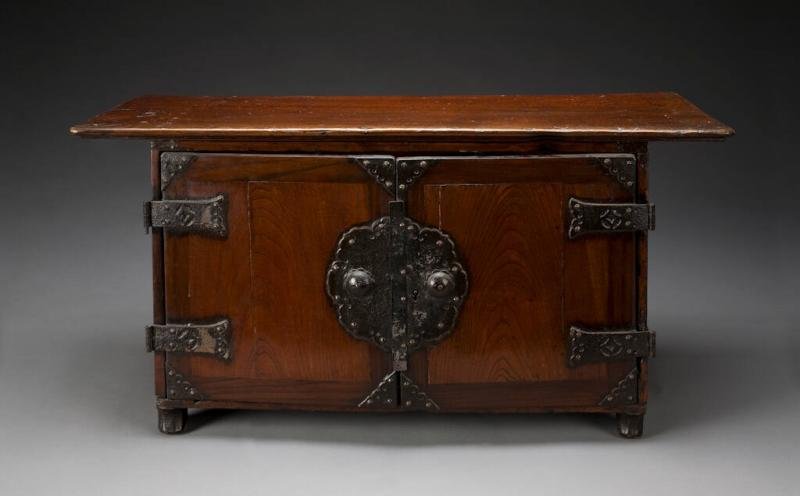
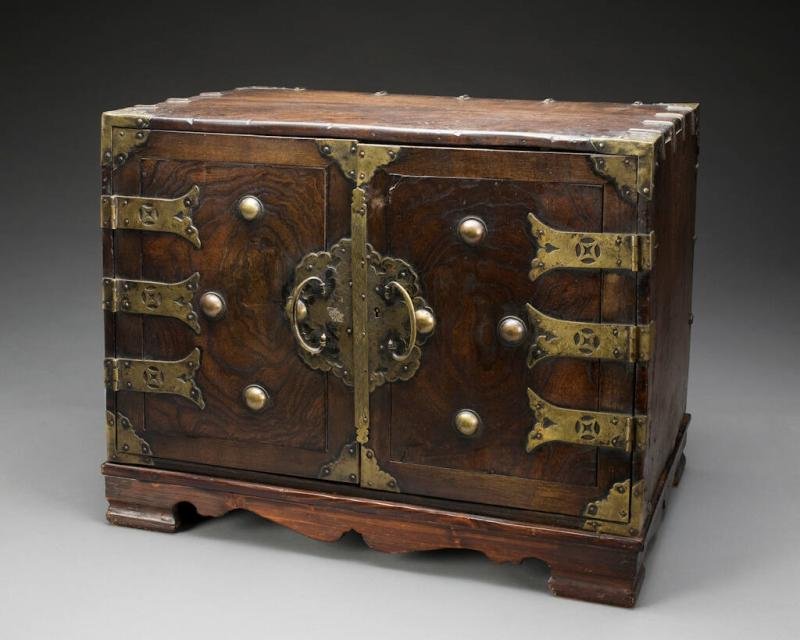

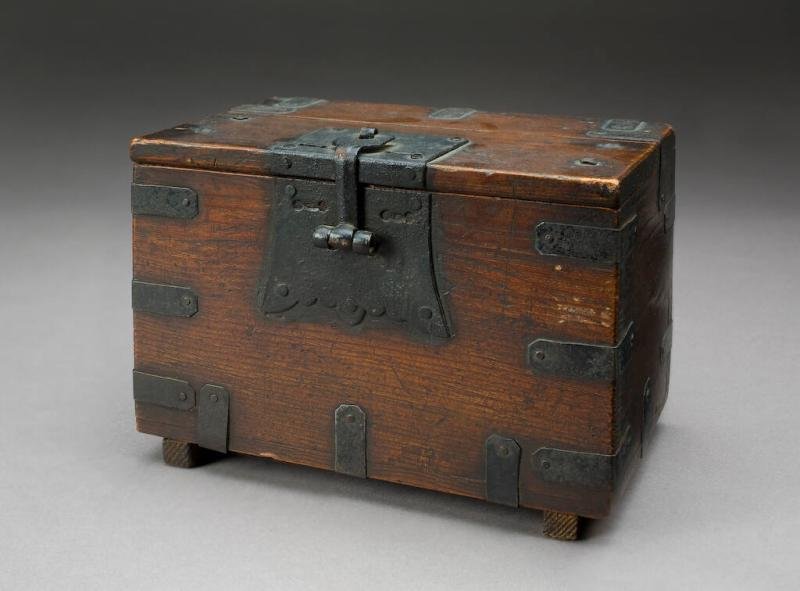
5 1/2 × 8 × 5 in.
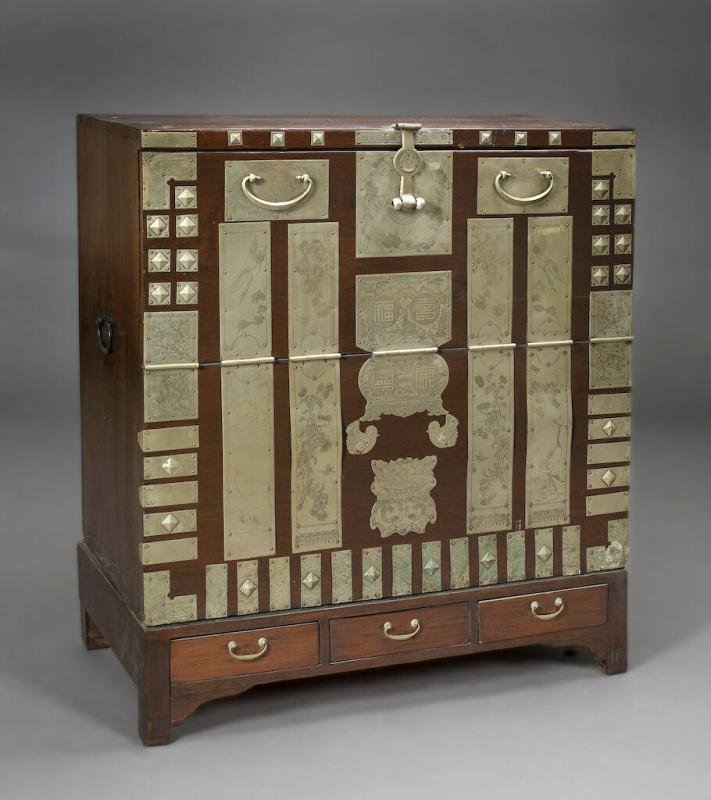
40 1/2 × 35 1/2 × 18 in.
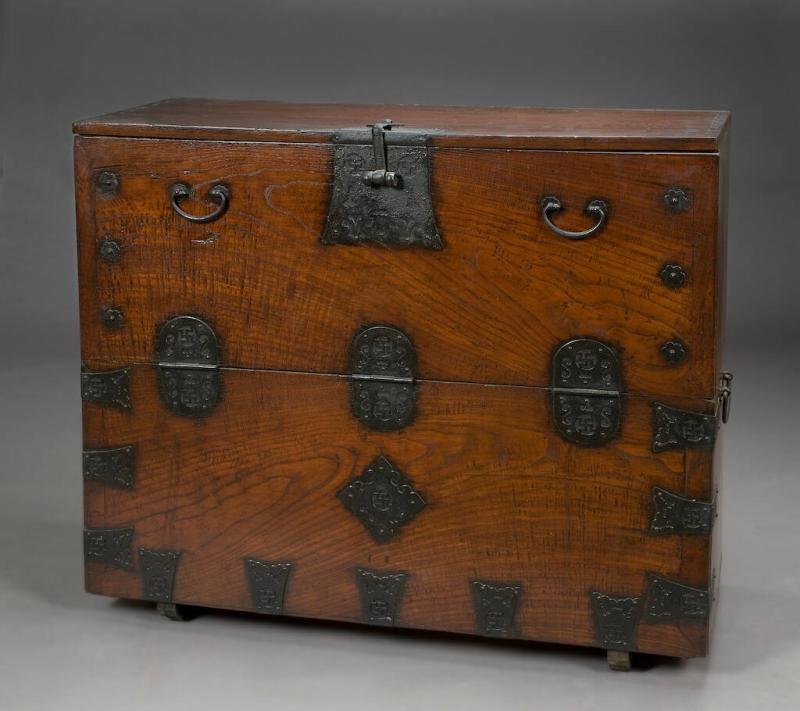
34 1/2 × 41 1/2 × 17 in.

21 × 48 1/2 × 23 in.


9 1/2 × 14 × 6 in.




Ginkgo and pine woods with oil finish.
10 × 18 3/4 × 14 1/4 in.


Persimmon and paulownia woods with wrought iron fittings. 31 1/2 × 41 × 17 1/4 in.

DATE 1800s
Zelkova and pine woods with cast-iron fittings, oil finish.
20 × 22 1/2 × 16 1/2 in.

DATE 1800s
Zelkova and pine woods with iron fittings, oil finish.
31 1/2 × 34 × 23 in.

15 × 30 1/2 × 14 1/2 in.

Zelkova and pine woods, brass fittings, oil finish.
12 × 32 × 12 1/2 in.


Pine wood, iron fittings. 23 1/2 × 32 1/2 × 14 in.

26 1/2 × 36 × 17 1/2 in.

Ginkgo and pine woods. 16 × 20 × 15 in.

DATE 1800s
Zelkova and pine woods with cast iron fittings, oil finish.
25 × 27 1/2 × 21 in.

DATE 20th century
Ginkgo wood. 11 1/2 × 16 1/2 × 14 in.

Linden wood. 11 × 18 3/4 in.

DATE circa 1950
Black lacquer on wood, mother-of-pearl, ox horn. 10 × 23 1/2 × 17 1/2 in.
LACMA – Los Angeles County Museum of Art.
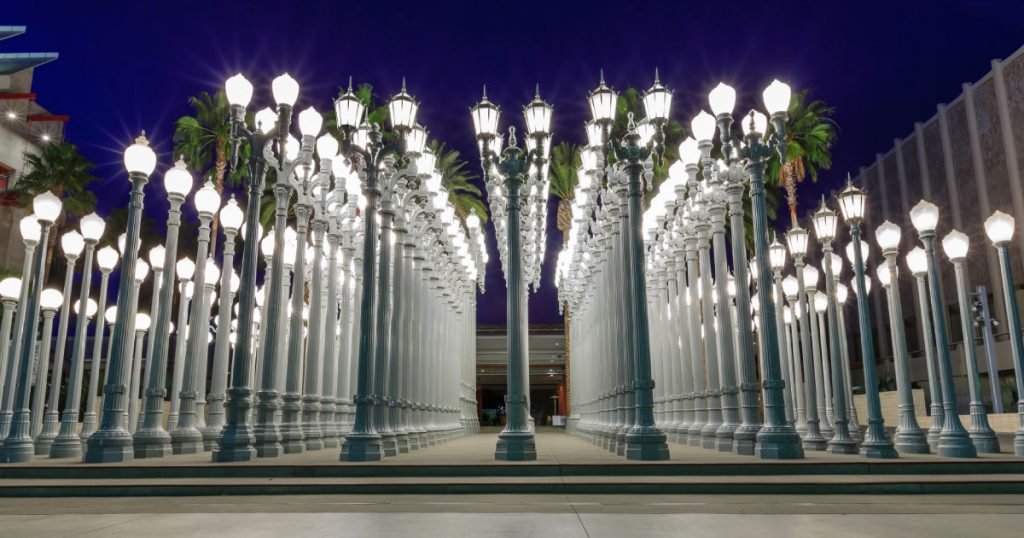
“LACMA” known as the Los Angeles County Museum of Art has the largest Korean art galleries of any museum in the United States. The collection include mainly Korean paintings, ceramics, textiles, and Buddhist art. However some Korean furniture and wooden Works of Art are also featured in the collection.
The Korean art galleries have been closed to the public on July 28, 2019 for collection inventory and packing. This work is in preparation for the construction of the new proposed building for the permanent collection, which is expected to open by the end of 2023.

Shark skin on wood core with hammered, cut, and cast iron fittings with silver wire inlay
15 x 11 x 11 in. (38.1 x 27.94 x 27.94 cm)

Carved wood with lacquer
Korea, Joseon dynasty (1392-1910), 19th century
H. 10,16cm, W. 20cm, D. 12,38 cm.
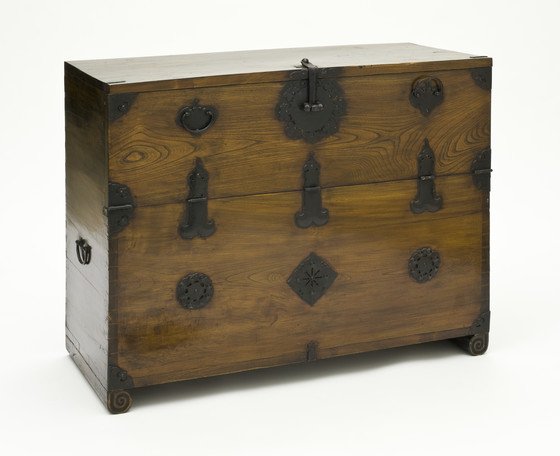
Korea, Joseon dynasty (1392-1910), 19th century
H. 85,73cm, W. 106,68cm, D. 46,04cm

Red lacquer on wood core with green, orange, and yellow painted decoration and brass fittings
Korea, Joseon dynasty (1392-1910), 19th century
H. 139,7cm, W. 109,22cm, D. 61,6 cm.
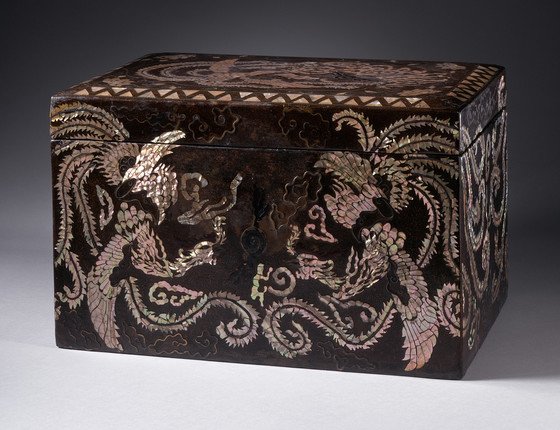
Brown lacquer on wood core with mother-of-pearl, brass wire inlay, and metal fittings
Korea, Joseon dynasty (1392-1910), 18th century.
H. 22,86cm, W. 36,83cm, D. 22,23 cm.

Brown lacquer on wood core with mother-of-pearl inlay and brass fittings
Korea, Joseon dynasty (1392-1910), 19th century
H. 14,61cm, W. 47cm, D. 13,34 cm.

Burl wood veneer on wood core with brass fittings.
Korea, Joseon dynasty (1392-1910), 18th century
H. 7,6cm, W. 35,5cm, D. 12,7 cm.
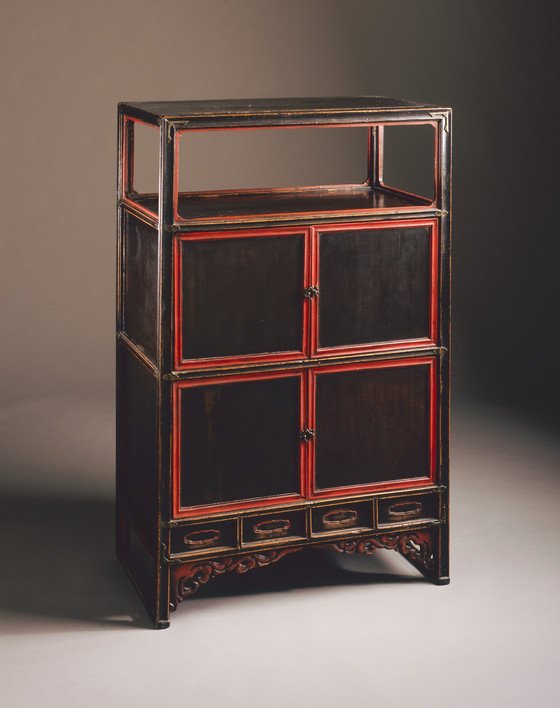
Carved wood with red and black lacquer and brass fittings
Korea, Joseon dynasty (1392-1910), 18th century
H. 105,41cm, W. 66,04cm, D. 39,37cm.
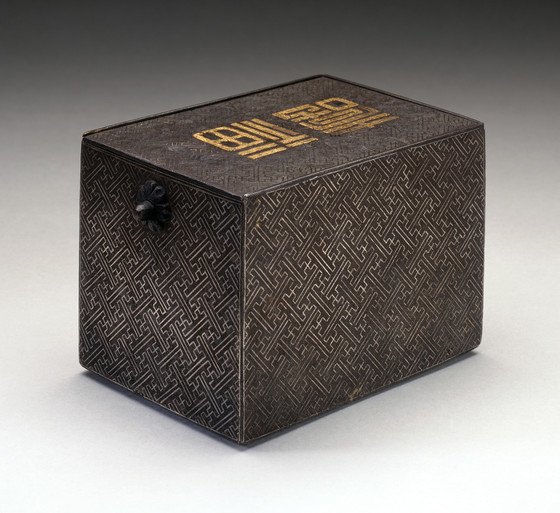
Cast iron with silver wire inlay.
Korea, Joseon dynasty (1392-1910), 19th century.
H. 6,03cm, W. 7,94cm, D. 6,35 cm.
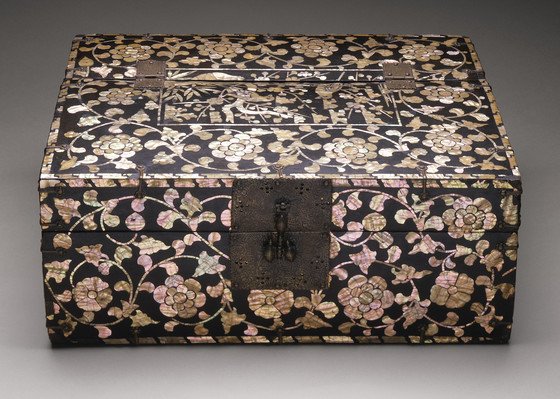
Brown lacquer on wood core with mother-of-pearl inlay and brass fittings
Korea, Joseon dynasty, 1392-1910, 18th century
H. 17,78cm, W. 45,72cm, D. 35,56 cm.
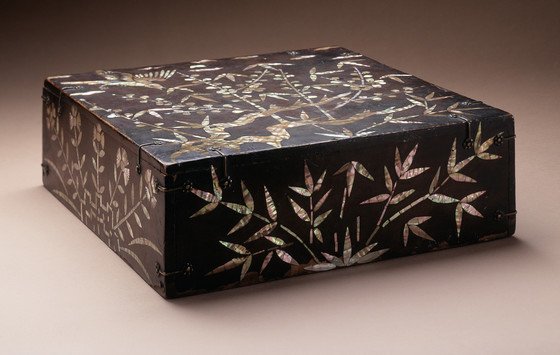
Brown lacquer on wood core with mother-of-pearl inlay and brass fittings
Korea, Joseon dynasty (1392-1910), 18th century
H. 8,89cm, W. 27,94cm, D. 27,94 cm.

Carved wood with red lacquer, gilding, and Chinese silk gauze
Korea, Joseon dynasty (1392-1910), 18th century
H. 90,50cm, W. 27,94cm, D. 27,94 cm.
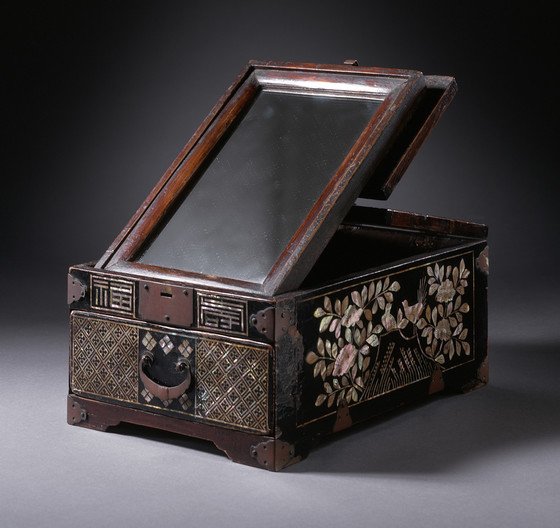
Brown lacquer on wood core with mother-of-pearl inlay, brass fittings, and silvered glass
Korea, Joseon dynasty (1392-1910), 19th century
H. 12,07cm, W. 26,35cm, D. 18,1 cm.

Reverse painted ox horn veneer on wood core with ivory inlay and brass fittings
Korea, Joseon dynasty (1392-1910),
19th century
H. 14,92cm, W. 22,23cm, D. 22,23 cm
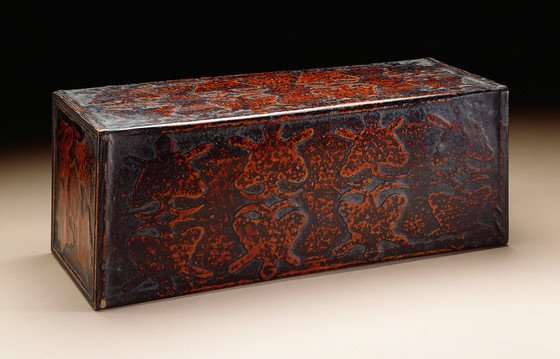
Paper maché on wood core
Korea, Joseon dynasty (1392-1910),
19th century
H. 13,02cm, W. 35,24cm, D. 13,02cm.
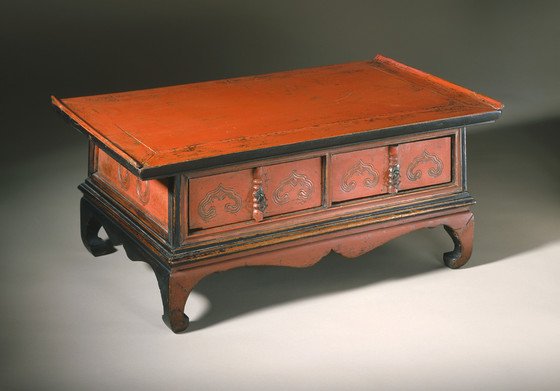
Carved wood with red lacquer and brass fittings
Korea, Joseon dynasty (1392-1910),
19th century
H. 31,11cm, W. 78,74cm, D. 46,35 cm.

Red and black lacquer on wood core with mother-of-pearl inlay
Korea, Joseon dynasty (1392-1910),
19th century
H. 16,51cm, W. 21,27cm
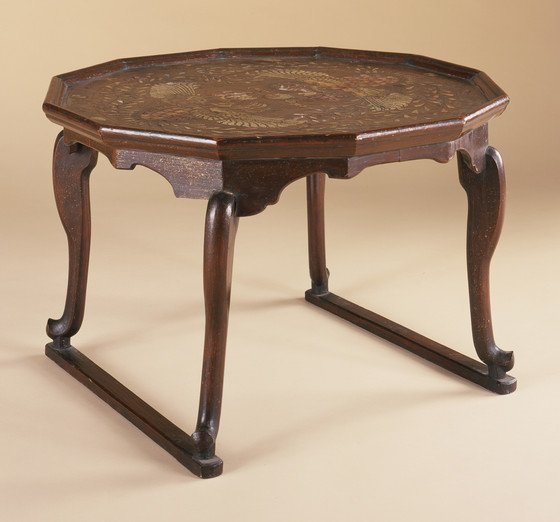
Brown lacquer on wood core with shark skin inlay and brass fittings
Korea, Korea, Joseon dynasty (1392-1910), early 20th century.
H. 38,42cm, 57,79cm x 57,79 cm.

Crushed mother-of-pearl over fabric on wood core
Korea, Early 20th century
H. 14,61cm, W. 31,43cm, D. 21,59 cm

Carved wood with metal fittings
Korea, Joseon dynasty (1392-1910), 18th century
H. 27,94cm, W. 58,42cm, D. 27,94cm
LINK: Korean collection at LACMA.
THE MET – The Metropolitan Museum of Art. New York.
Interesting links: Shell and Resin: Korean Mother-of-Pearl and Lacquer
https://www.metmuseum.org/exhibitions/listings/2015/korea
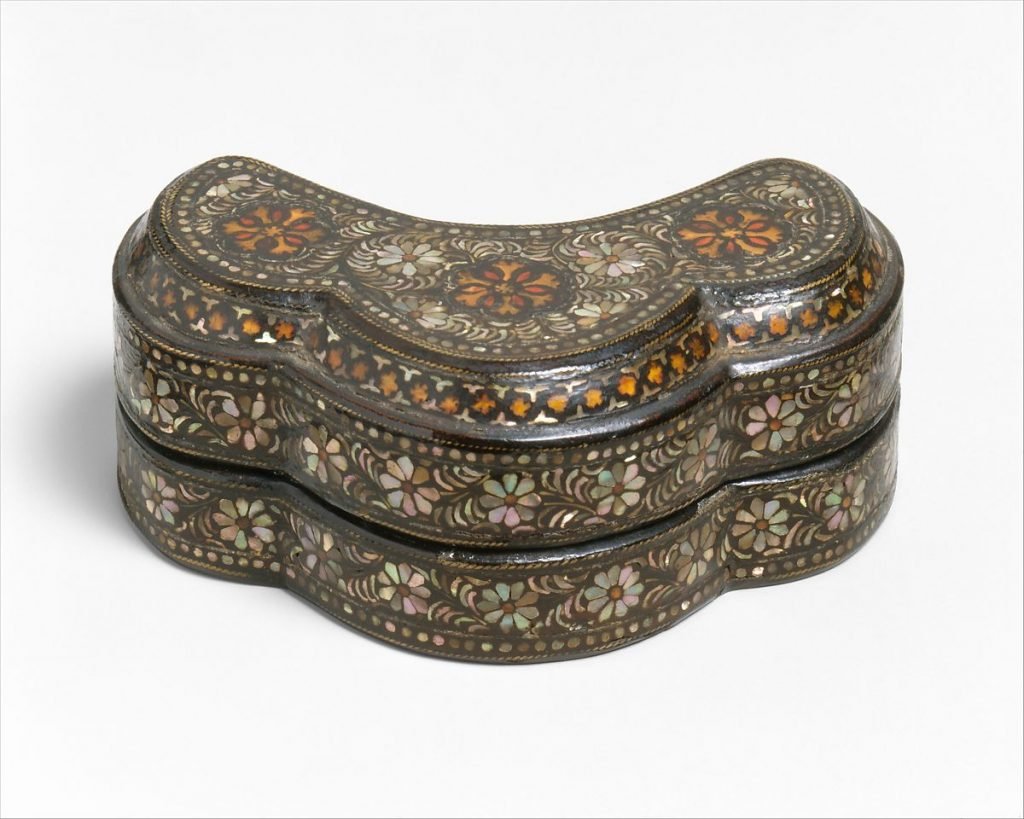
Lacquer inlaid with mother-of-pearl and tortoise shell over pigment and brass wire
Dimensions: H. 1 5/8 in. (4.1 cm); L. 4 in. (10.2 cm); D. 1 3/4 in. (4.4 cm)
Ceramics and metalwork of the Silla kingdom (57 B.C.–A.D. 935) and paintings, sculptures, ceramics, and lacquers of the Goryeo (918–1392) and Joseon (1392–1910) dynasties, together with thematic exhibitions featuring loans from collections in the United States and abroad, provide a comprehensive overview of Korea’s artistic and cultural heritage.
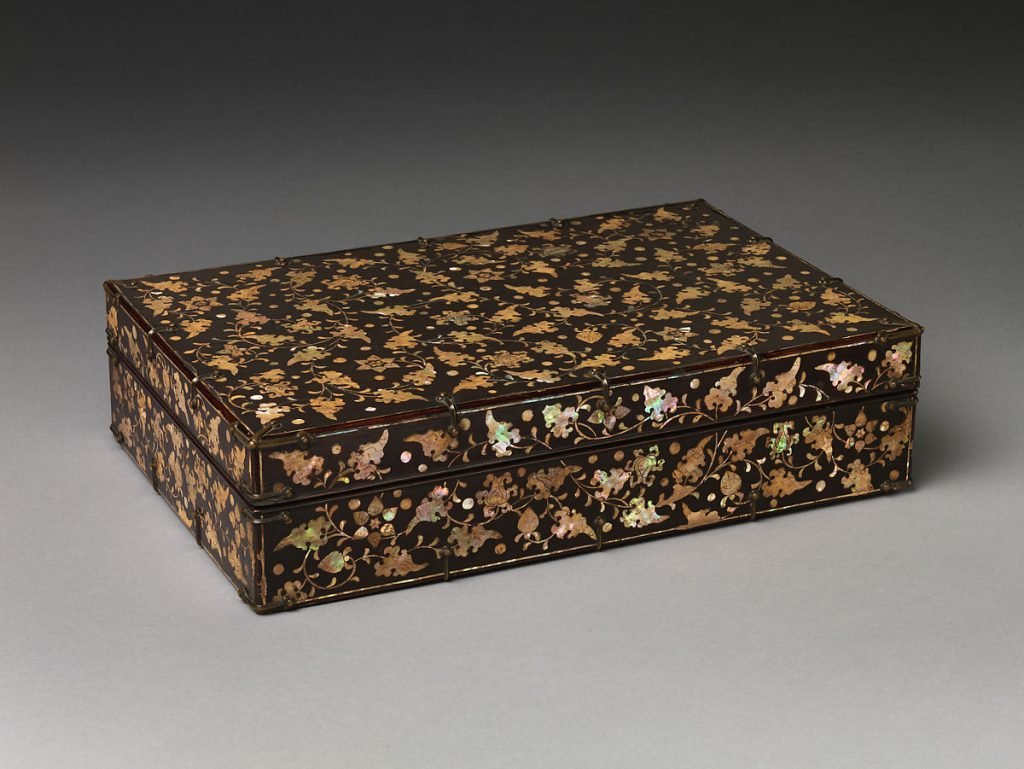
Lacquer inlaid with mother-of-pearl; brass fittings
Dimensions: H. 3 5/8 in. (9.2 cm); W. 9 1/2 in. (24.1 cm); L. 14 3/8 in. (36.5 cm)
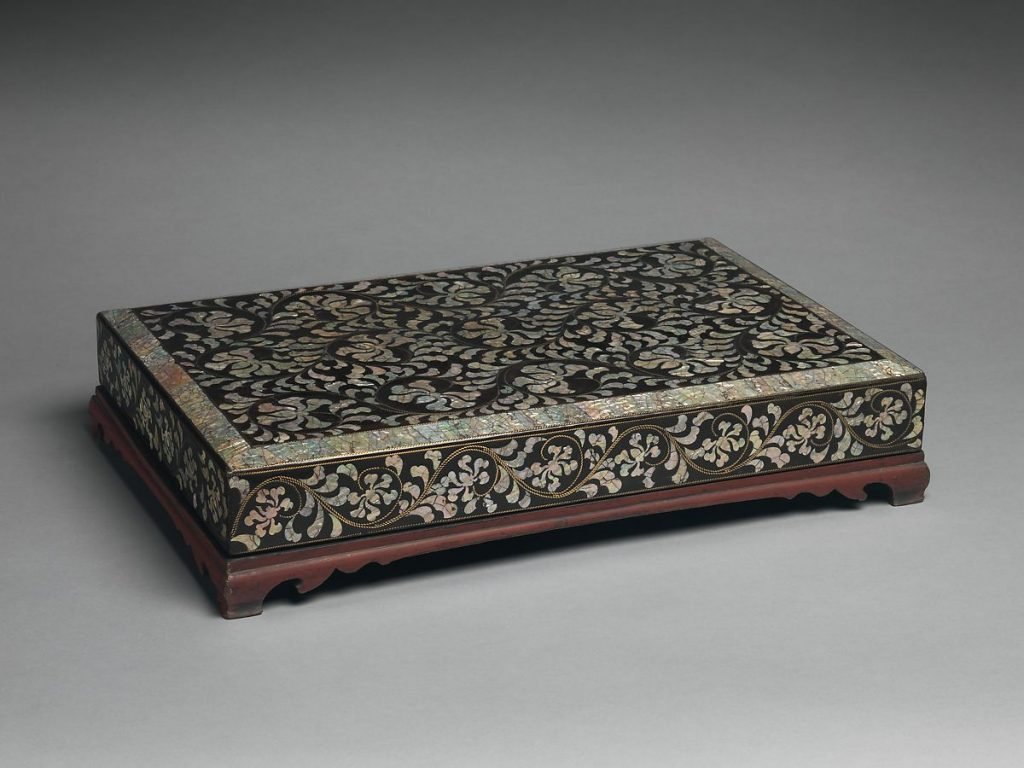
Lacquer inlaid with mother-of-pearl
Dimensions: H. 5 3/8 in. (13.7 cm); W. 15 in. (38.1 cm); L. 22 3/8 in. (56.8 cm)
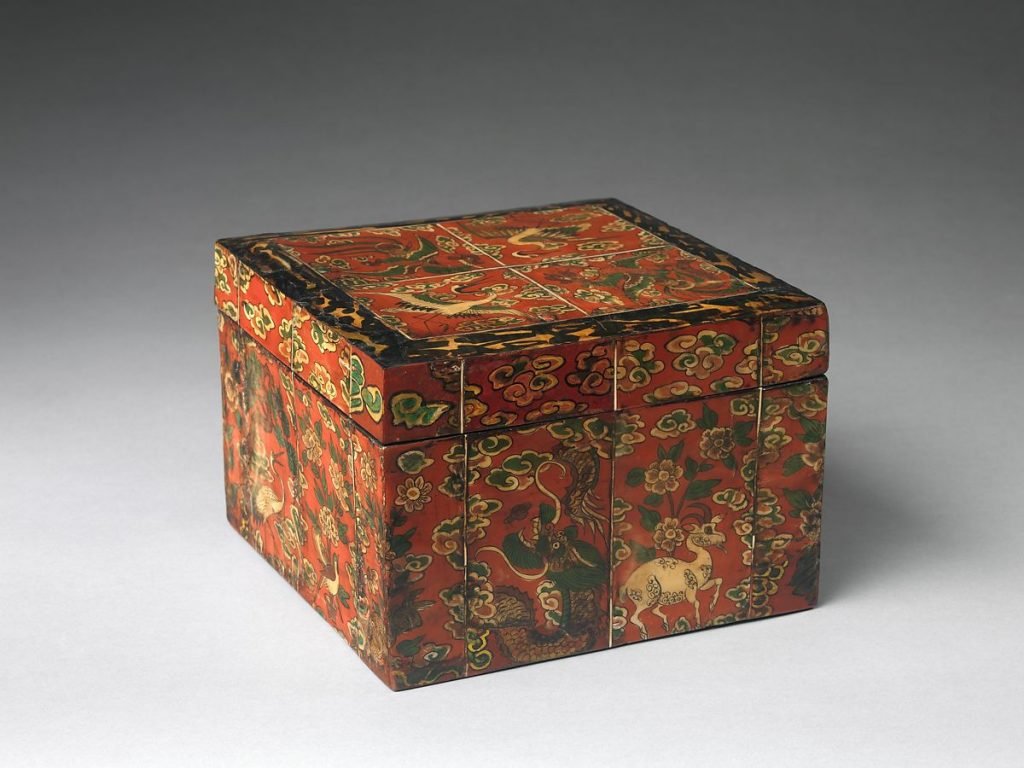
Dimensions: H. 6 in. (15.2 cm); W. 8 5/8 in. (21.9 cm); L. 8 5/8 in. (21.9 cm)

Lacquer inlaid with mother-of-pearl, tortoiseshell, and ray skin
Dimensions: H. 6 3/4 in. (17.1 cm); W. 17 3/4 in. (45.1 cm); L. 28 3/4 in. (73 cm)
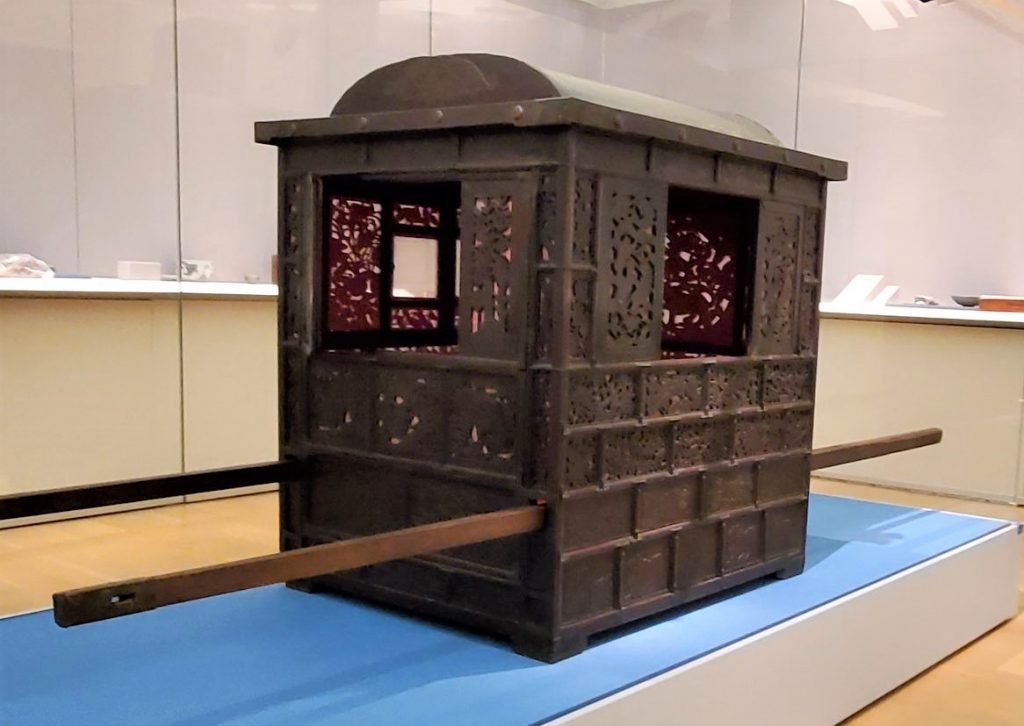
Rectangular housing (incl. domed top): 43 1/2 × 33 3/4 × 29 3/4 in., 88 lb. (110.5 × 85.7 × 75.6 cm)
Dims & weight of the poles (each): 1 1/8 in. × 8 ft. 9 5/8 in. × 1 1/2 in., 7 lb. (2.9 × 268.3 × 3.8 cm, 3175.179g)
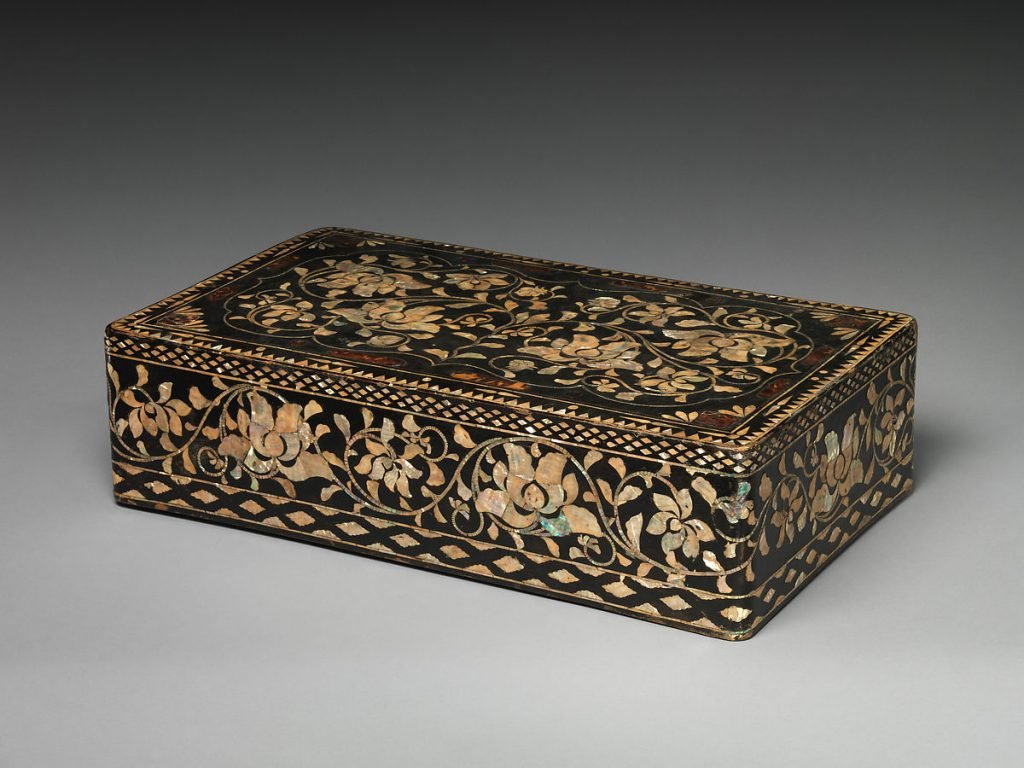
Lacquer inlaid with mother-of-pearl and tortoiseshell, and brass wire
Dimensions: H. 8 3/8 in. (21.3 cm); W. 18 1/8 in. (46 cm); L. 31 1/8 in. (79.1 cm)
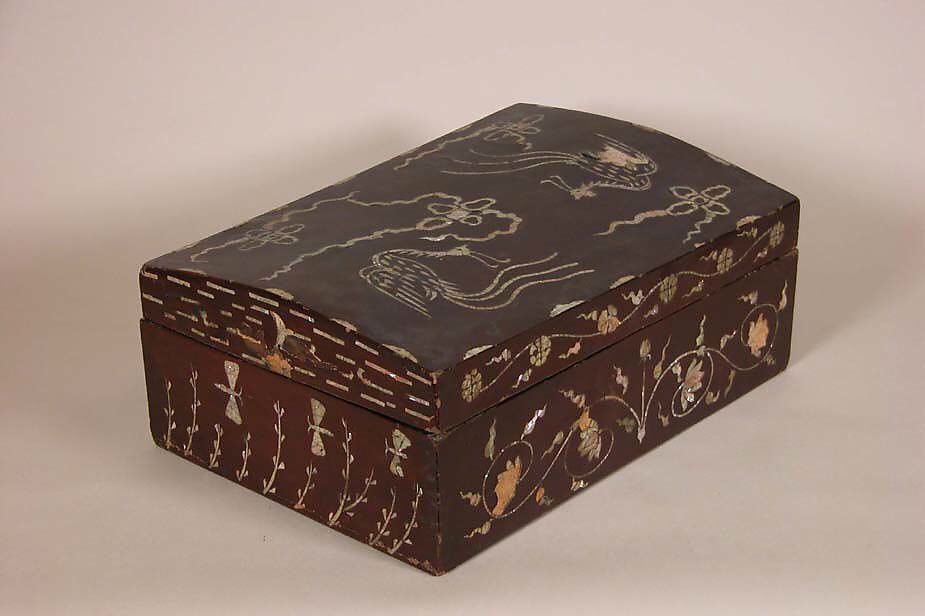
Lacquer inlaid with mother-of-pearl
Dimensions: H. 6 3/8 in. (16.2 cm); W. 11 in. (27.9 cm); L. 16 1/8 in. (41 cm)
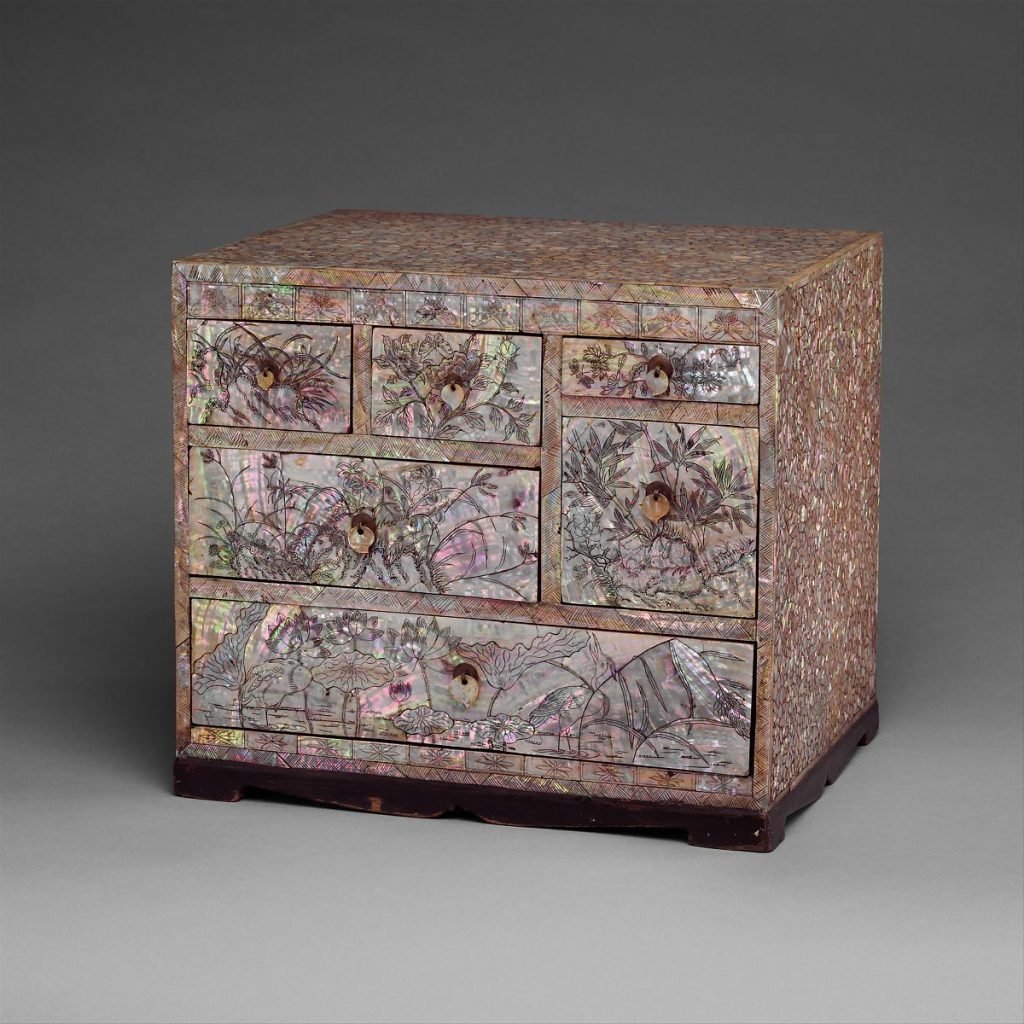
Lacquer inlaid with mother-of-pearl, with incised design
Dimensions: H. 11 3/8 in. (28.9 cm); W. 12 7/8 in. (32.7 cm); D. 9 7/8 in. (25.1 cm)
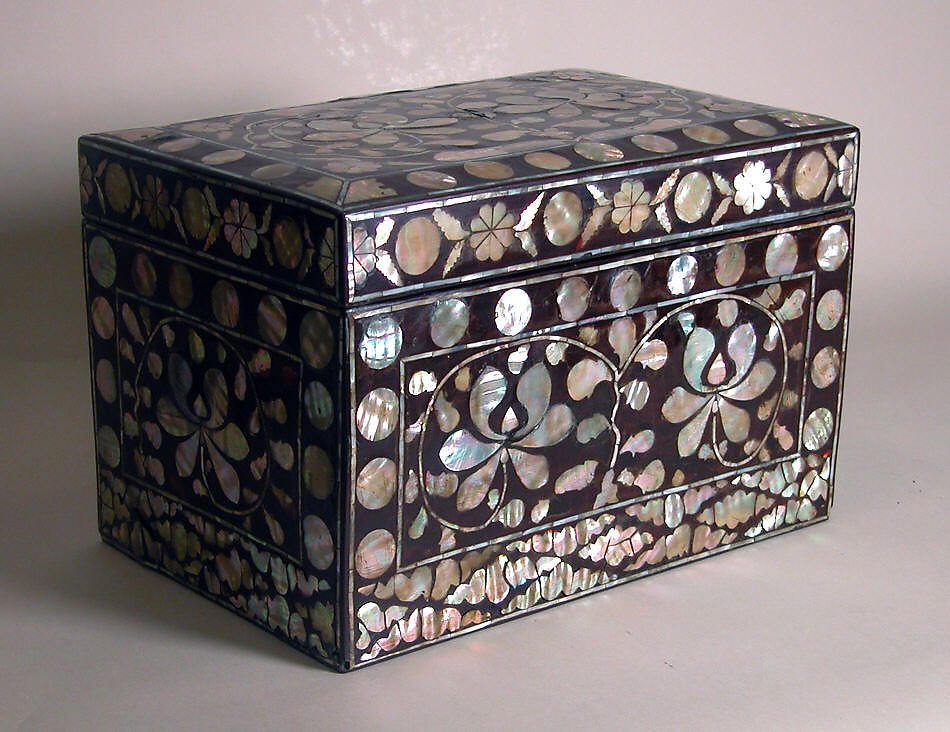
Lacquer inlaid with mother-of-pearl
Dimensions: H. 8 1/4 in. (21 cm); W. 8 1/4 in. (21 cm); D. 12 9/16 in. (31.9 cm)
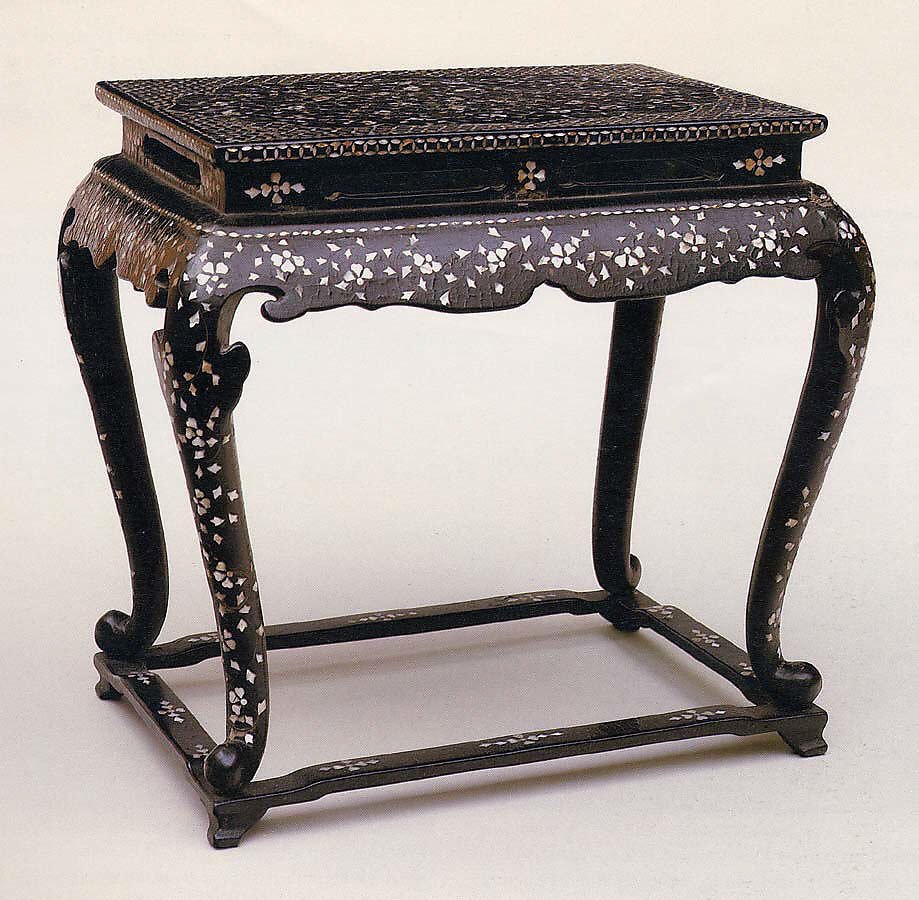
19th century.
Lacquer inlaid with mother-of-pearl and metal wire
Dimensions: L.16 5/8 in. (42.2 cm); W. 12 1/8 in. (30.8 cm); H. 15 1/4 in. (38.7 cm)
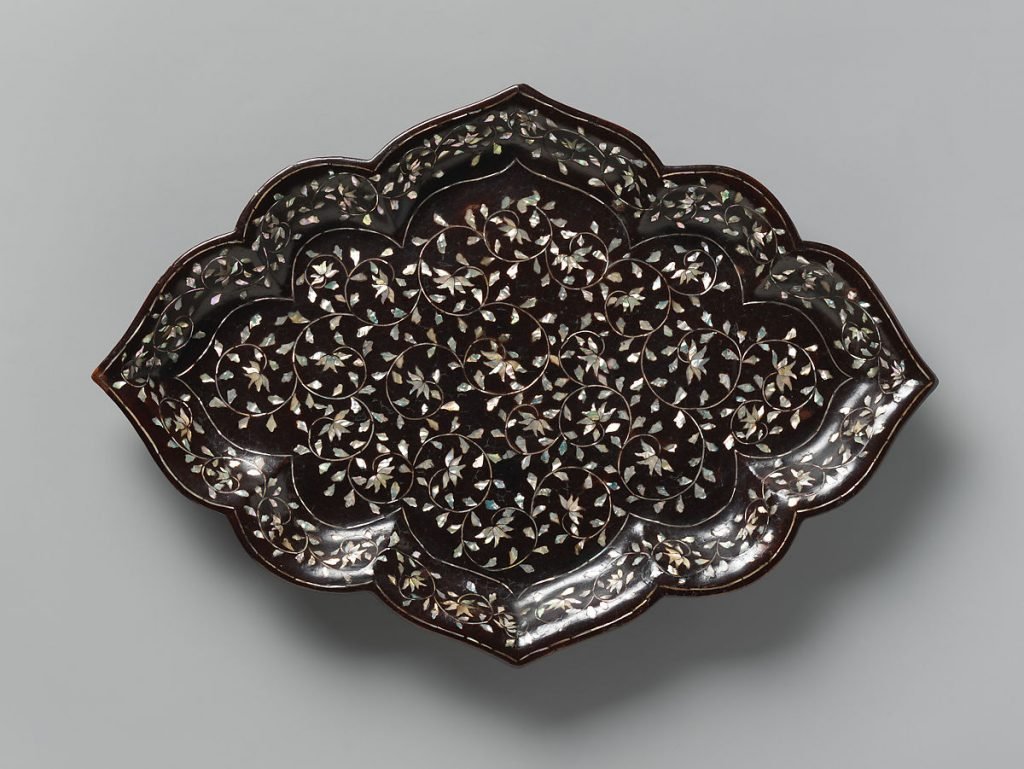
Lacquer inlaid with mother-of-pearl
Dimensions: H. 1 5/8 in. (4.1 cm); W. 12 in. (30.5 cm); L. 17 3/8 in. (44.1 cm)

Lacquer inlaid with mother-of-pearl and metal wire
Dimensions: H. 10 in. (25.4 cm); W. 13 1/8 in. (33.3 cm); D. 13 1/8 in. (33.3 cm)

Lacquer inlaid with mother-of-pearl, tortoiseshell, ray skin, and brass wire
Dimensions: H. 10 1/8 in. (25.7 cm); W. 12 5/8 in. (32.1 cm); L. 24 3/8 in. (61.9 cm)

Lacquered wood with inlaid mother-of-pearl, tortoiseshell, ray skin, and brass wire; brass fittings
Dimensions: H. 42 3/4 in. (108.6 cm); W. 35 5/8 in. (90.5 cm); D. 13 1/4 in. (33.7 cm)

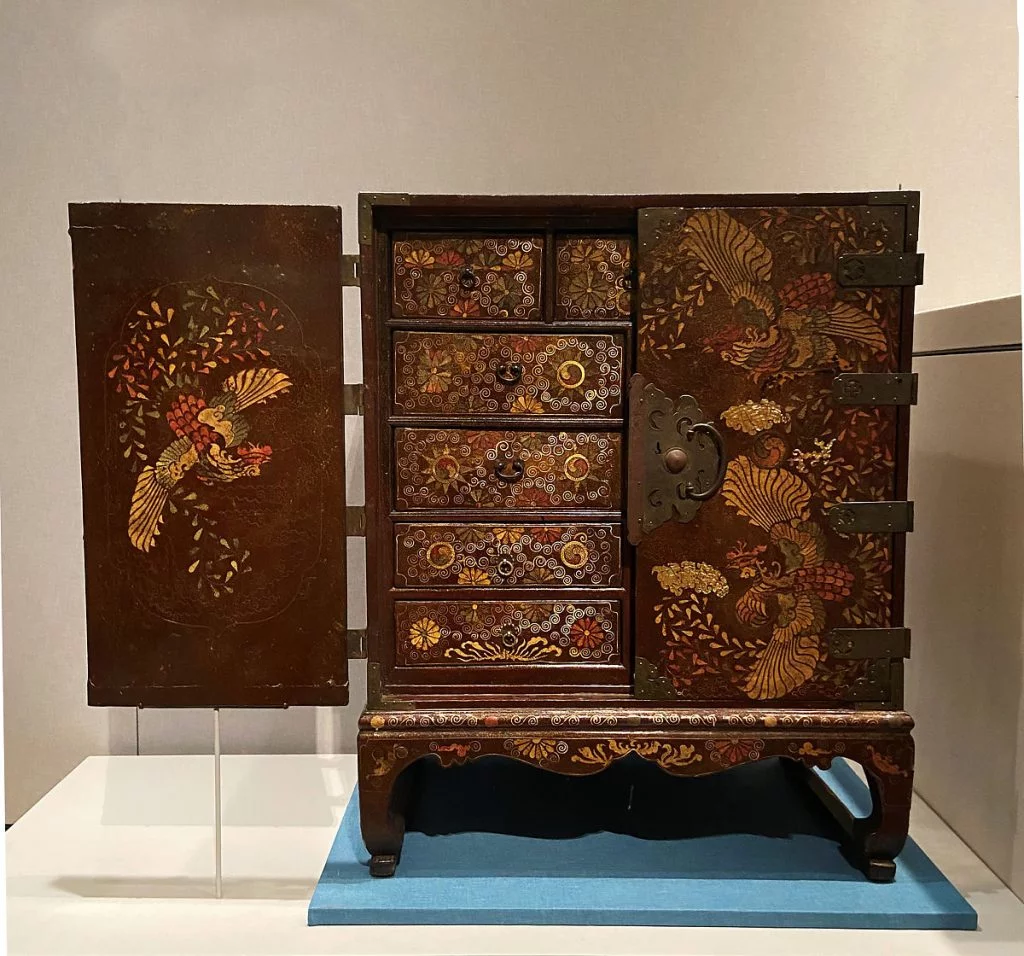
Lacquered wood inlaid with mother-of-pearl, tortoiseshell, ray skin, and brass wire; brass fittings
Dimensions: H. 34 in. × W. 27 5/8 in. × D. 16 3/4 in. (86.4 × 70.2 × 42.5 cm)
Other (Door): W. 13 1/2 in. (34.3 cm).
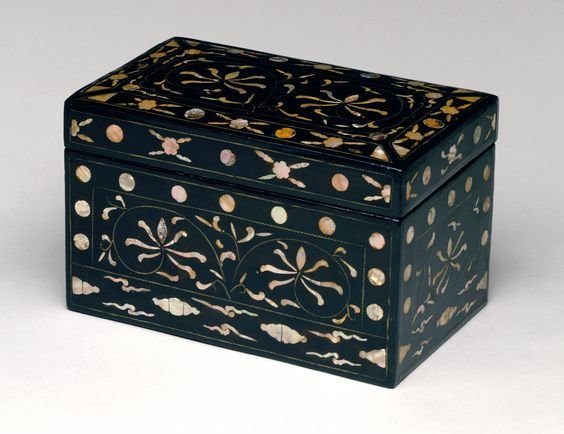
Dimensions: H. 8 in. (20.3 cm); W. 7 3/4 in. (19.7 cm); L. 12 5/8 in. (32.1 cm)
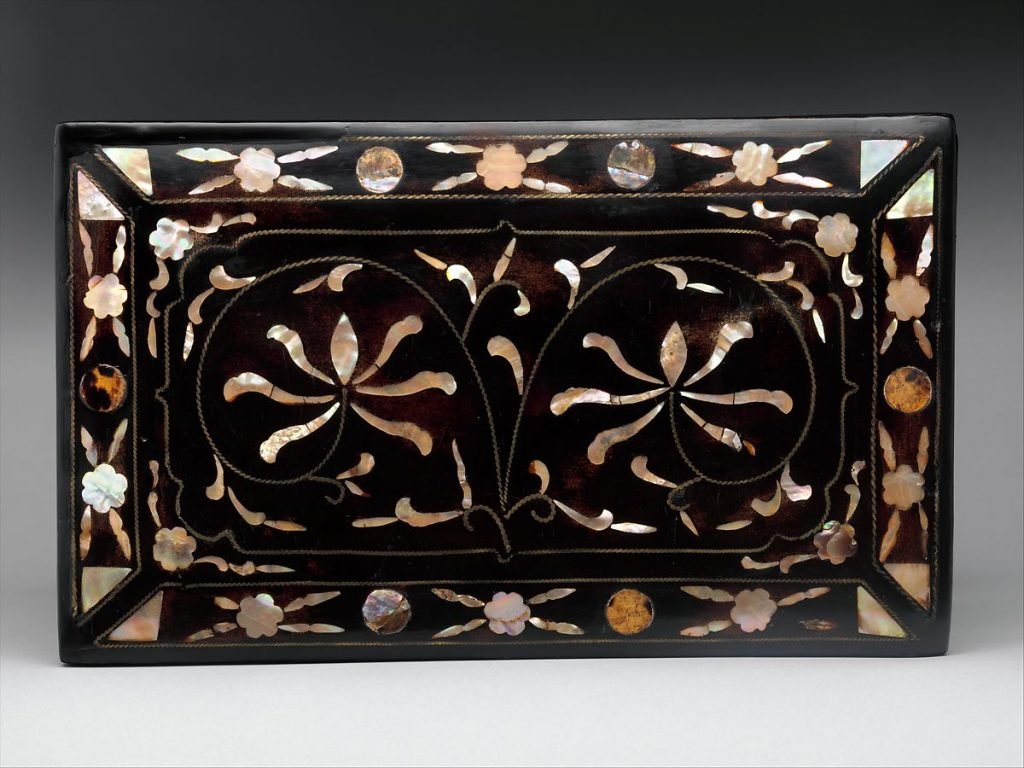
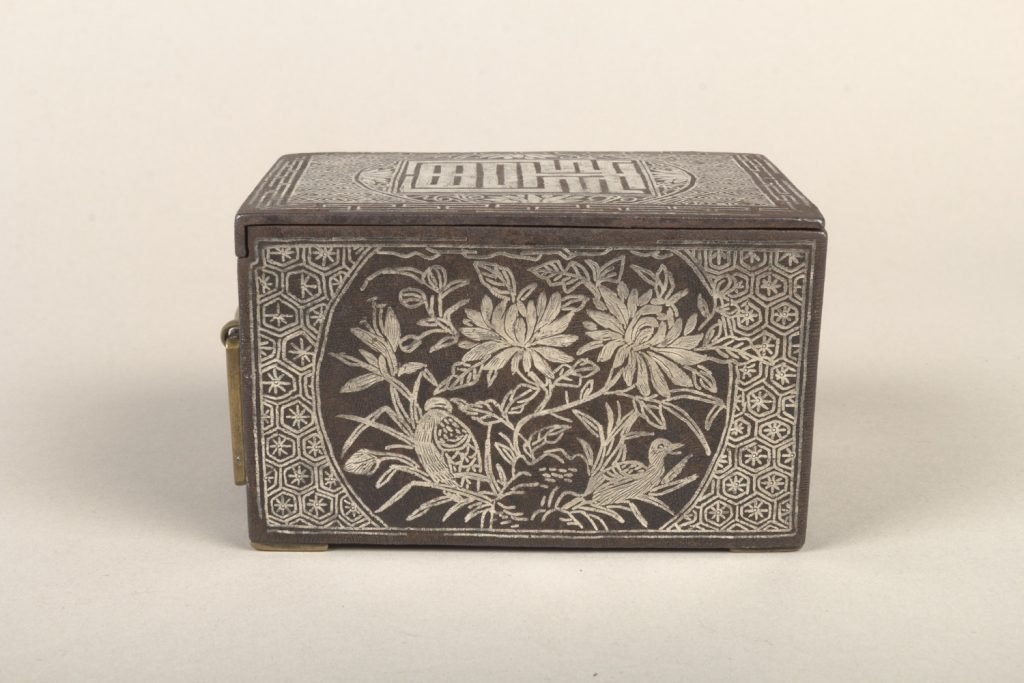
Iron inlaid with silver; brass fittings.
H. 2 1/2 in. (6.4 cm); W. 4 1/8 in. (10.5 cm); D. 2 7/8 in. (7.3 cm).
Smoking became prevalent during the late Joseon period, and led to the production of small boxes, such as this iron example with silver inlay, to hold tobacco leaves. In addition to the bird-and-flower imagery, this box shares many motifs with those found on lacquerware, including peony blossoms and hexagonal geometric patterns. It also features auspicious symbolism, evident from the large double-happiness character (囍) on the lid.
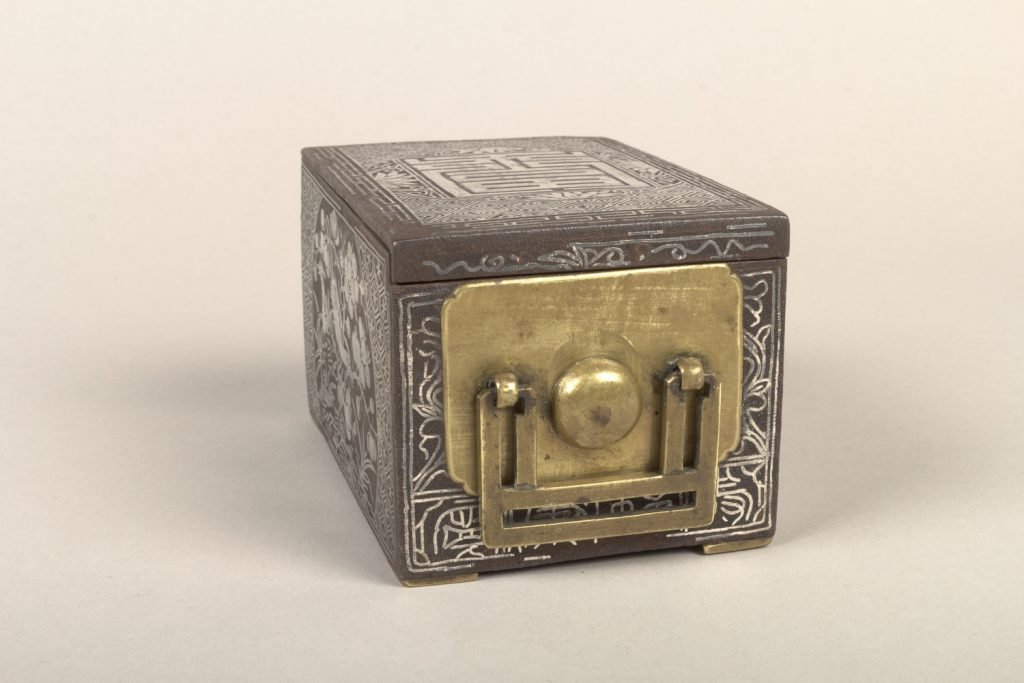

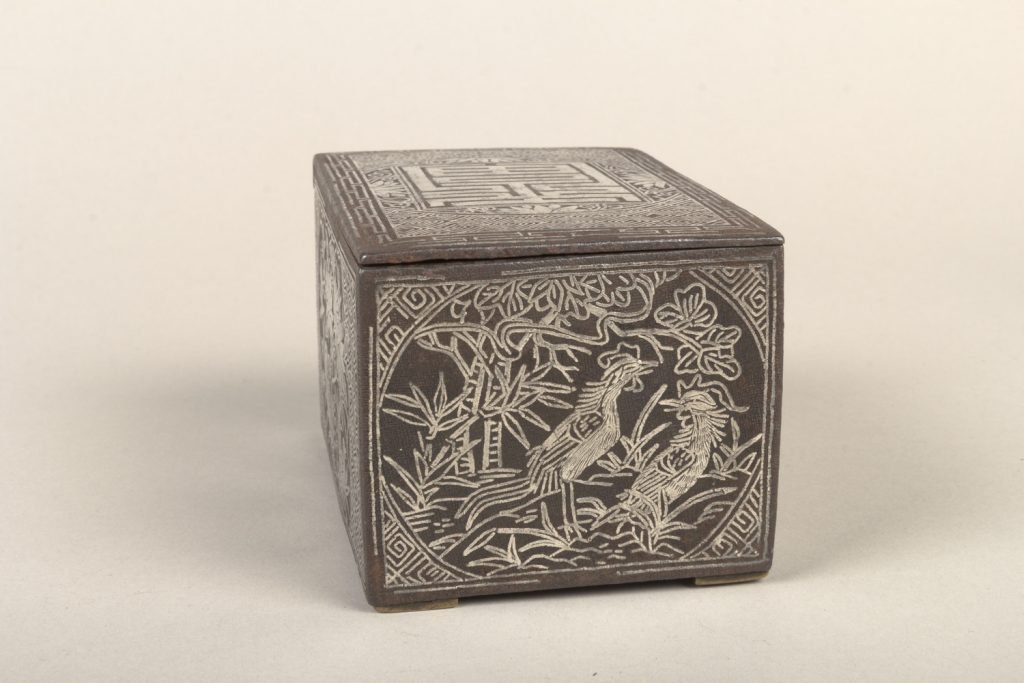
THE PHILADELPHIA MUSEUM OF ART
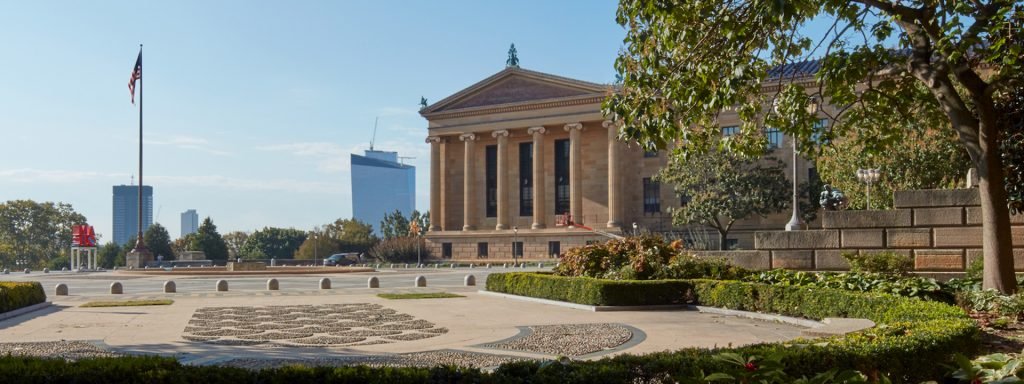
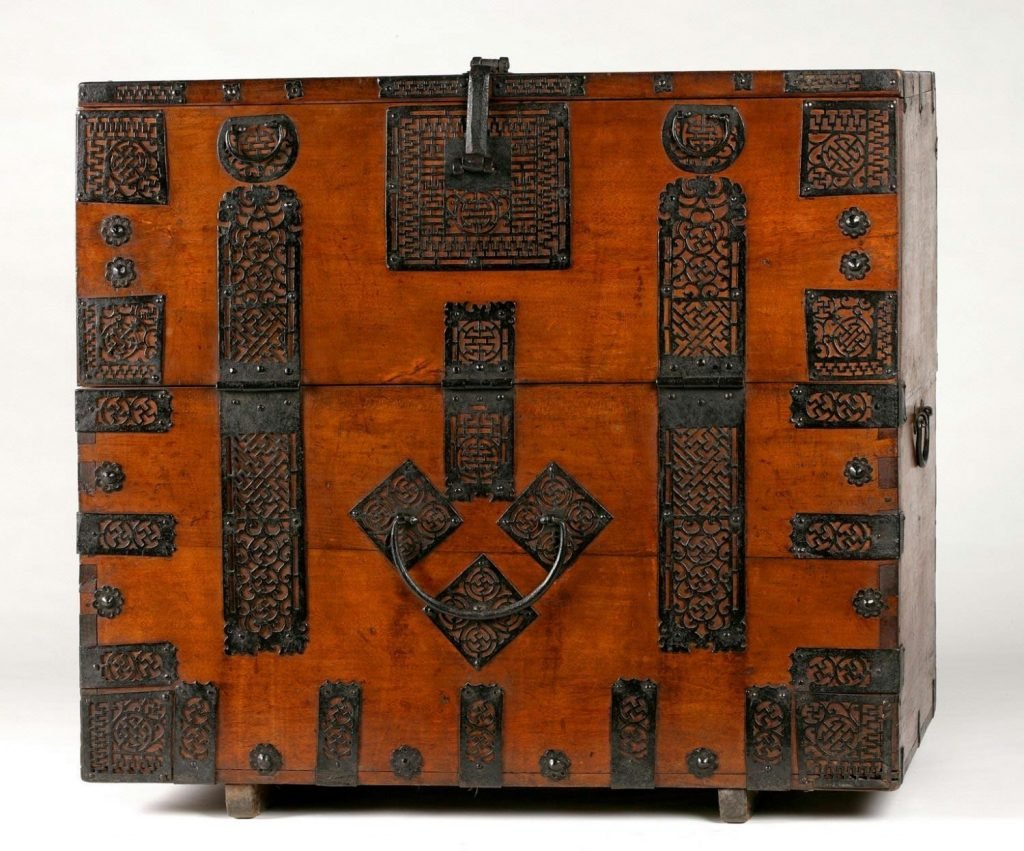
Late 19th – early 20th century.
Linden wood; iron fittings
H. 85,1cm, W. 94cm, D. 51,1 cm.
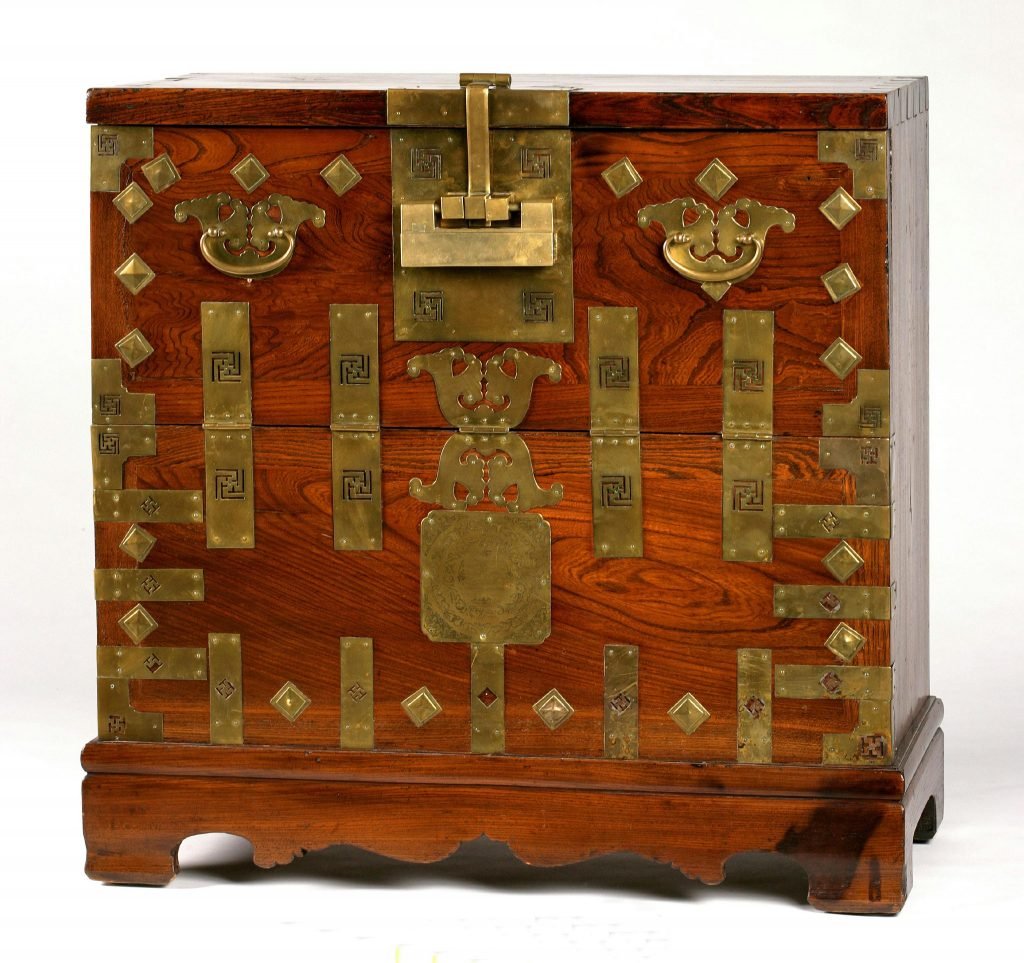
19th century
Zelkova wood; brass fittings
H. 82,9cm, W. 83,2cm, D. 43,2 cm.
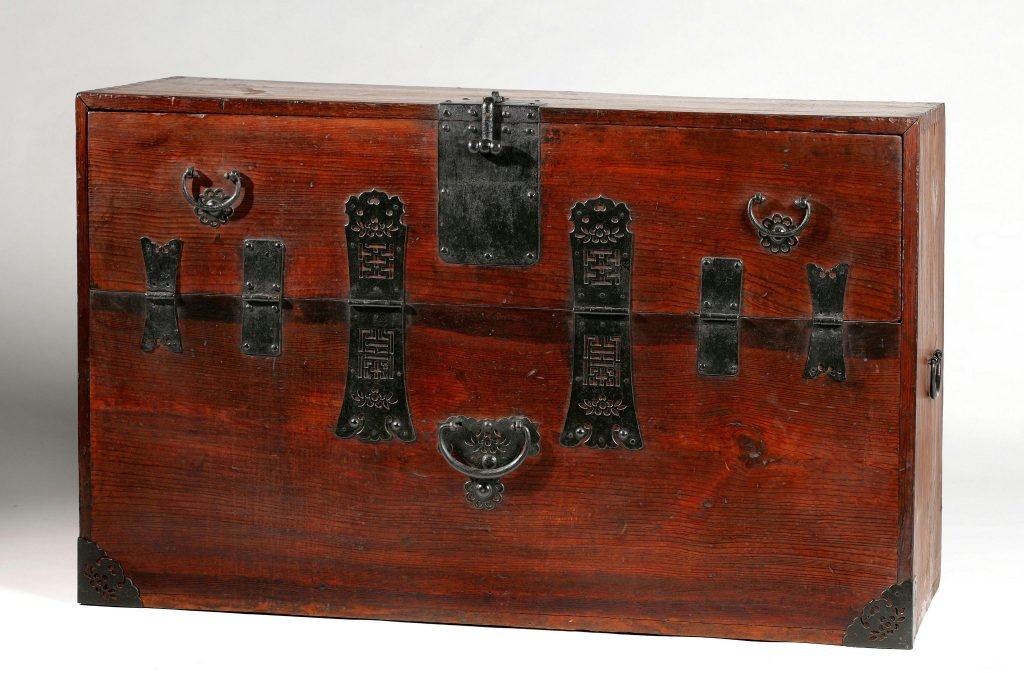
Late 19th – early 20th century
Pine with iron fittings. Auspicious symbols, many signifying longevity, frequently decorated the metal hardware. Indeed, the large hinges on this bandaji feature the Chinese character “shou,” meaning long life.
H. 66,7cm, W. 109,2cm, D. 40,6 cm
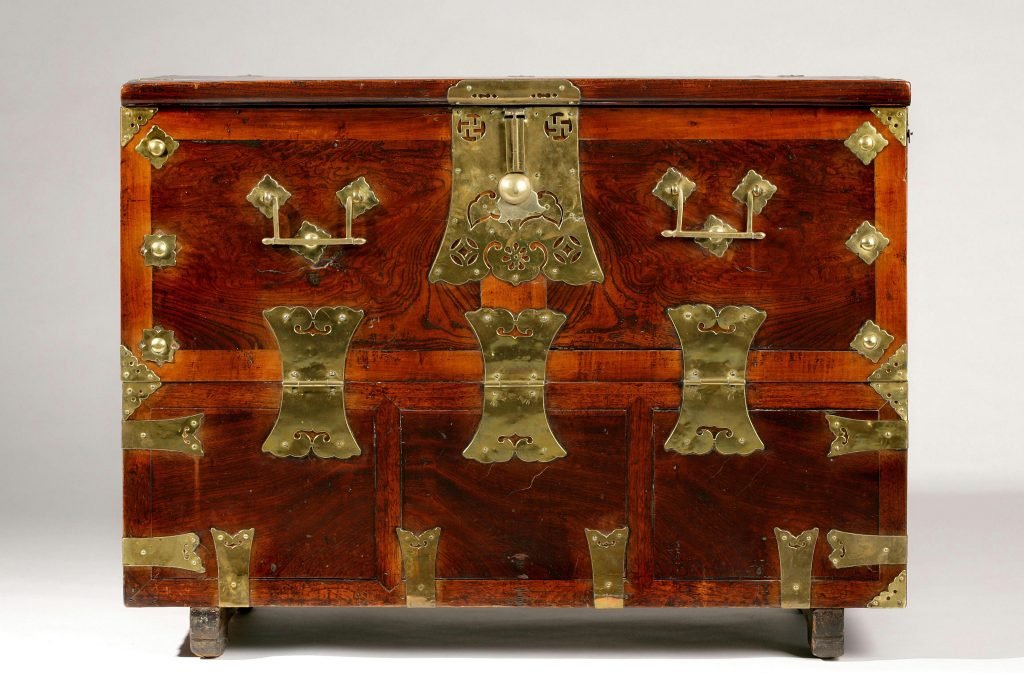
20th century
Zelkova wood; brass mounts
H. 64,8cm, W. 85,7cm, D. 40,6 cm.

19th century
Pine and zelkova wood; brass fittings
H. 109,9cm, W. 80,5cm, D. 39,5cm.
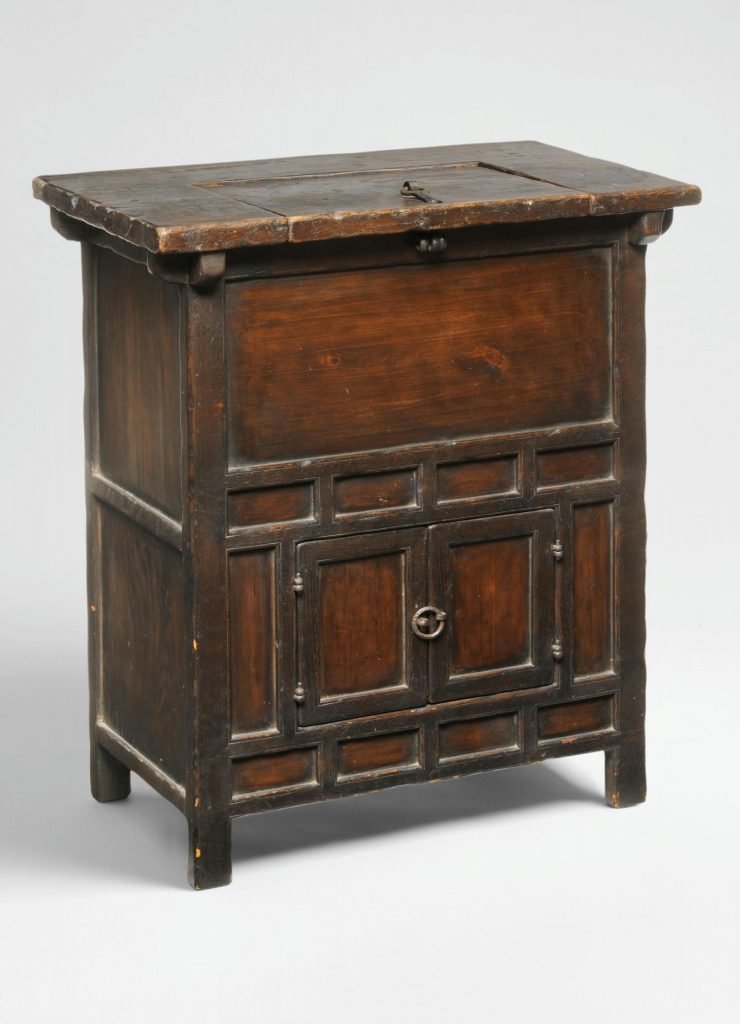
19th century
Pine wood.
H. 76,8cm, W. 65,4cm, D. 39,4cm.

20th century
Paulownia wood(?); brass fittings
H. 34,9cm, W. 38,7cm, D. 30,2cm.
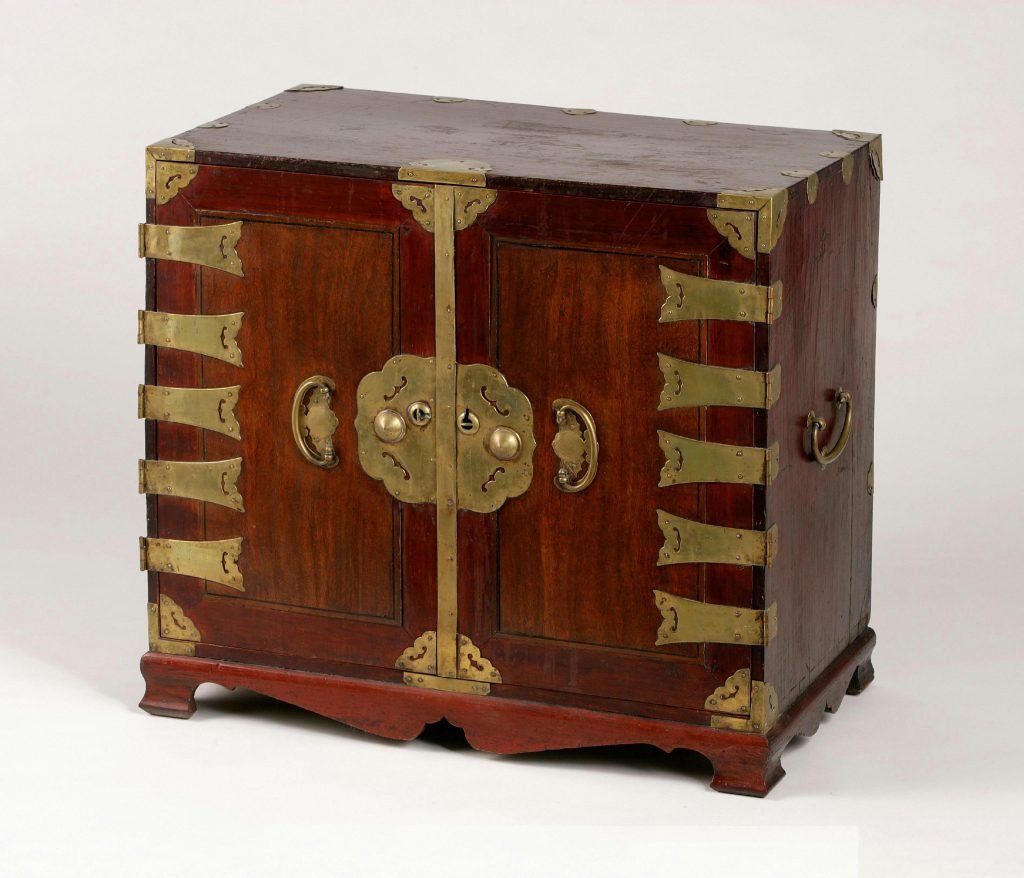
20th century
Paulownia wood, brass
H. 62,2cm, W. 68,9cm, D. 40cm.

19th century
Lacquered wood.
H. 27.6cm, Diameter: 41,3cm.
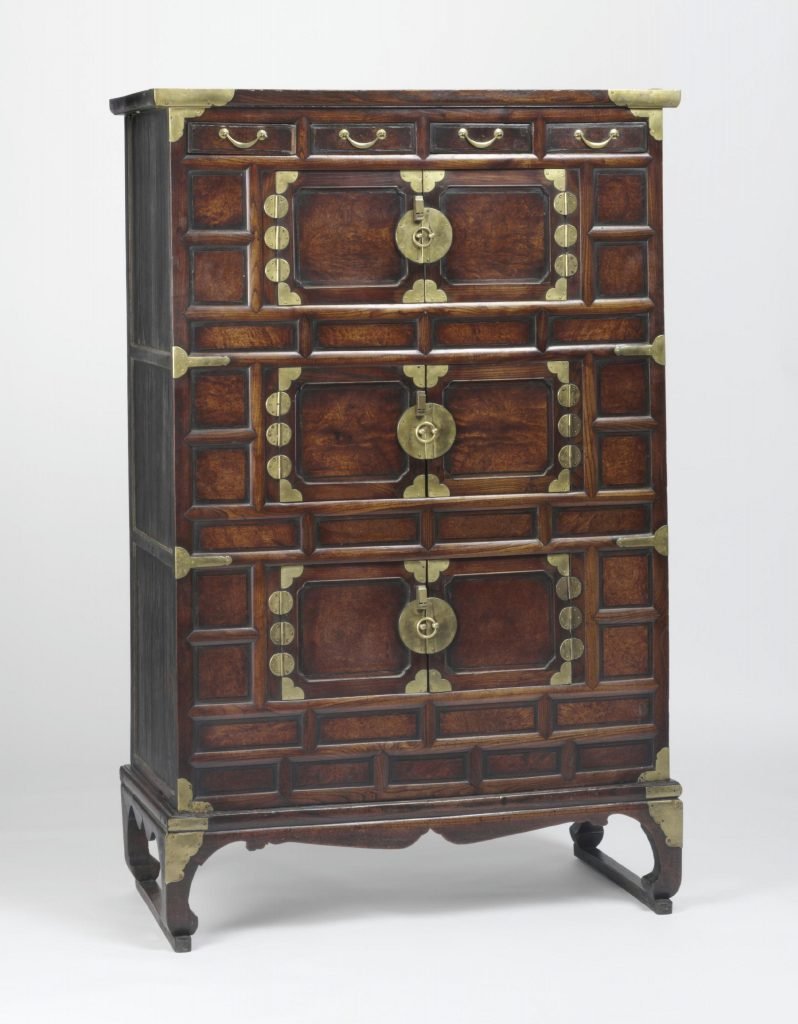
Mid- to late 19th century
Wood with brass fittings
H. 168,3cm, W. 109,2cm, D. 52,1cm.
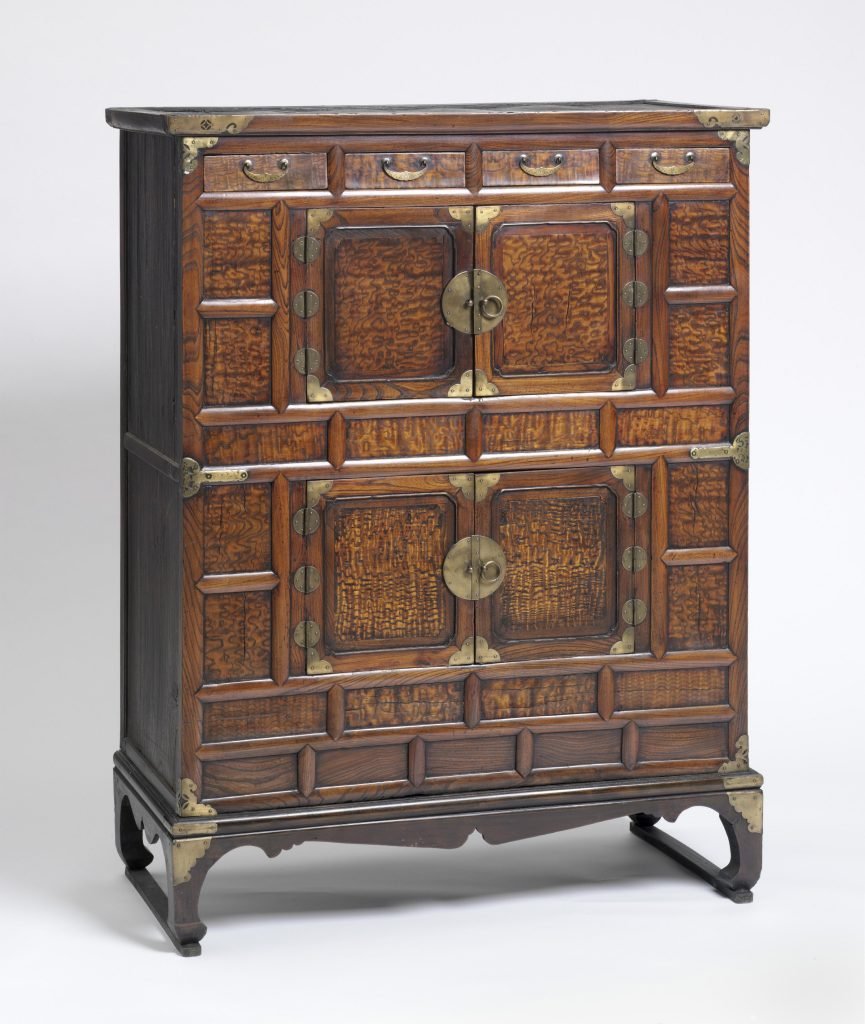
19th century. Wood, wood veneer; brass fittings.
H. 138,4cm, W. 107,3cm, D. 52,7 cm.
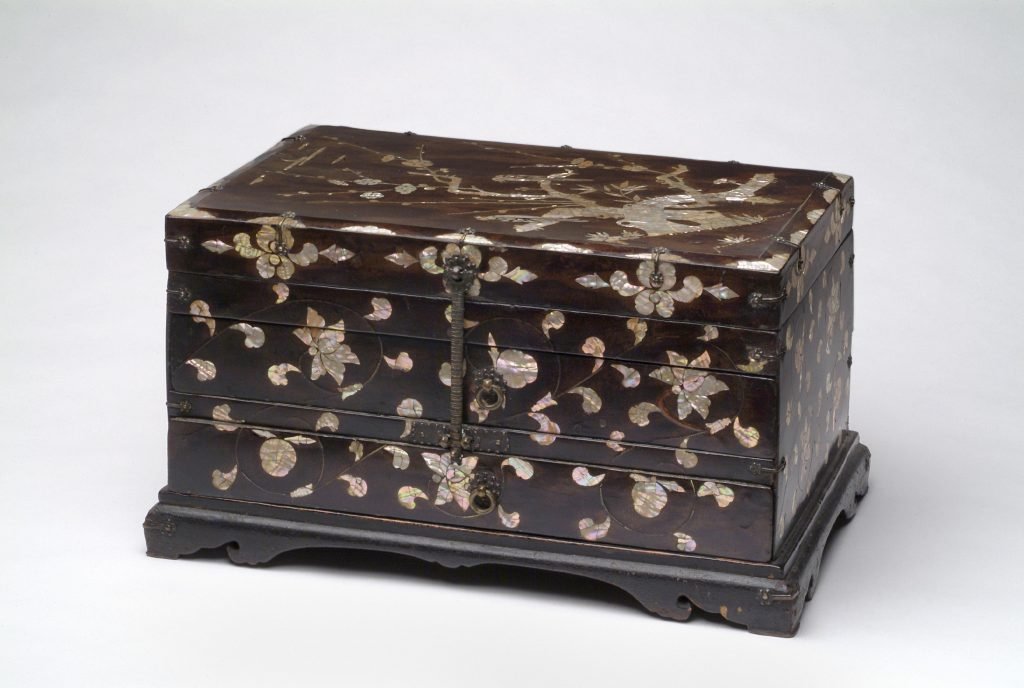
Lacquered wood with mother-of-pearl and brass wire inlay; brass fittings
9 1/2 x 17 x 11 3/4 inches (24.1 x 43.2 x 29.8 cm)
18th century
Although the history of lacquer work goes back at least two thousand years in Korea, the majority of surviving lacquer objects date from the Goryeo (918-1392) and Joseon Dynasty (1392-1910) dynasties. Most Korean lacquer pieces are decorated with mother-of-pearl inlay, and they often include twisted brass wires. Korean artists preferred to use abalone shell for their mother-of-pearl inlay because of its luminous colors. This scholar’s box is an excellent example of its kind; a scholar would use such a container to store an inkstone or different kinds of stationery.
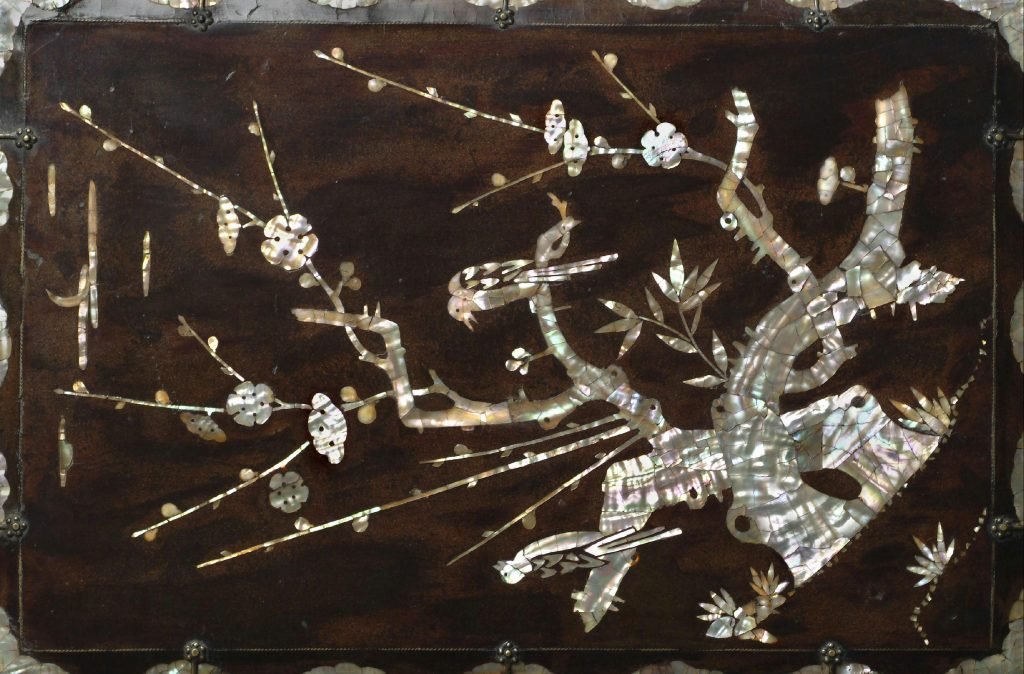
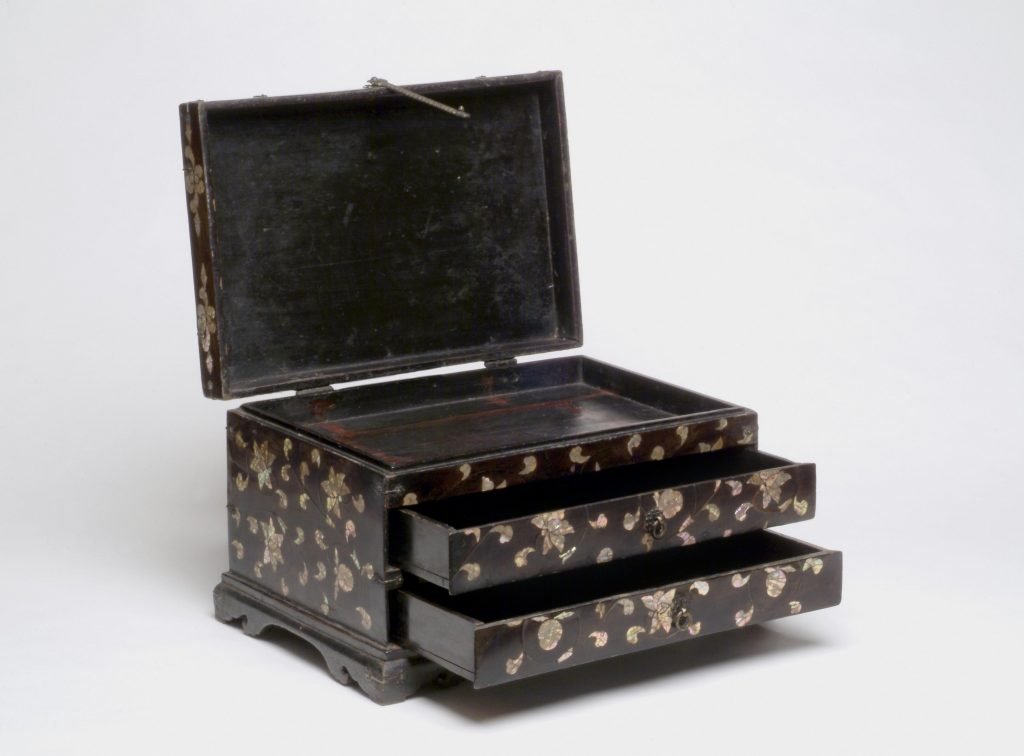
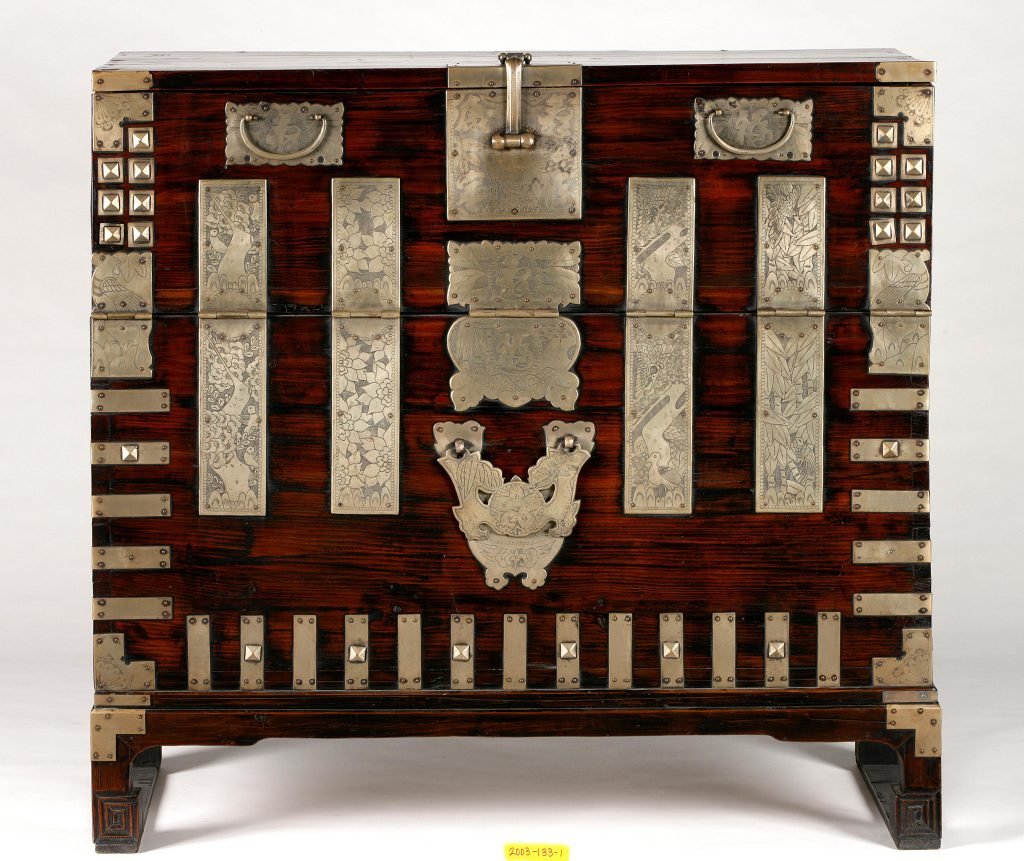
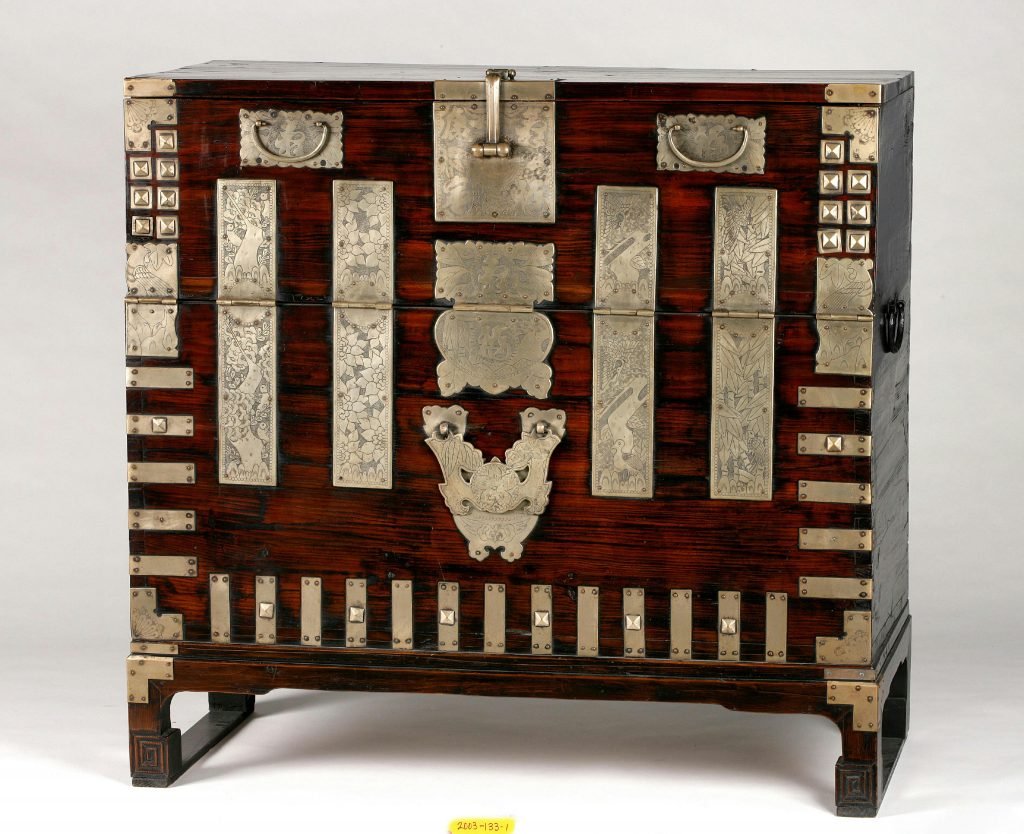
Wood; white brass fittings with incised decoration
42 15/16 x 45 1/4 x 19 inches (109 x 115 x 48.3 cm)
19th century
The Korean name bandaji (literally meaning “half closing”) derives from the hinged door in the front of this chest. This type of chest was one of the most essential, and most commonly found, pieces of furniture in a Korean household. Clothes would be stored inside while folded blankets would be placed on top. This chest, with its richly decorated fittings and extensive metalwork, is the type that was produced in the northern provinces of the Korean peninsula.
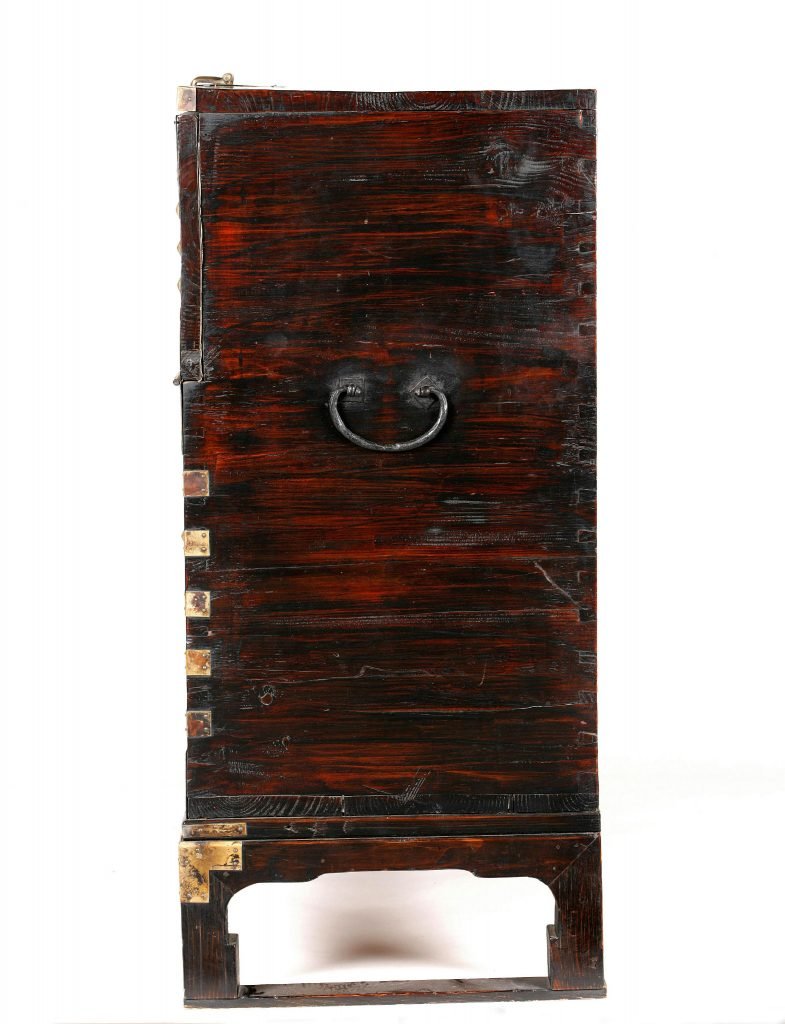
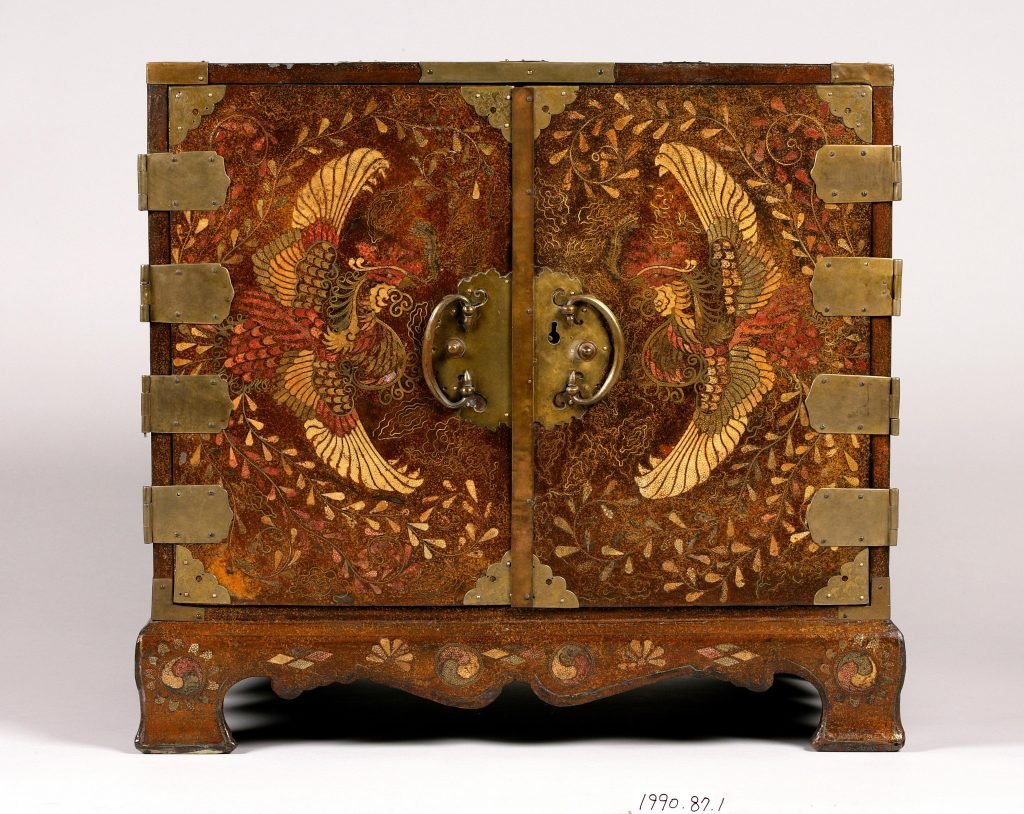
19th century. Lacquered wood with brass wire and dyed ray skin inlay; gilded metal fittings
H. 61cm, W. 66cm, D. 43,2 cm.

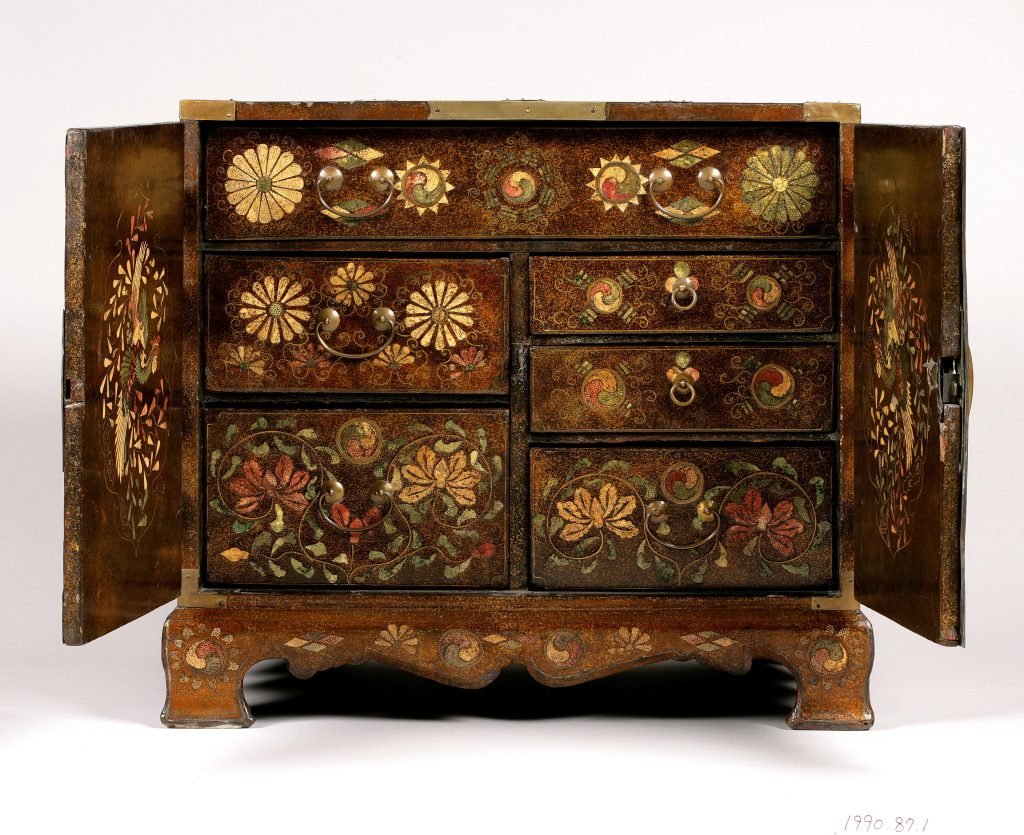
THE SAN FRANCISCO ASIAN ART MUSEUM
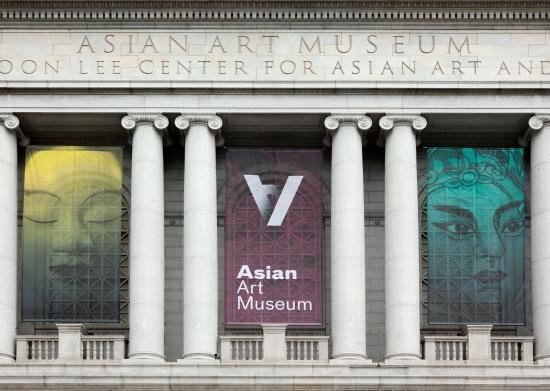
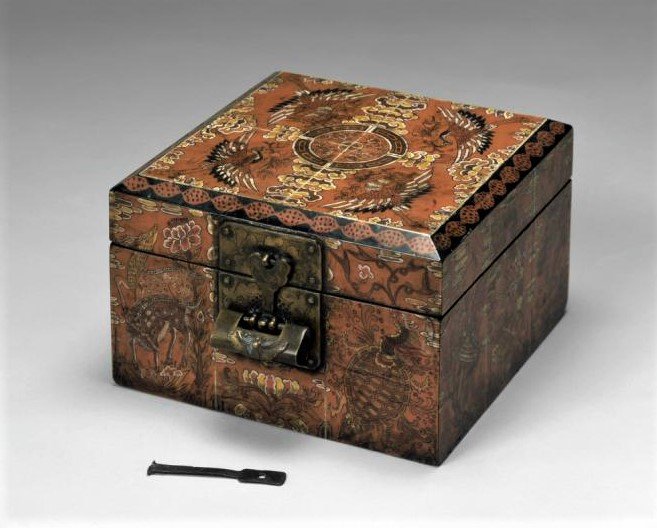
H. 14cm, W. 22,2cm, D. 22,2cm.
Date: approx. 1800-1890

Lacquered elm wood, iron, and paper.
H. 95,3cm, W. 98,1cm, D. 48,9cm.
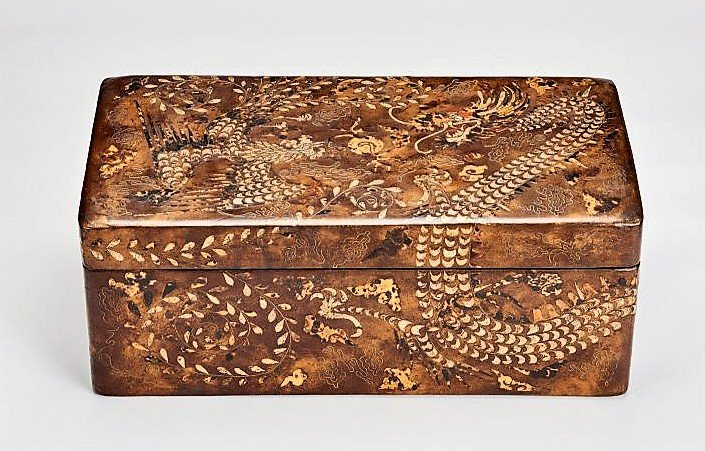
용∙봉황 무늬 상자. Lacquered wood with inlaid mother-of-pearl, tortoiseshell, ray skin, and metal wire.
Joseon dynasty, 19th century.

길상 무늬 병풍 Six panel folding screen
Lacquered wood with inlaid mother-of-pearl, tortoiseshell, brass wire, and ray skin. Date: 1850-1950.
This combination was common in lacquerwares during the late nineteenth to early twentieth century. Each screen features a motif that is deeply symbolic in traditional Korean art. From right to left, a dragon, phoenix, deer, tiger, crane, and peonies are depicted.

복숭아학 무늬 벼루상자
Lacquered wood with inlaid mother-of-pearl. Joseon dynasty 19th century.
This box was used as a chest to store scholarly objects such as brushes, ink, and inkstones; along with paper
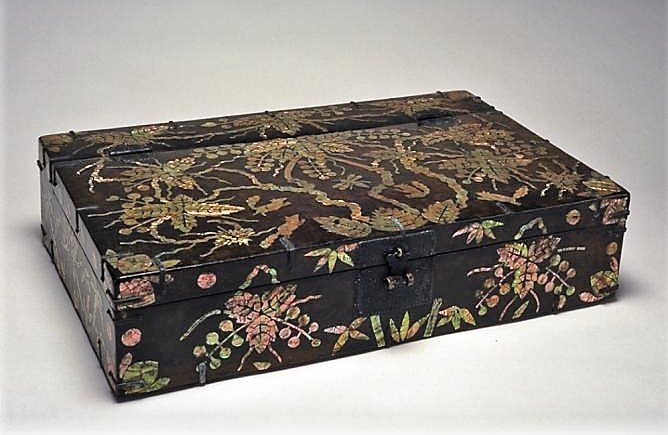
포도 무늬 상자 Lacquered wood with inlaid mother-of-pearl and metal fittings. H. 11,4cm, W. 49,5cm, D. 31,7cm. Date: 1700-1800. Joseon dynasty.

모란무늬 옷상자 Lacquer on wood with inlaid mother-of-pearl.
H. 19,7cm, W. 48,3cm, D. 84,5cm. Date: approx. 1700-1800. Joseon dynasty.
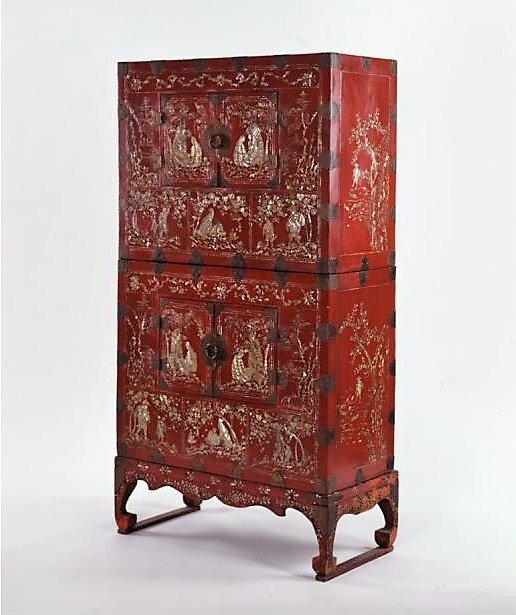
Lacquer on wood with inlaid mother-of-pearl and metal fittings. H. 137,5cm, W. 73,8cm, D. 36,8cm. During the Joseon dynasty, a red-lacquer chest such as this was for upper-class women.

포도 무늬 화장품 상자
Lacquered wood with inlaid mother-of-pearl and metal fittings. H. 19,1cm, W. 23cm, D. 16 cm.
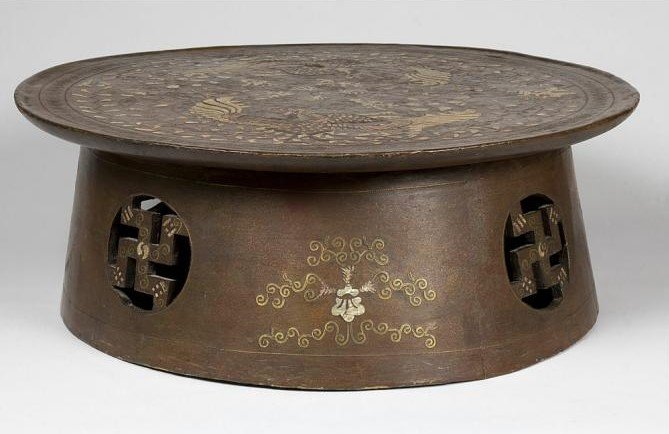
봉황 무늬 상.
Lacquered wood with inlaid mother-of-pearl, ray skin, and metal wire.
H. 25,4cm, Diam. 69,9cm
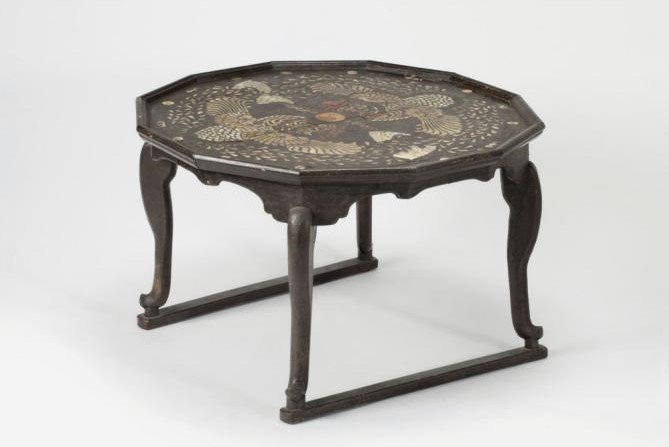
봉황 무늬 상
Lacquered wood with inlaid mother-of-pearl, ray skin, and metal wire.
H. 40cm, W. 63,8cm, D. 64,5cm.

Pine wood, iron fittings.
H. 86,4cm. W. 105,4cm, D. 47cm.

물고기 무늬 밥상
Lacquered wood with inlaid mother-of-pearl. H. 21cm, W. 34,9cm, D. 29cm.
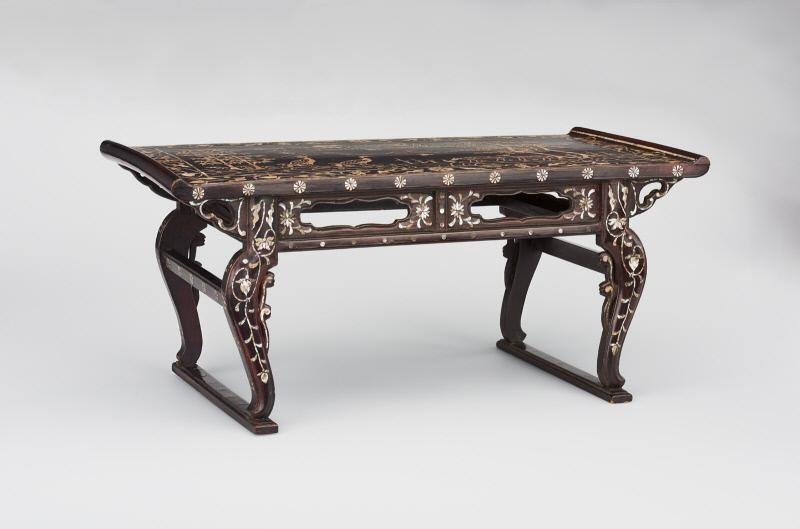
십장생 무늬 책상
Lacquer on wood with inlaid mother-of-pearl. H. 26,7cm, W. 54,6cm, D. 27,9cm.
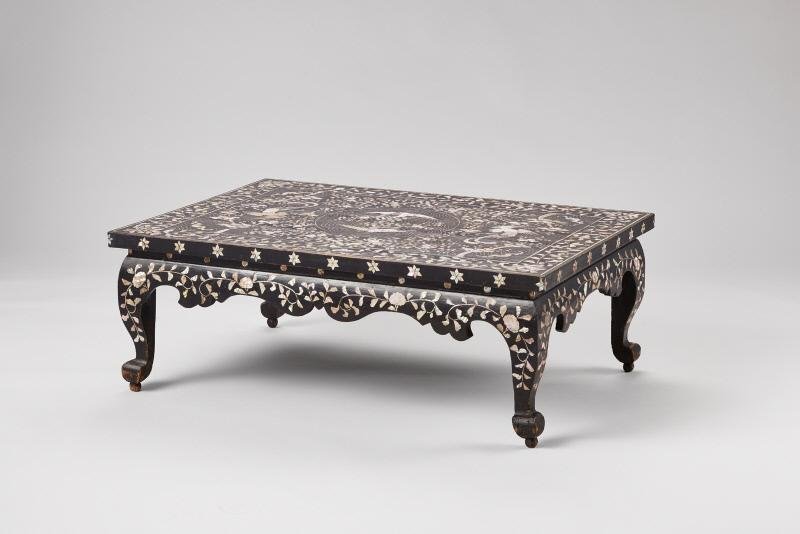
학∙봉황∙복숭아 무늬 큰 상
H. 35,6cm. W. 99,7cm, D. 69,2cm.
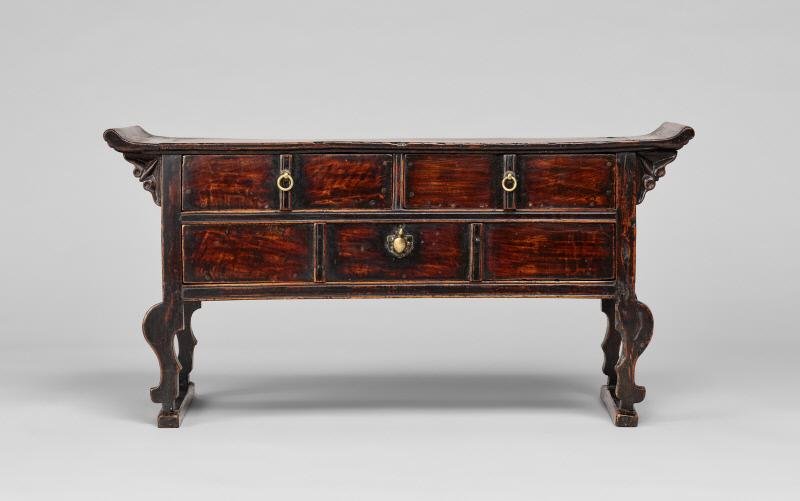
Date: 1850-1910. Joseon dynasty (1392-1910).
H. 33 cm, W. 63.5 cm, D. 29.2 cm.
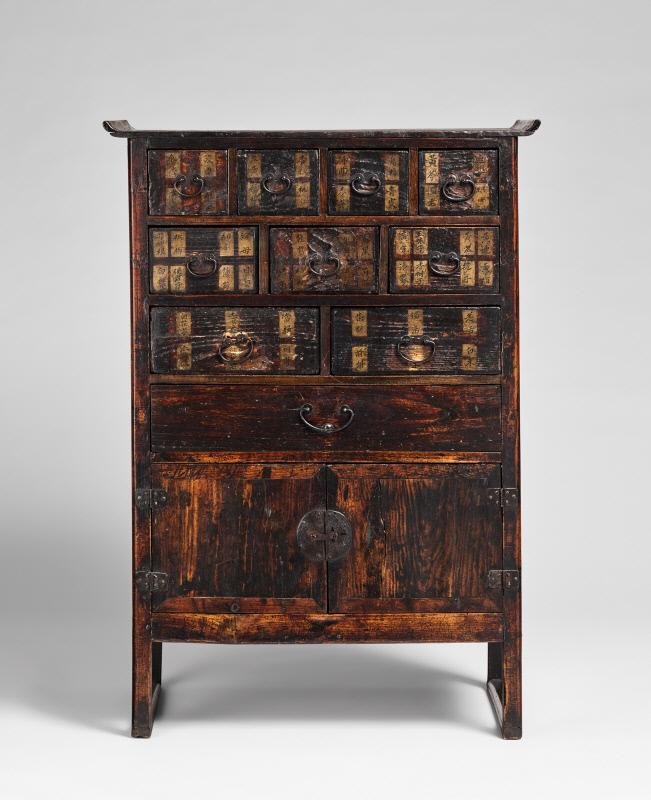
Date: 1875-1910. Joseon dynasty (1392 – 1910).
H. 115.6 cm, W. 81.3 cm, D. 42.5 cm.

Lacquered wood with inlaid mother-of-pearl, ray skin, and metal wire, and metal fittings. Date: 1800-1900. H. 120.3 cm, W. 87.6 cm, D. 36.5 cm.

Lacquered wood with inlaid mother-of-pearl and metal fittings. Date: 1800-1900. H. 17cm, W. 75cm, W. 42,5cm.
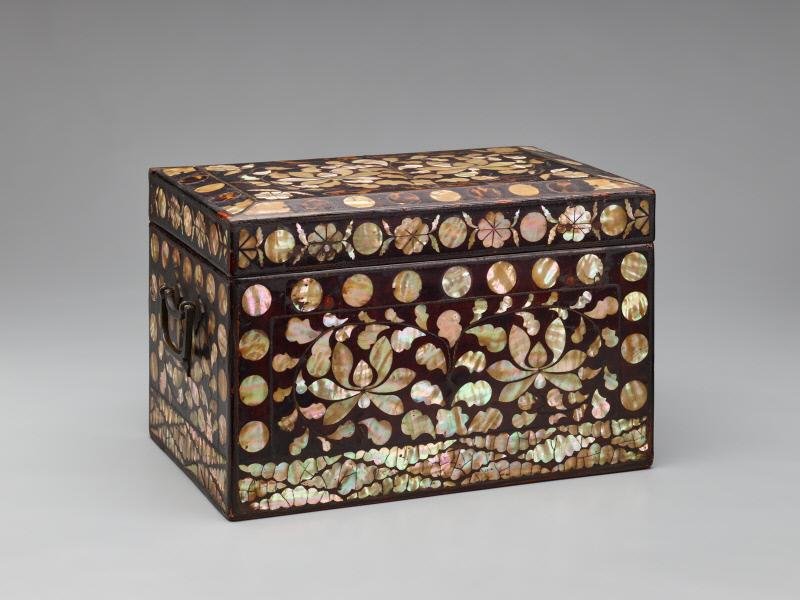
Lacquer on wood with inlaid mother-of-pearl, tortoiseshell, and brass wire, and metal fittings. Date: 1500-1650.
H. 20.6 cm, W. 33.0 cm, D. 21.6 cm.
THE BOSTON MUSEUM OF FINE ARTS

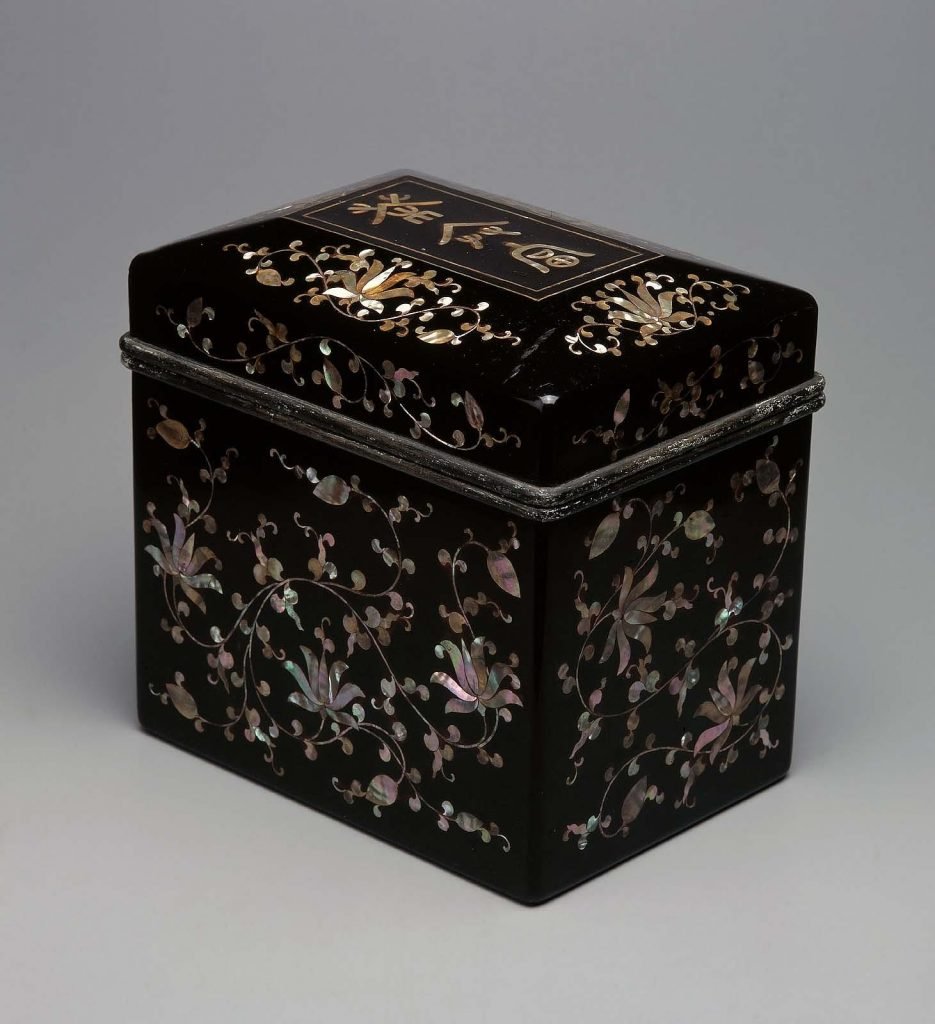
나전연당초문연초합 Joseon dynasty
Late 19th to early 20th century.
21.0 x 19.5 x 15.0 cm
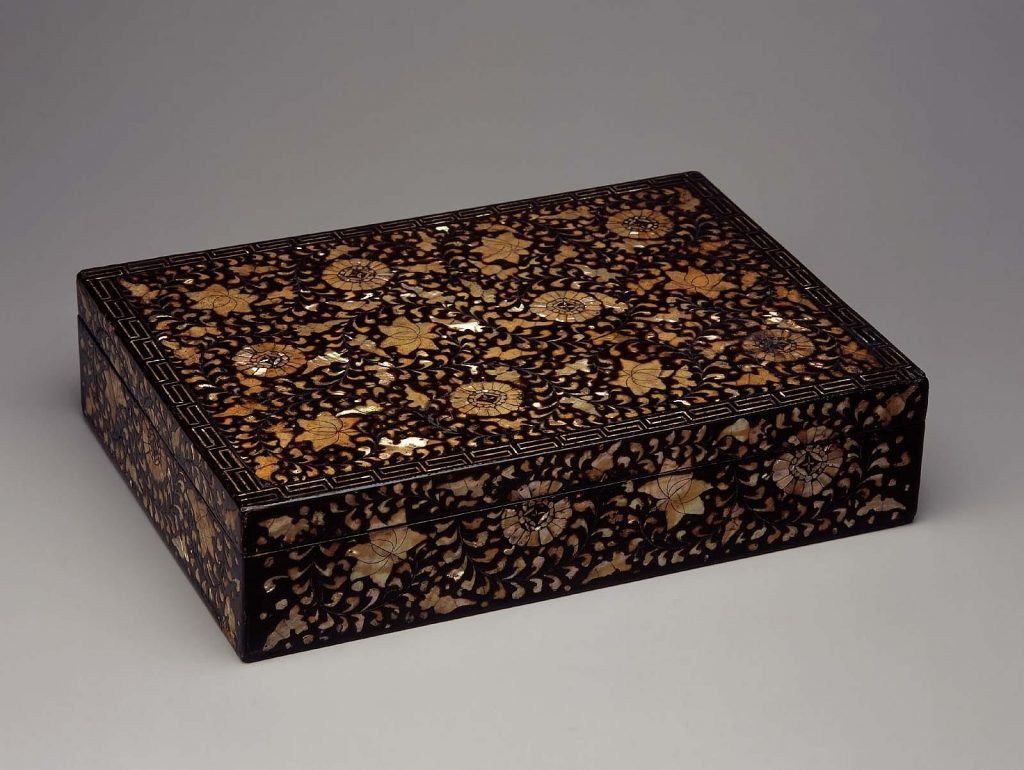
나전국모란당초문상자 Joseon dynasty
Late 19th to early 20th century.
Lacquer with mother-of-pearl inlay.
8.2 x 34.1 x 24.6 cm
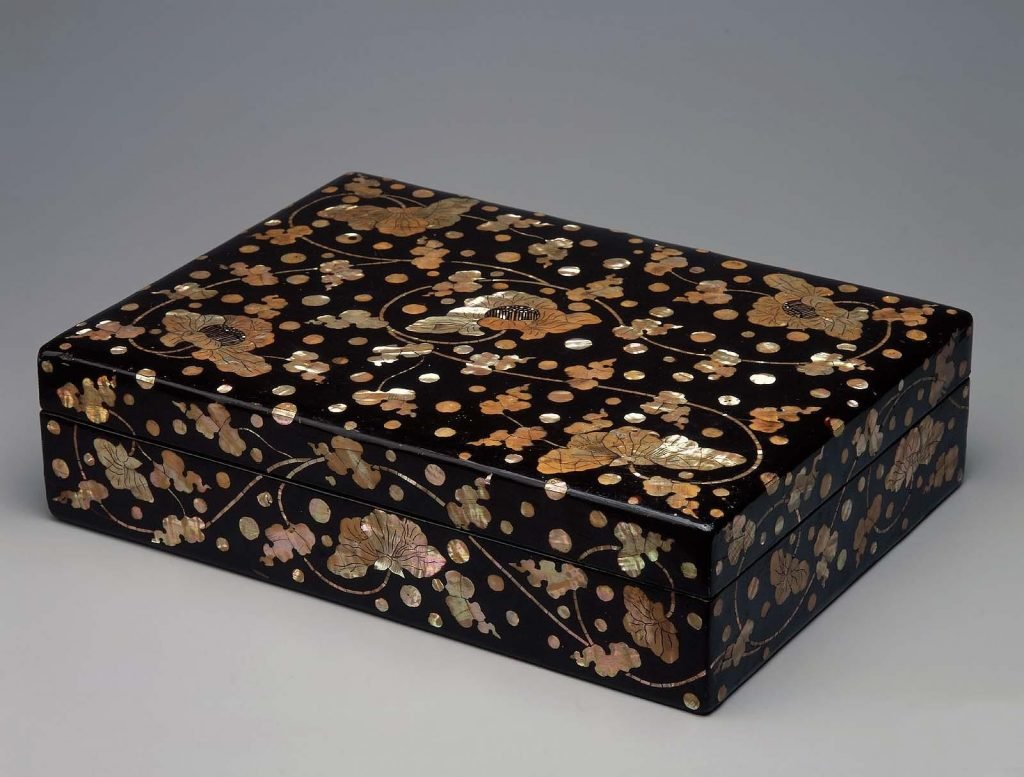
나전부용당초문상자
Joseon Dynasty
18th century.
Lacquer with mother-of-pearl inlay.
10.0 x 38.7 x 27.0 cm
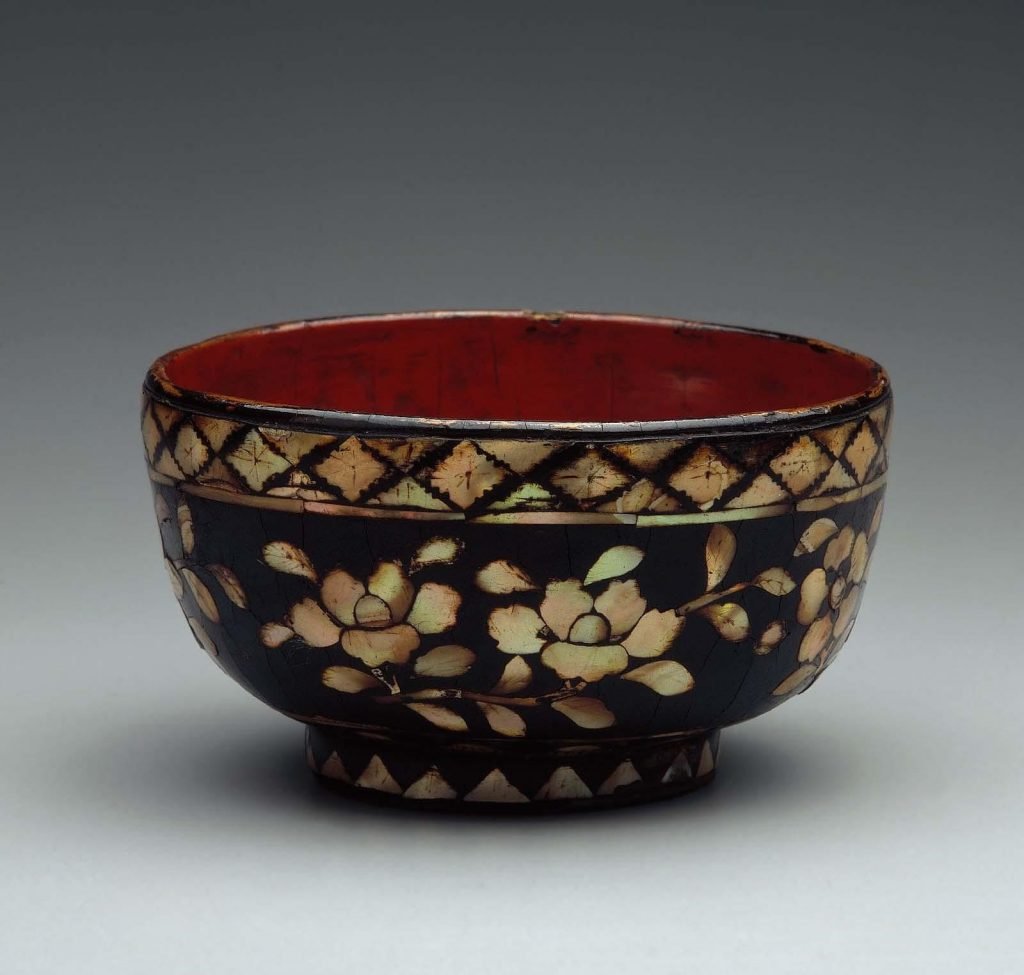
나전모란문완 Joseon dynasty
17th–18th century.
Lacquer with mother-of-pearl inlay.
Height: 6.7 cm, Diameter of Rim: 11.5 cm
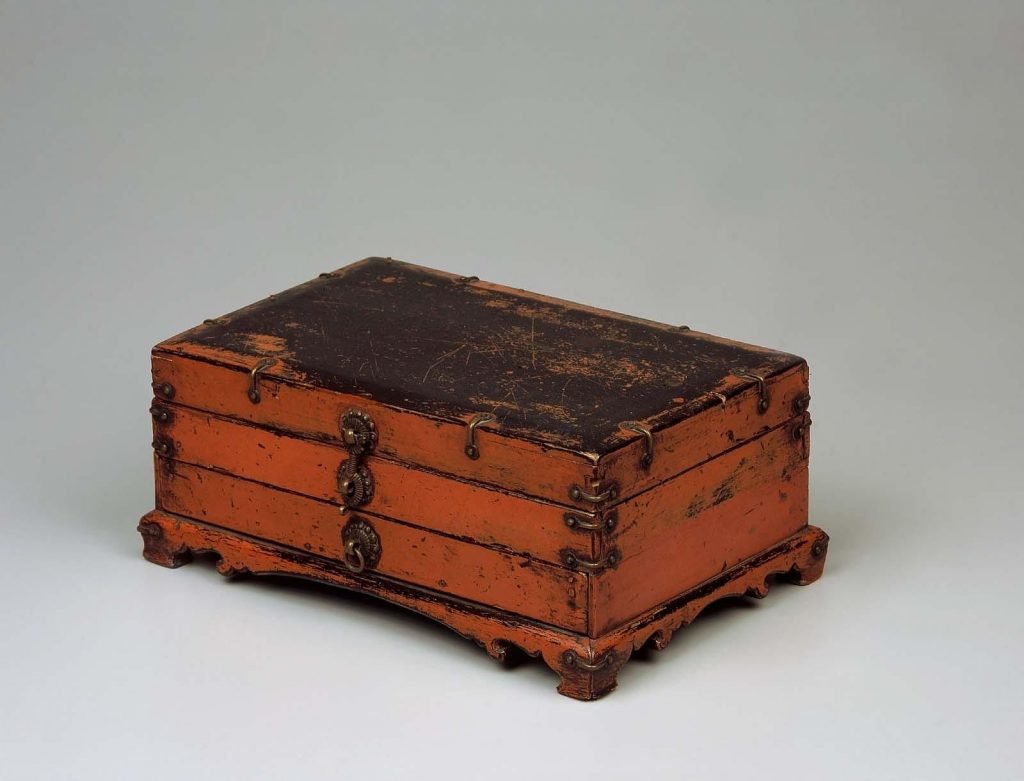
Joseon dynasty
18th century.
Wood body with red and black lacquer and metal fittings.
12.5 x 30.3 x 19.5 cm

나전국모란당초죽문상자
Joseon dynasty
17th–18th century.
Lacquer with inlaid mother-of-pearl and metal fittings. 10.7 x 33.8 x 33.8 cm
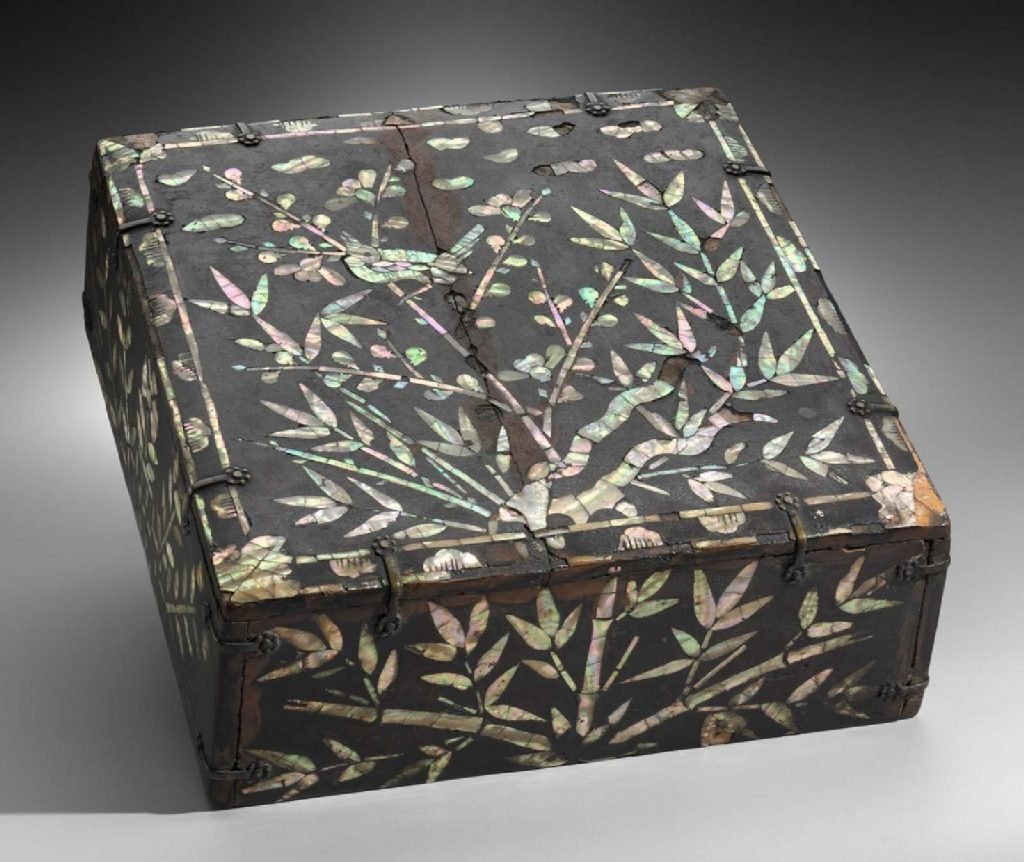
나전매죽문상자 Joseon dynasty
17th–18th century. Lacquer on wood with inlaid mother-of-pearl decoration and metal fittings.
L. 26.5 cm, w. 26.5 cm, h. 9.5 cm

Joseon dynasty 19th century.
Lacquer with inlaid mother-of-pearl decoration.
Height: 7.7 cm, Diameter: 34.3 cm

Joseon dynasty
18th century.
Lacquer with mother-of-pearl inlay, metal fittings.
11.8 x 35.0 x 25.8 cm
THE PORTLAND ART MUSEUM.
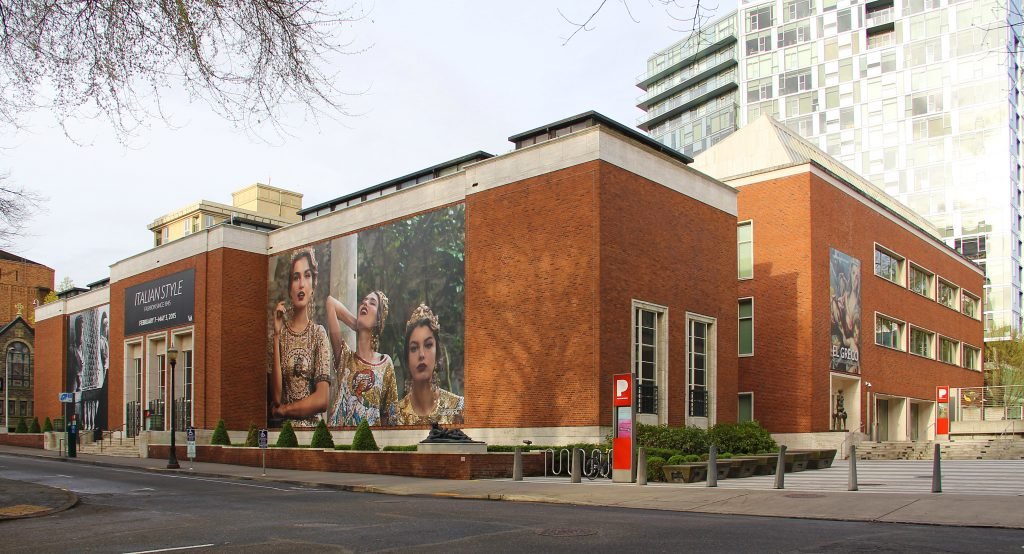


Joseon period (1392–1910), late 18th century/19th century,
pine wood with reverse-painted ox-horn.
5 3/4 in x 8 3/4 in x 8 3/4 in
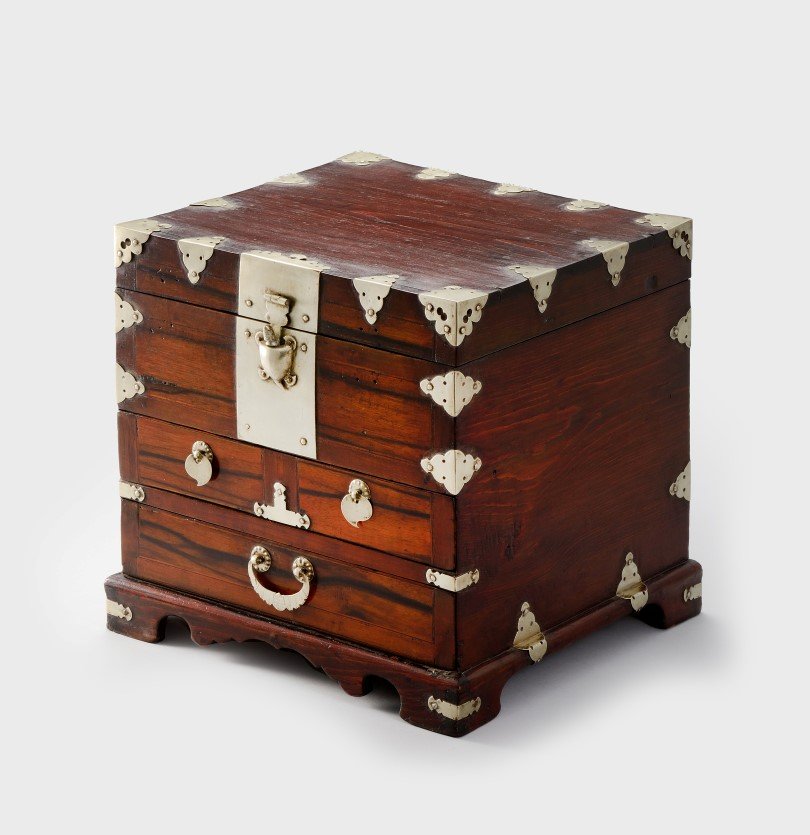
Gyeongsangnam-do province, Tongyeong area , Korea. 19th century, persimmon wood with white brass fittings.


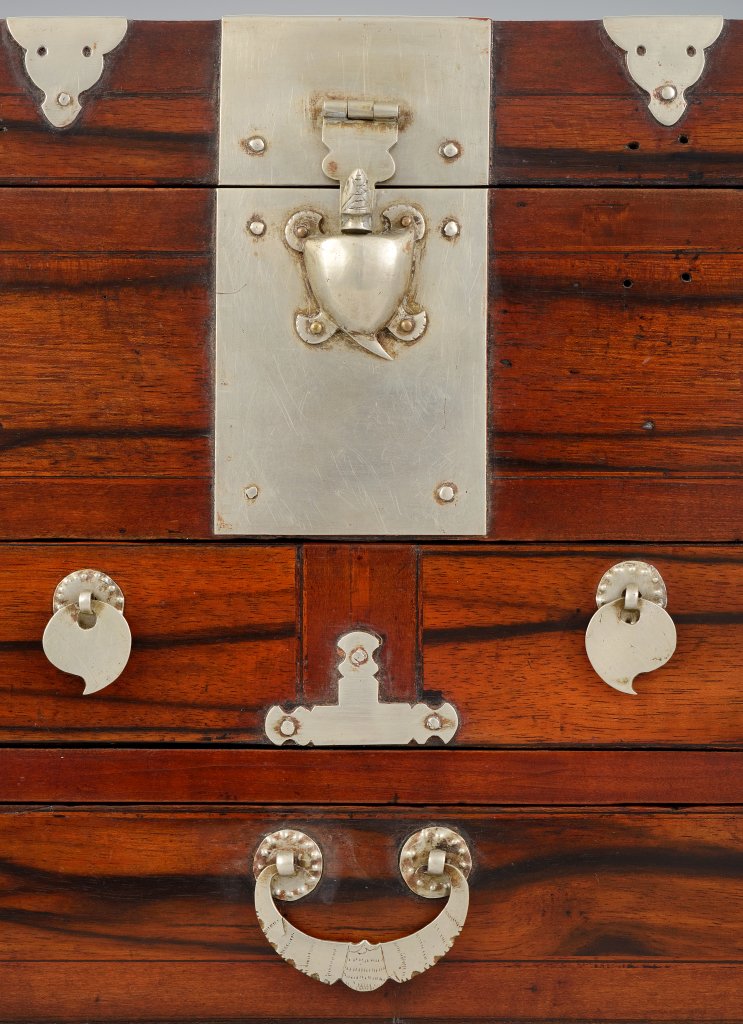
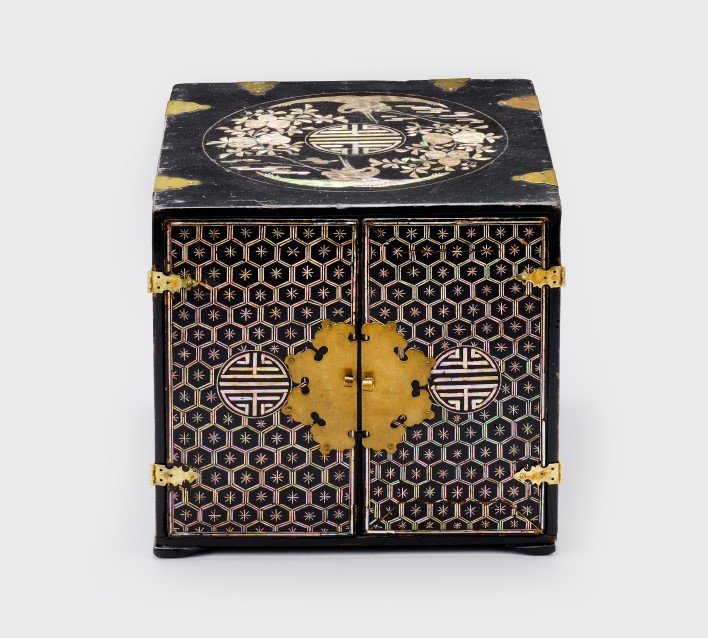
19th/early 20th century, Korea, Lacquered wood with shell inlay and metal fittings.
10 1/2 in x 11 1/2 in x 11 1/4 in.
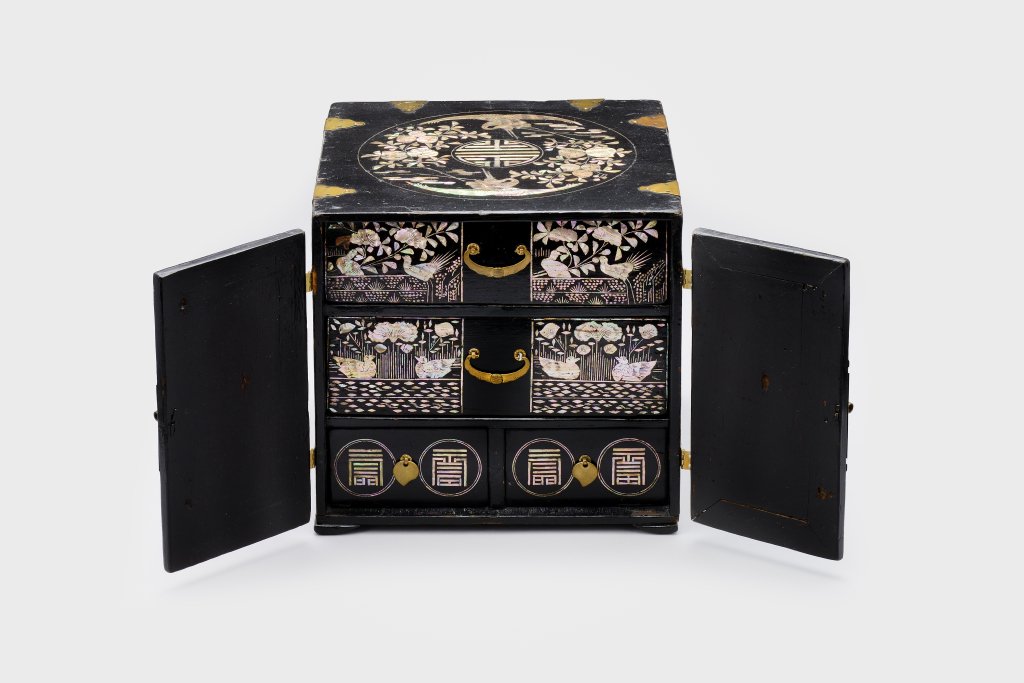
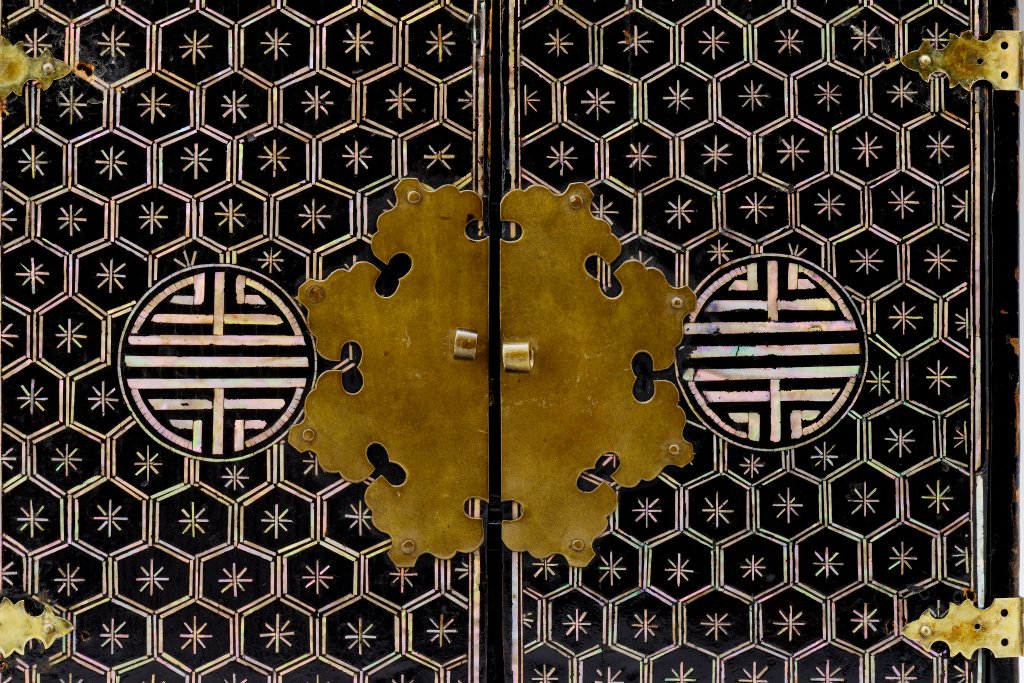

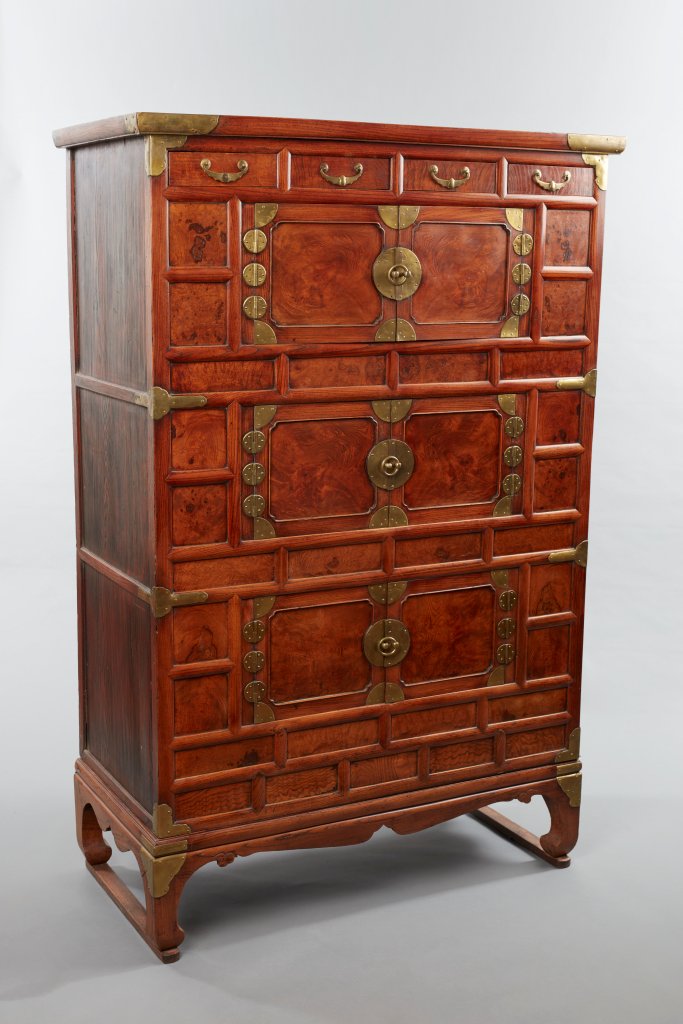
Chests for clothing storage were an essential part of the furnishings for the anbang, or women’s quarters, in an upper-class home during the Joseon dynasty. This three-tiered chest, or samcheungjang, is exceptional for the beautiful use of grained wood.
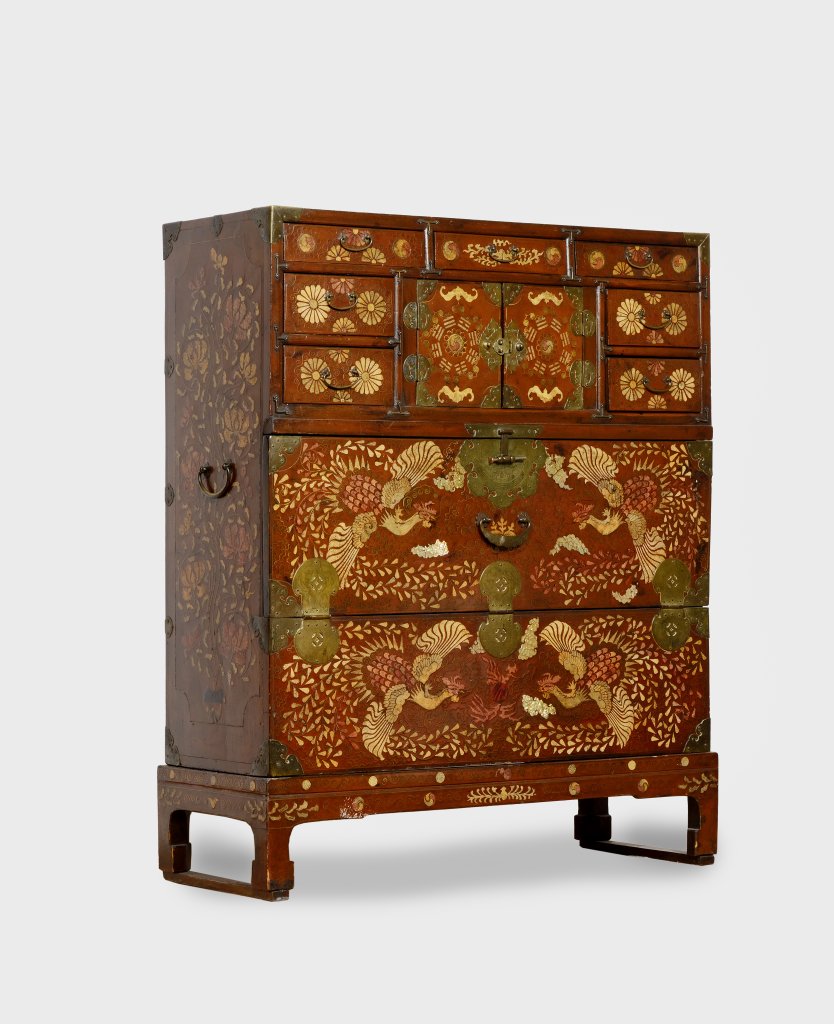
wood with amber lacquer, inlaid with sharkskin, tortoise shell, mother of pearl, and copper wire; brass fittings, 43 1/2 in x 36 in x 14 in. This cabinet is unusual in its form, which combines a set of drawers with a traditional bandaji clothing chest, and in its elaborate decoration, which combines both Korean and Japanese elements.
On the lower bandaji chest, two pairs of phoenixes, symbols of immortality and of queenly authority, are executed in tinted sharkskin outlined with inlaid gilt copper wire. They fly toward a flaming pearl of tortoise shell, and the surrounding clouds are fashioned from mother-of-pearl. The doors on the upper chest feature the taegeuk (interlocking spirals) and eight trigrams—ancient Daoist emblems of universal harmony—and bats, symbols good fortune. The drawers feature chrysanthemums, a traditional Japanese design element. Japanese influence appears also in the use of maki-e, a technique of sprinkling fine flecks of gold or silver over lacquer, for the ground pattern.
All the materials used here were rare and expensive and accessible only to the elite. With its harmonious blend of traditional and newly fashionable foreign designs, this chest would have been made for a woman of the highest social rank.
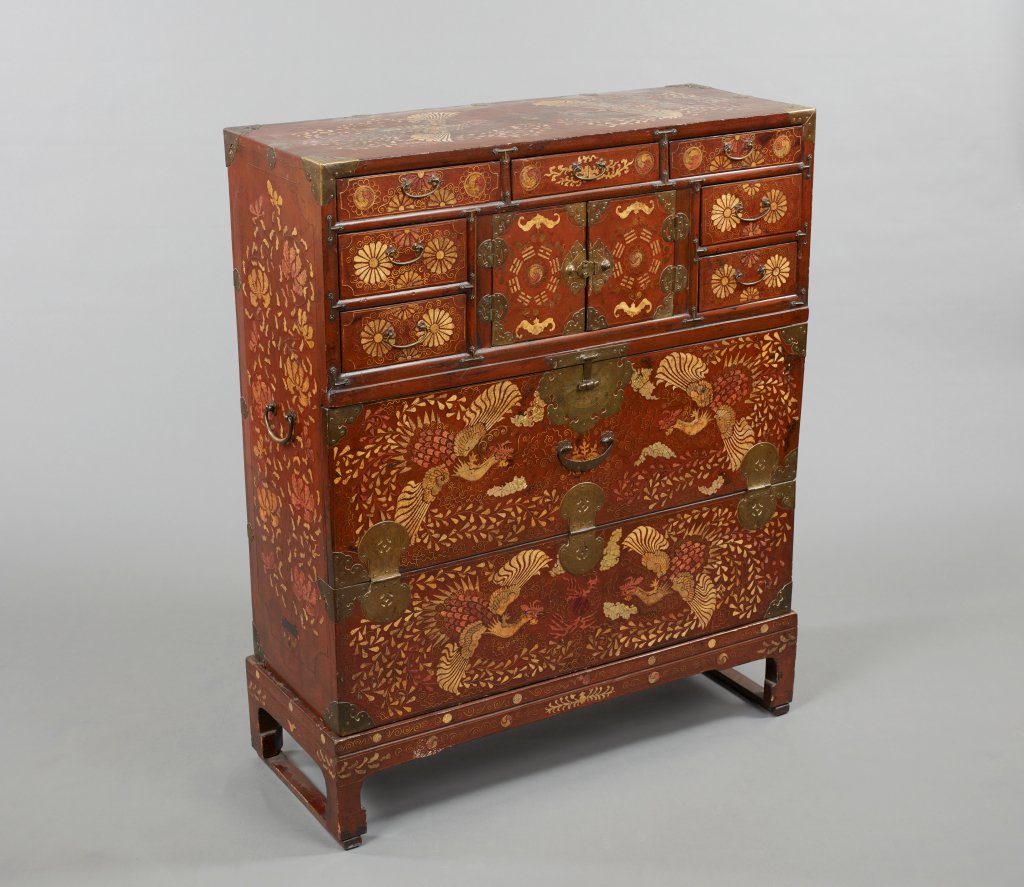
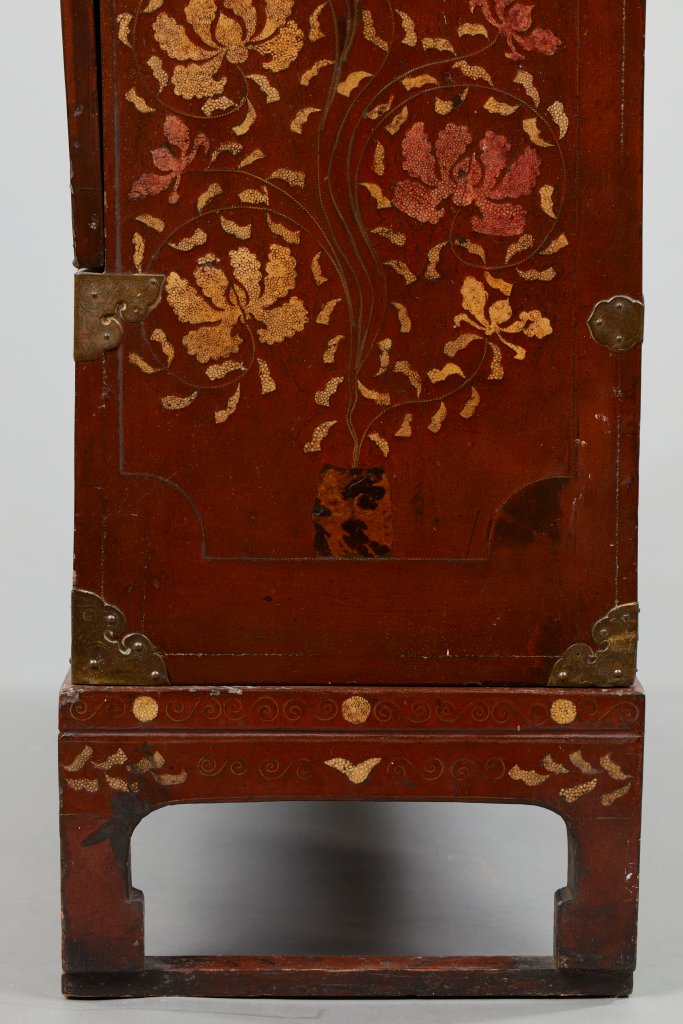
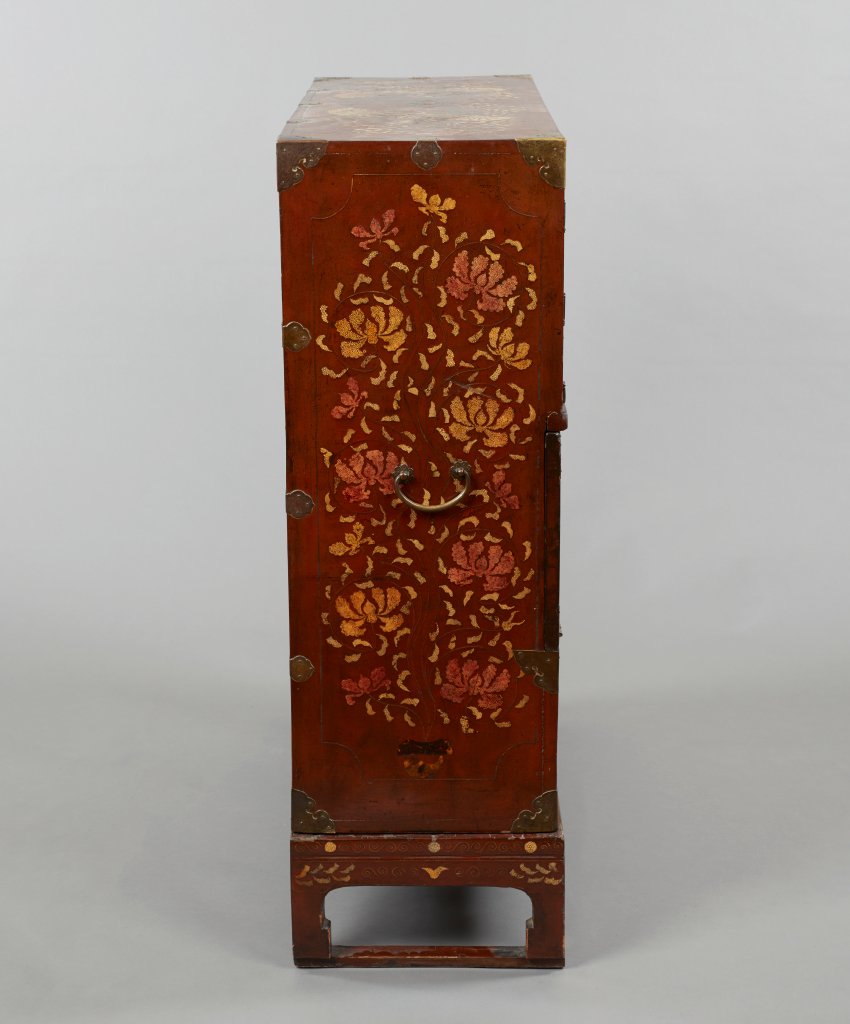

19th century, zelkova and persimmon wood. 9 1/2 in x 16 in x 8 1/2 in.
The scholar’s most prized piece of furniture, the yeonsang is a small compartmentalized box designed to store calligraphy tools: an inkstone, ink sticks, and water dropper, as well as paper. When the lid is closed, the yeonsang also serves as a side table, providing a place to put the inkstone when writing calligraphy.
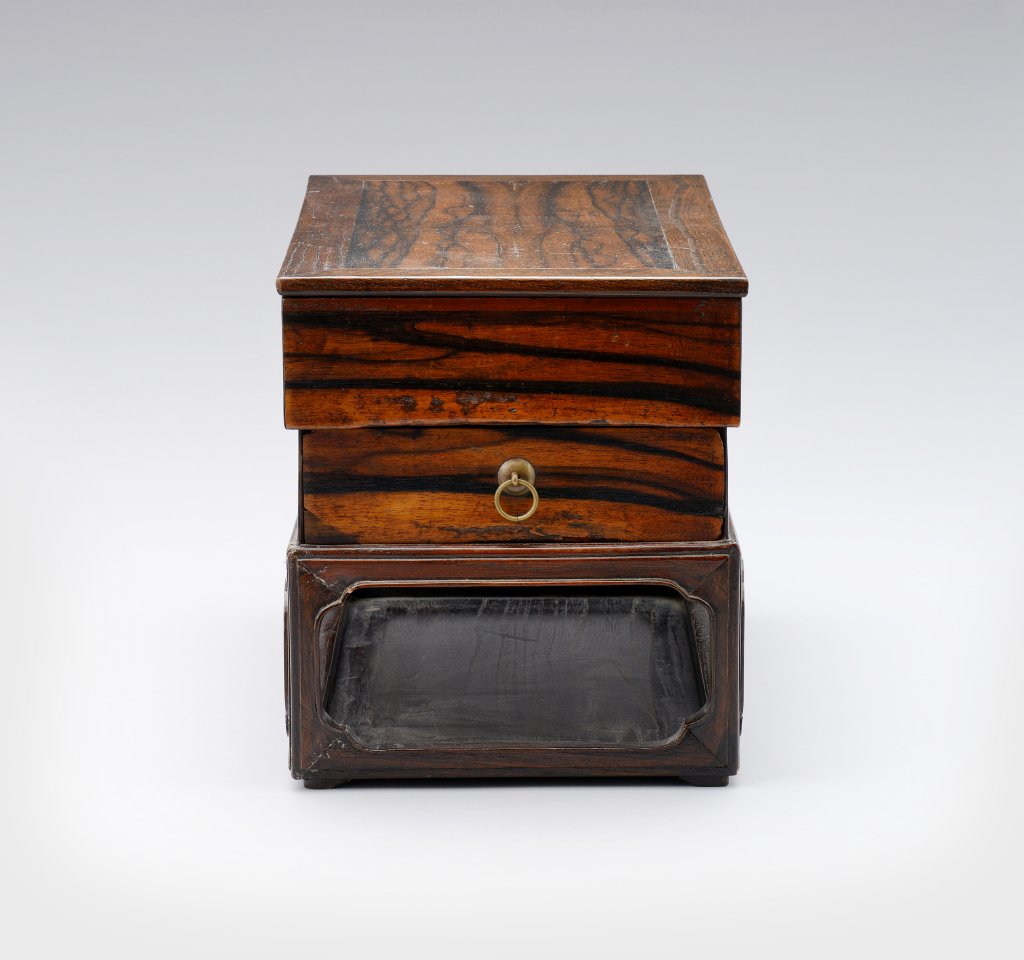
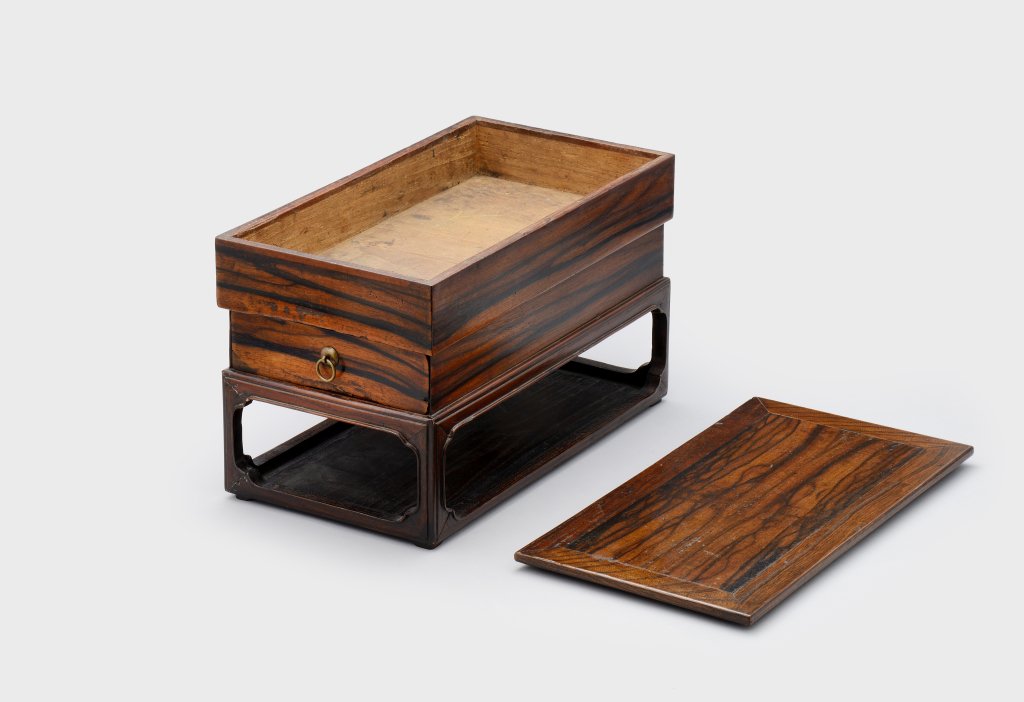
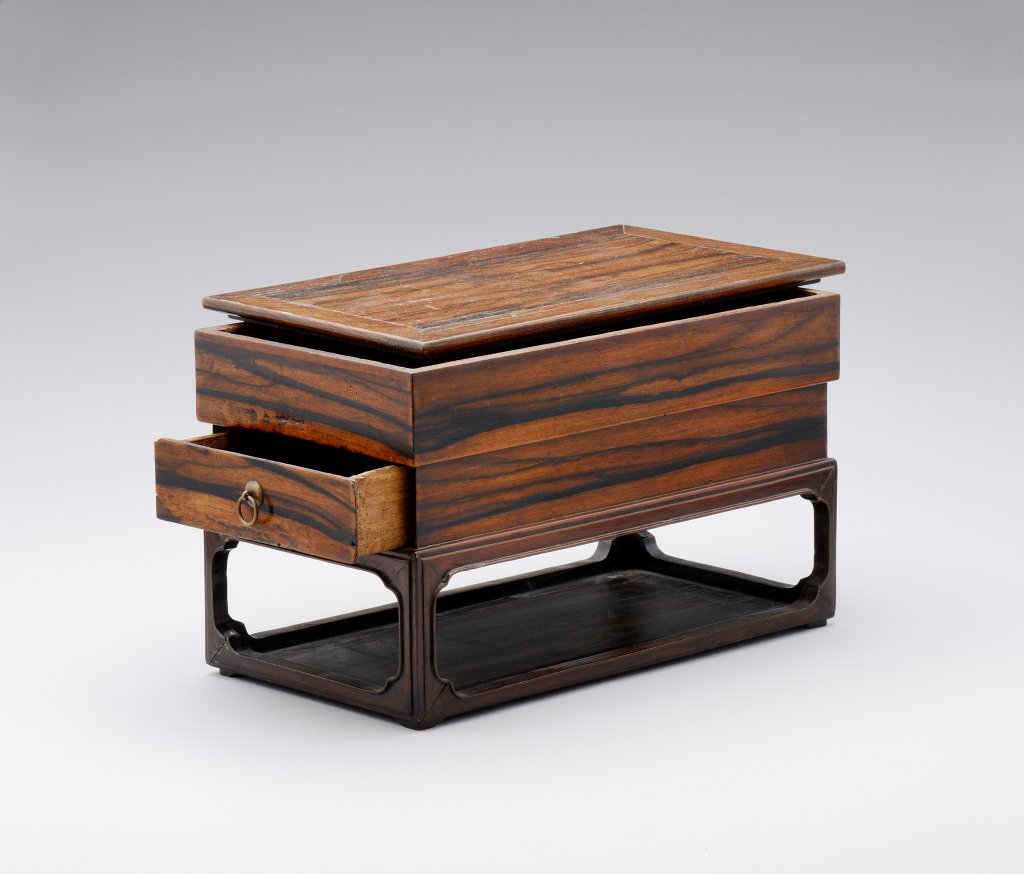
SEATTLE ASIAN ART MUSEUM
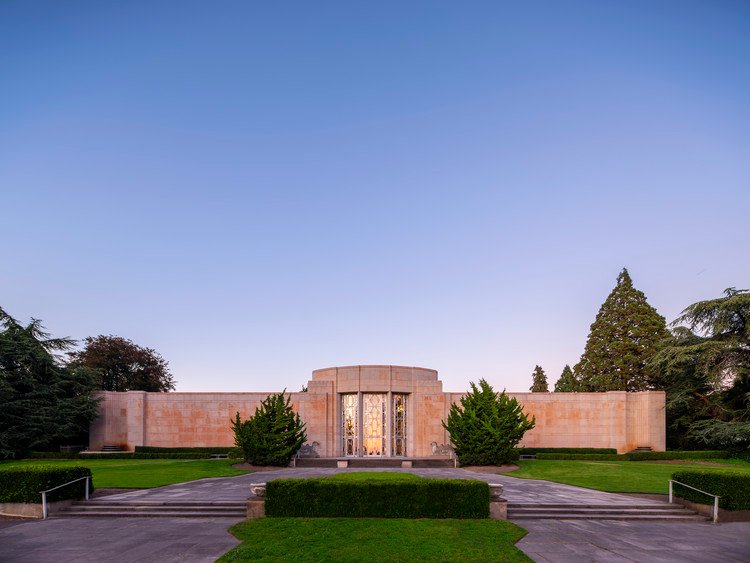
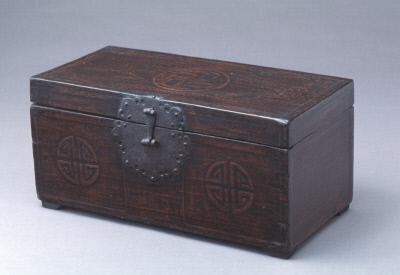
MID-LATE 19TH CENTURY
This fine box would have been presented as a wedding gift from the groom to the traditional Korean bride. The emblems on the front are stylized Chinese characters for long life, and the Buddhist swastika on the lid-an ancient motif of both India and China-is a symbol of good luck and many happy returns.
Wood, paper, and iron with an oil finish.
20.96 x 44.45 x 21.59 cm.
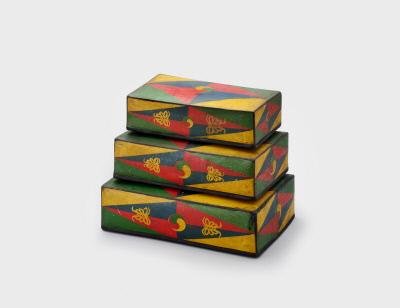
EARLY 20TH CENTURY
Laminated and painted paper. 13.3 x 46.4 x 30.5 cm.
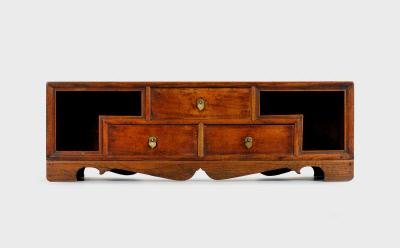
19TH CENTURY. (Photos left & right)
Wood, H. 10 in, W. 30 1/2 in, D. 8 1/8 in.
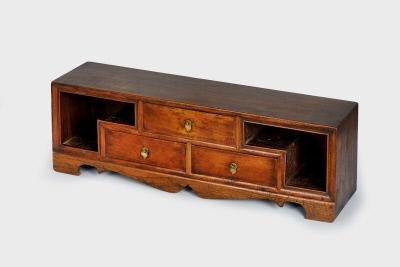

LATE 18TH-EARLY 19TH CENTURY
Black lacquer on wood, mother-of-pearl inlay,
18.5 x 37 x 23cm.
CLEVELAND MUSEUM OF ART.
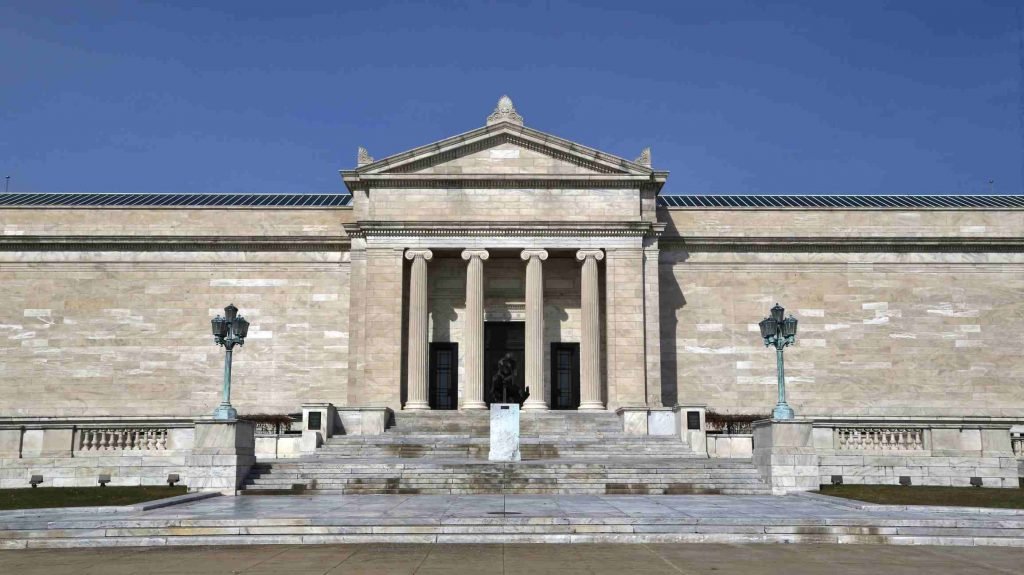
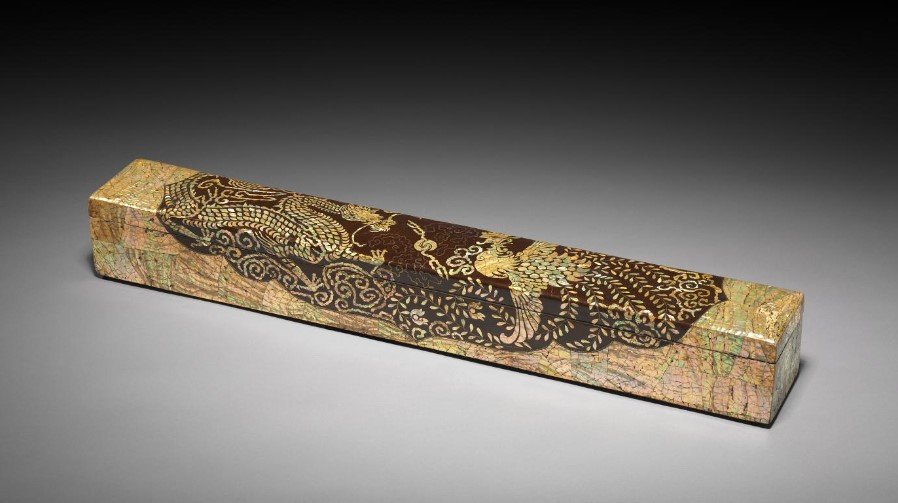
나전 용·봉황무늬 서류함 (螺鈿龍鳳文書類函)
1700s-1800s.
Lacquered wood inlaid with mother-of-pearl and twisted brass and copper wire
Overall: 11.5 x 11.6 x 87 cm.
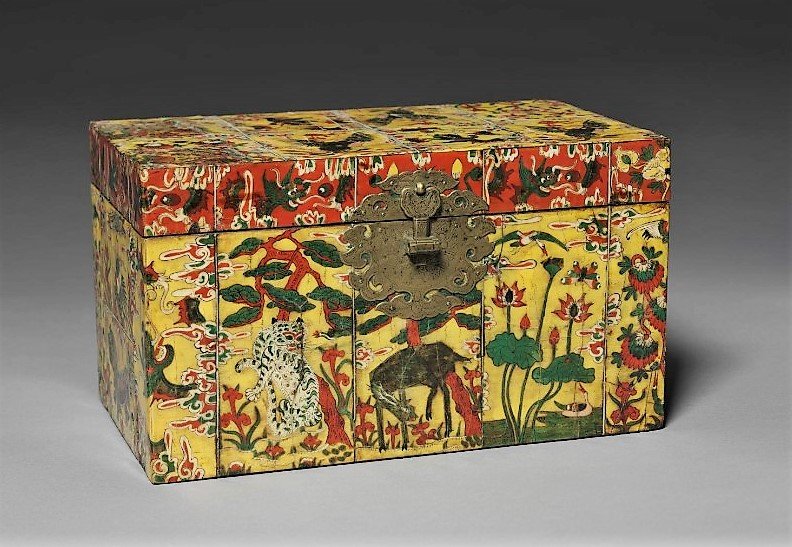
화각함 (華角函)
1800s. Painted wood with flattened ox-horn inlay
Overall: 16.5 x 28.6 cm
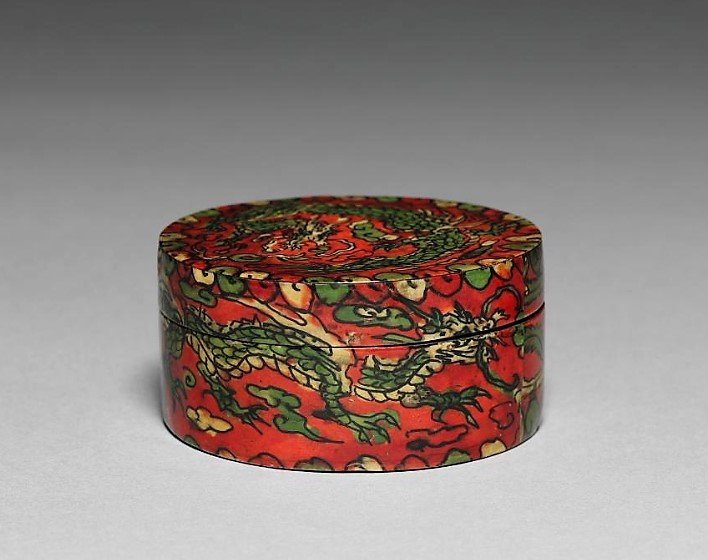
용무늬 화각함 (龍文華角函)
1900s. Painted wood with flattened ox-horn inlay
Diameter: 7.2 cm, Overall: 3.6 cm
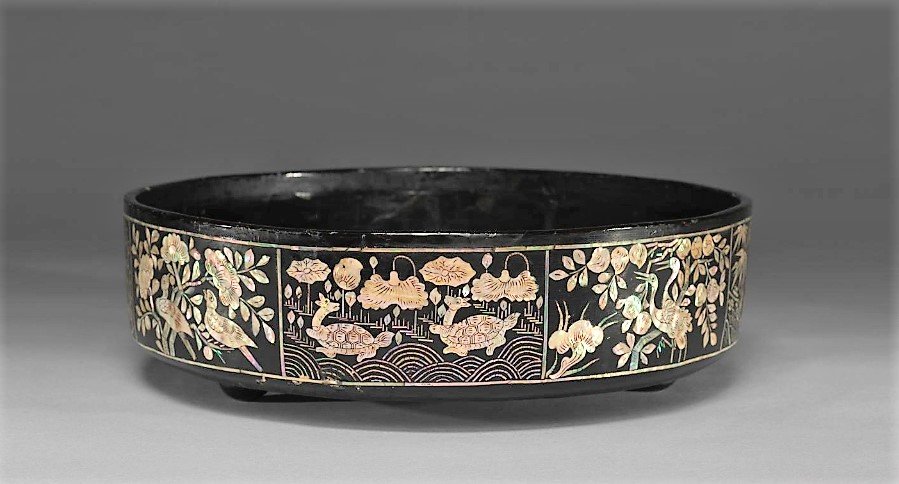
나전 칠기 반짇그릇 (螺鈿漆器箱子)
1800s. Lacquer with mother-of-pearl inlay
Diameter: 33.1 cm Overall: 9.6 cm.

지승사각반 (紙繩四角盤)
1900s. Lacquer over twisted and coiled paper
Overall: 34.2 x 9 x 9 cm
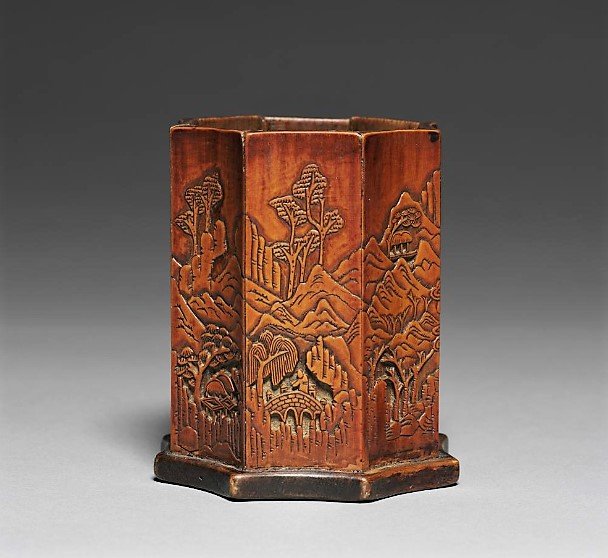
대나무 산수무늬 팔각필통 (竹山水文八各筆筒)
1800s. Carved bamboo. 10.1 x 9 cm
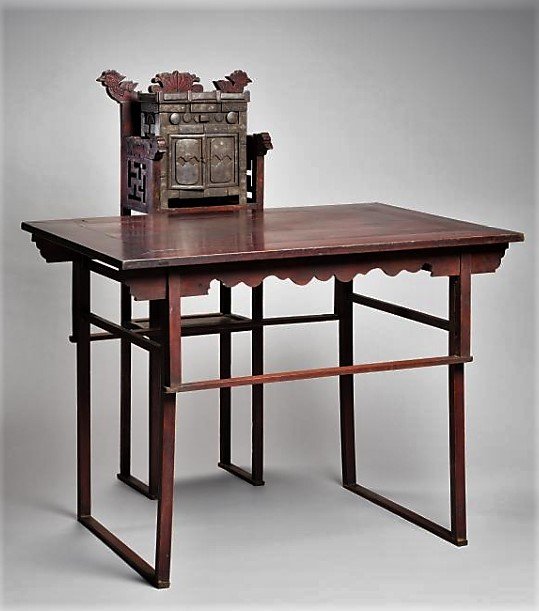
감실 (龕室). Late 1800s.
Iron inlaid with silver and copper decoration
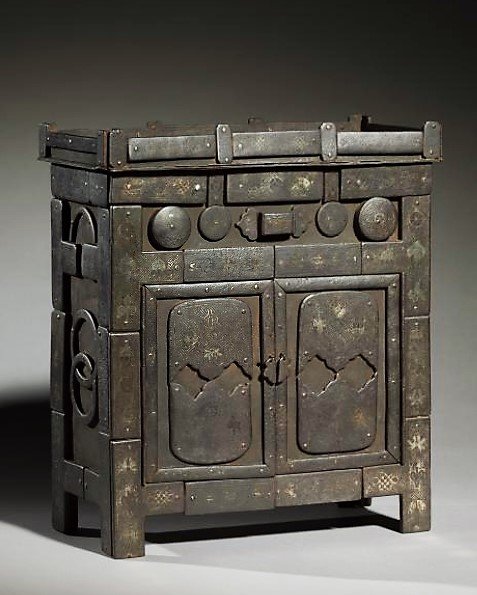
철제 은입사 감실 (鐵製銀入絲龕室)
late 1800s. Iron inlaid with silver and copper decoration. 30 x 35 x 14 cm.
Many homes in premodern Korean society had a memorial shrine for preparing and holding ancestral rites. Placed on the top of a tall chair, this miniature edifice (called the spirit house) served as a temporary residence for visiting ancestral spirits. On the table, a variety of delicacies such as fruits, rice, meat, and wine would be placed to treat those spiritual guests.
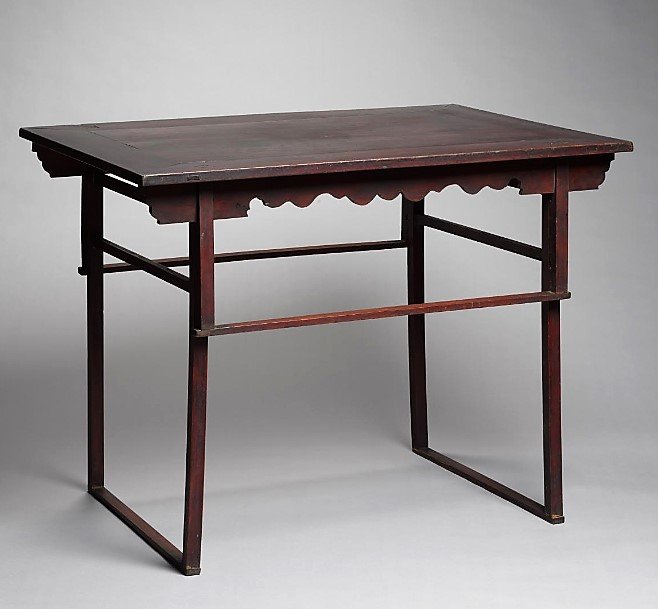
1900s. Pine nut wood
97.5 x 116 x 82.5 cm
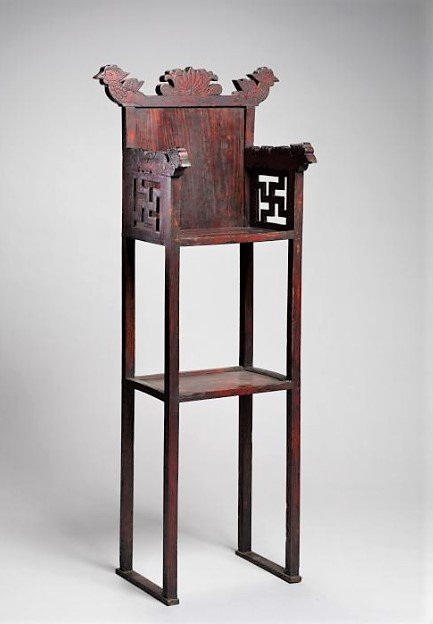
영좌교의 (靈座交椅)
1800s. Pine nut wood
128.4 x 52 cm
THE BROOKLYN MUSEUM
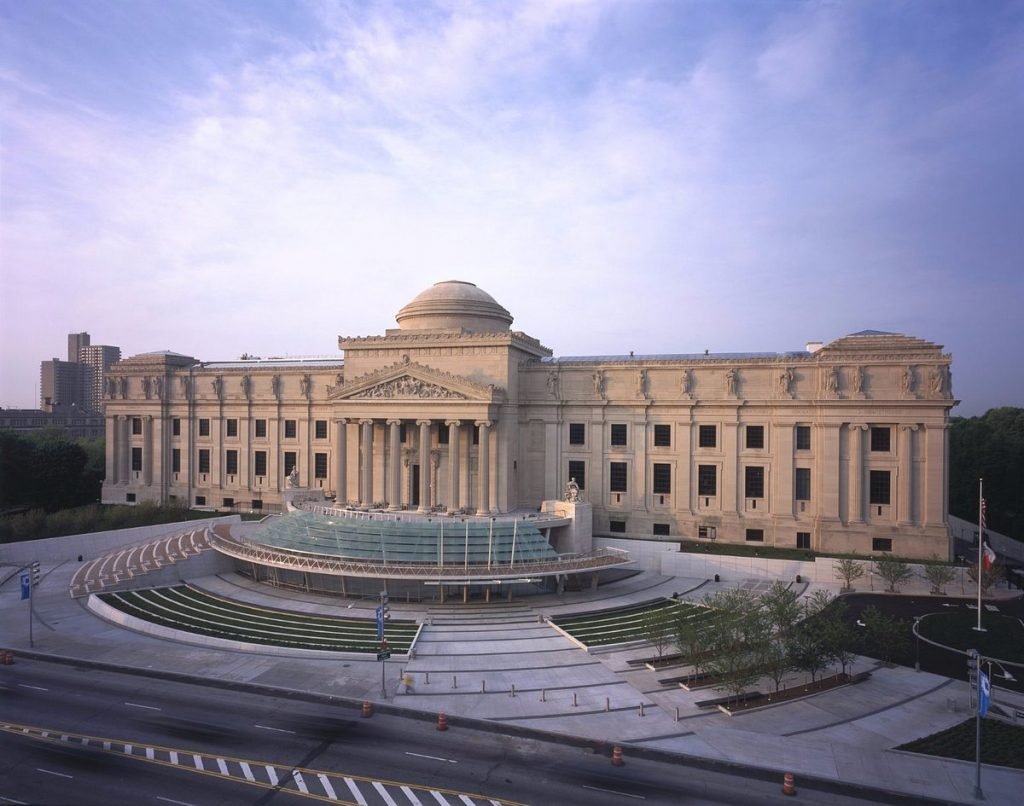
NOTE FROM THE MUSEUM.
Throughout its history, the Korean peninsula has been home to lively, innovative, and sophisticated art-making. Long periods of relative stability have allowed for the establishment of spiritual traditions, societal values, and artisan technologies specific to the region.
- Furnishings for Official Use in the Joseon Dynasty
For the five hundred years of its rule, the Joseon dynasty promoted Confucianism as the official religion and guiding ethos of the Korean nation. Under Confucianism, indulgence in frivolous luxury was strongly discouraged and men in particular were expected to adopt a very restrained style in both personal garments and home furnishings. However, for the official ceremonies and regalia of the royal court, a degree of pomp and beauty was deemed appropriate.
The items displayed in this case would have been worn or used by men of the yangban, or aristocratic, class, who served as military and government officials. All of these men would have received their education in Confucian academies, and as civil servants they were expected to maintain the social and political order set out in Confucian and Neo-Confucian teachings. In these teachings, the government is a macrocosm of the family, with the king and queen serving as the esteemed parents of the nation, and the previous royal families serving as its hallowed ancestors. Both government and military men were required to participate in a busy schedule of court rituals that celebrated the Confucian social order and were expected to conduct smaller ancestral rituals at home. - Decorative Furnishings for the Women’s Quarters
In the strict social order dictated by Joseon-period Confucianism, women led lives that were almost entirely separate from those of men. The homes of wealthy Koreans were designed to allow men and women to entertain visitors of their own gender without ever interacting or even seeing each other.
In addition to a division of labor—women took care of the home and children while men pursued public roles and engaged in lifelong scholarship—Korean domestic life witnessed a division of aesthetics. While the men’s quarters were sparsely equipped with simply finished wood furniture and paintings with strong didactic messages, the women’s quarters could be decorated with bright embroidered pillows, elaborately inlaid cabinetry, and paintings bursting with birds and flowers.
Because furnishings made for women were so much more decorative, Western museums—including the Brooklyn Museum—often collected them, neglecting the more staid and minimalist pieces that were designated for men. It is only in more recent history that Western collectors have come to understand that male connoisseurs would have rejected the ornament of women’s furnishings as frivolous and distracting.
In addition to the pieces that would have graced the rooms where women lived, this display includes several objects that relate to traditional Korean wedding ceremonies. Weddings were a major rite of passage, especially for women, who had to leave their own families to join the husband’s household. As in so many cultures, weddings gave the bride a brief taste of aristocracy, allowing her to dress and be served like a princess before returning to the realities of daily life.


87.6 x 52.1 x 64.1 cm
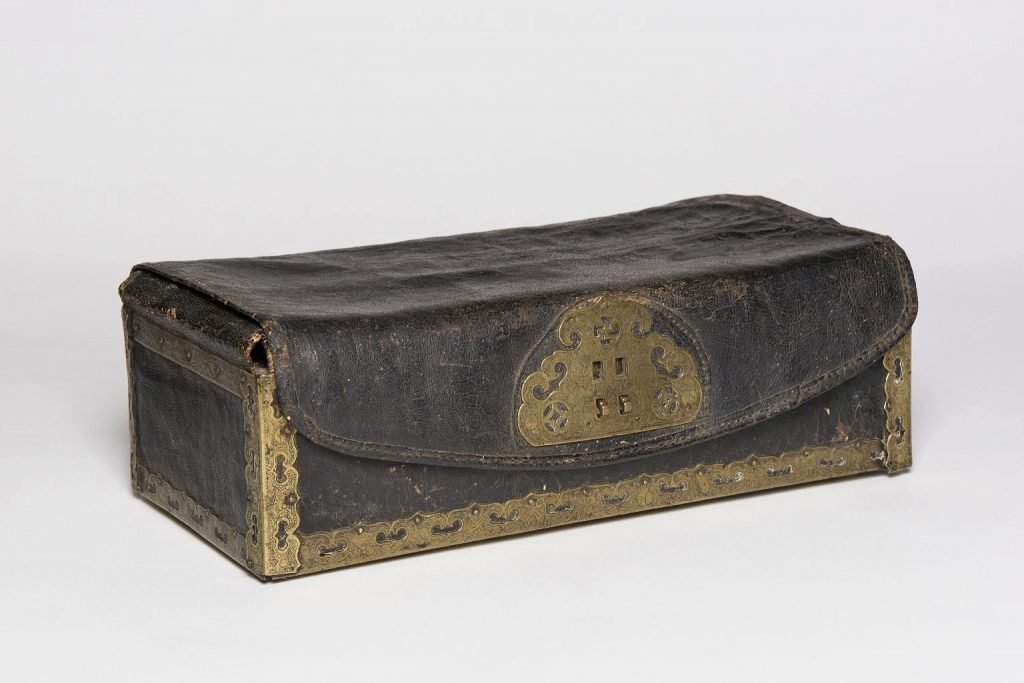
15.2 x 45.1 x 23.5 cm
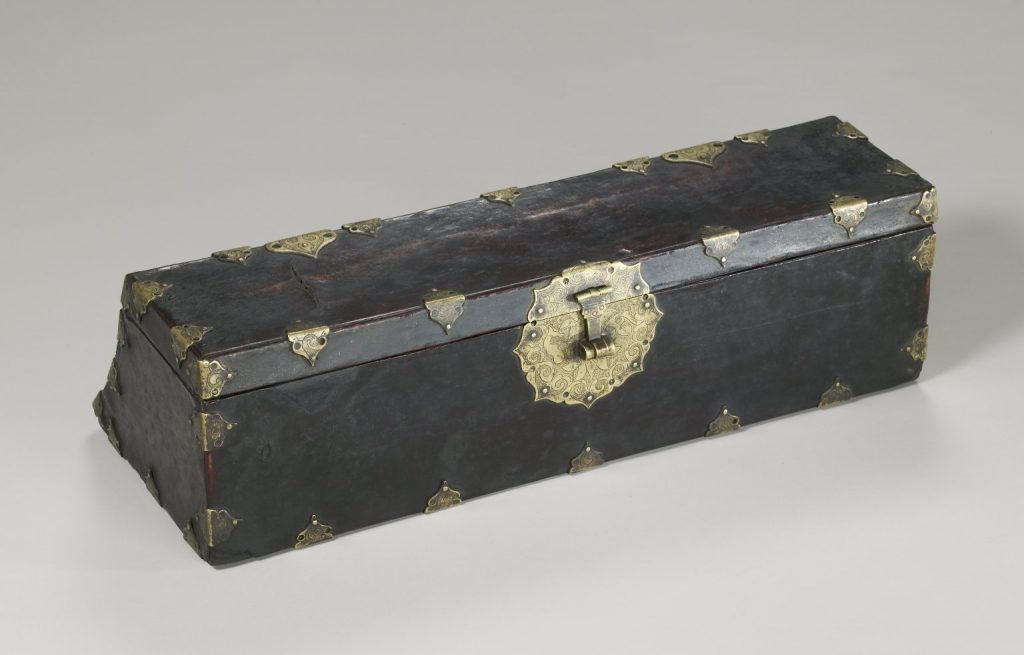
leather, lacquer. 17th – 18th century.
12.7 x 17.8 x 43.8 cm
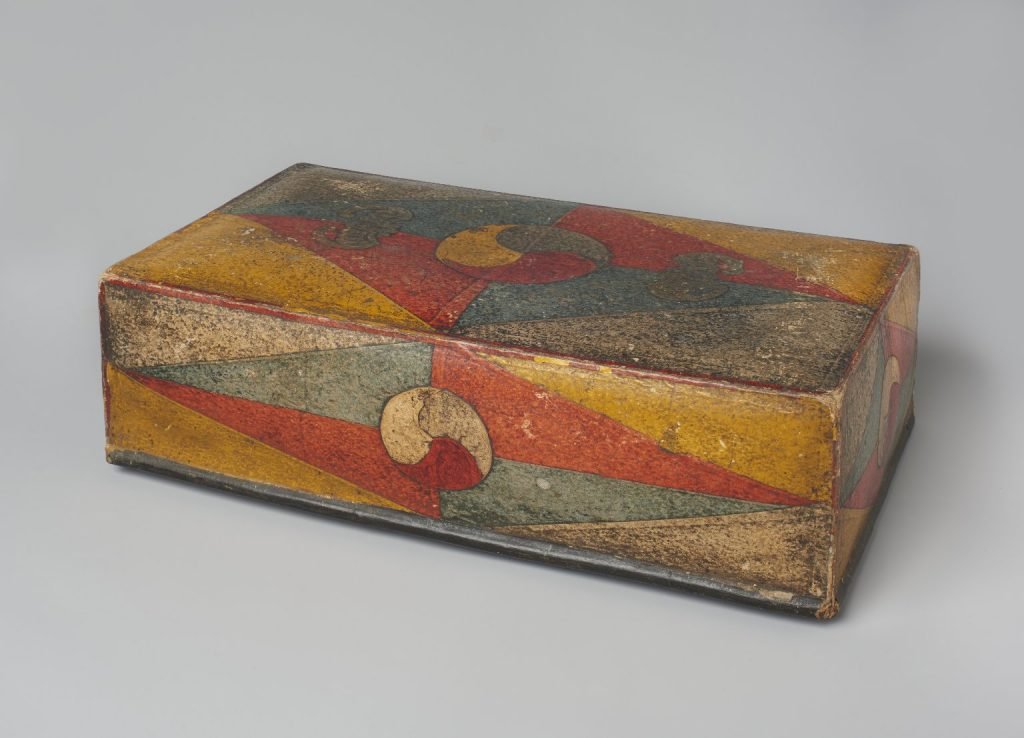
10.2 x 20.3 x 33.7 cm

18.3 x 26.5 x 17.2 cm
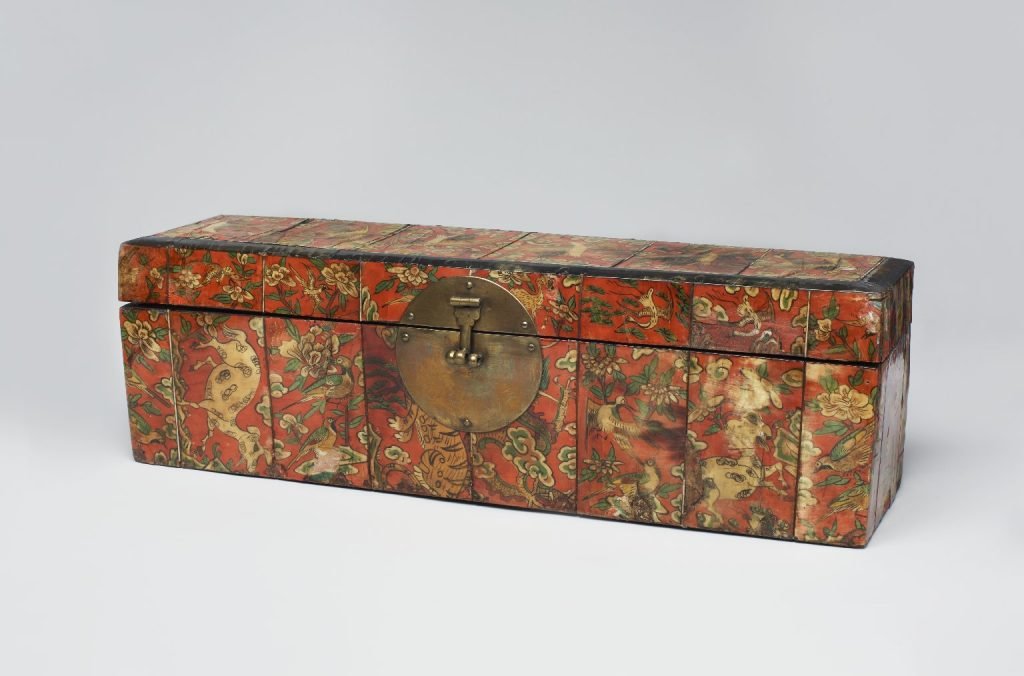
Late 19th – early 20th century. 12.5 x 42 x 11.2 cm
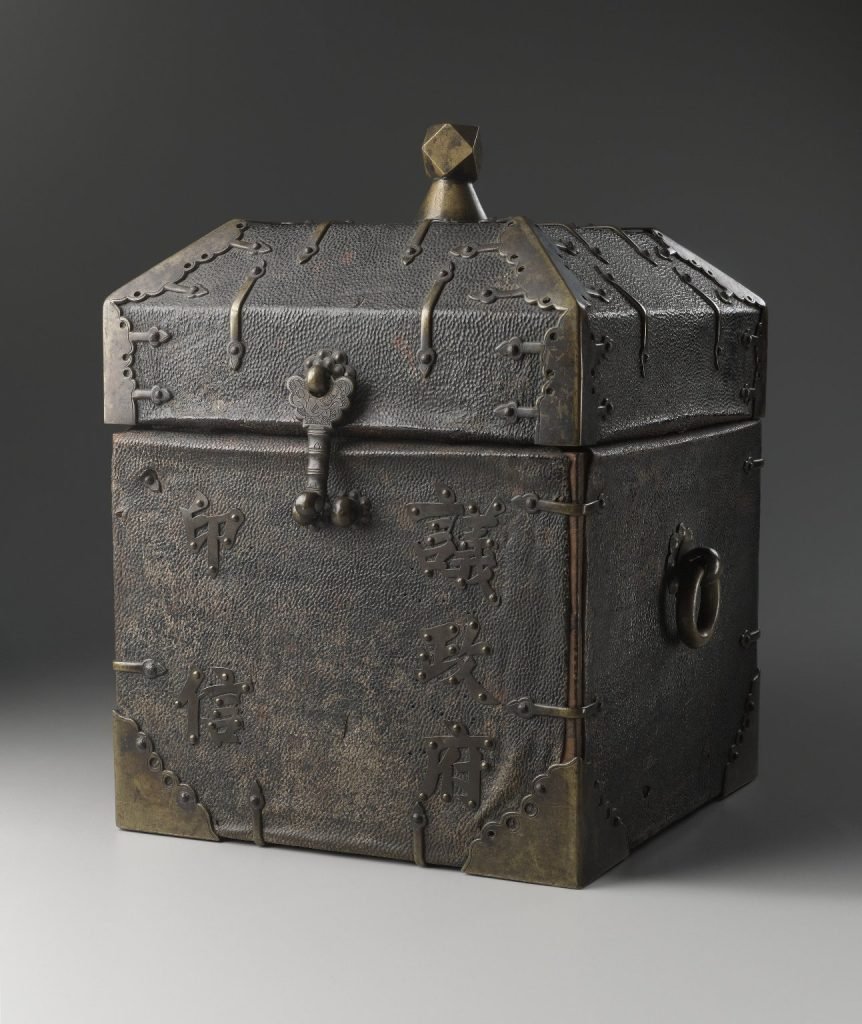
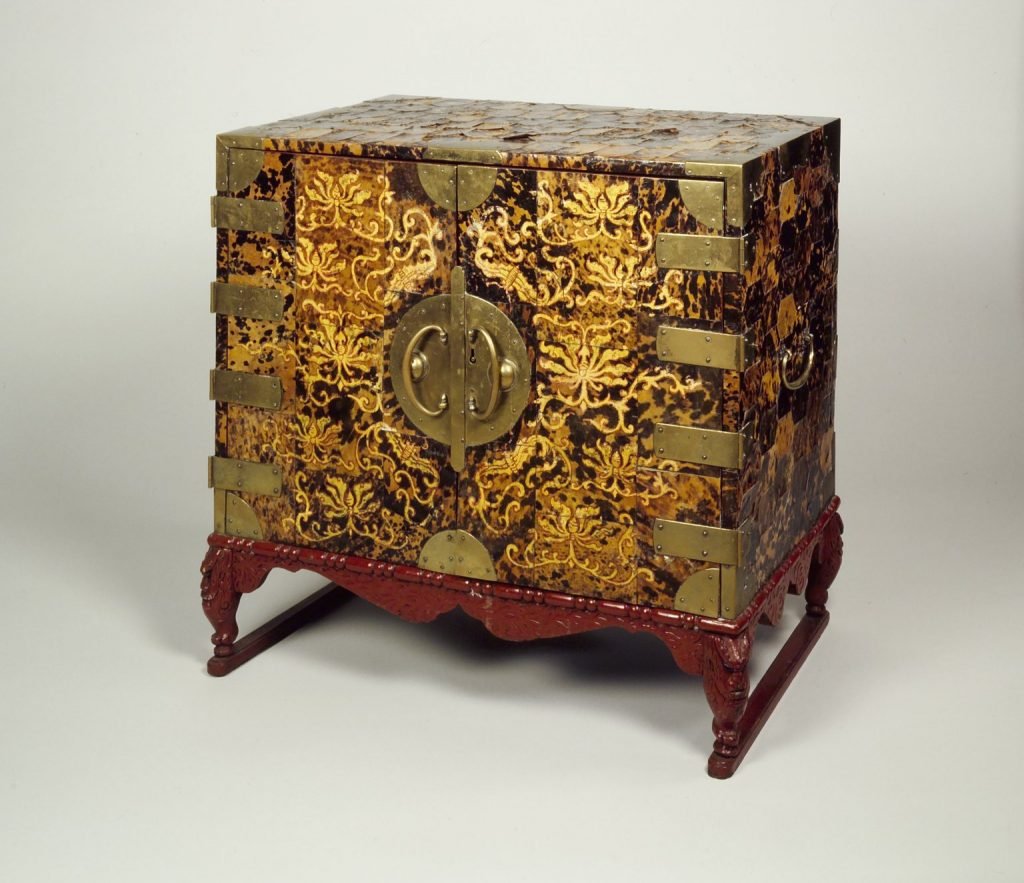
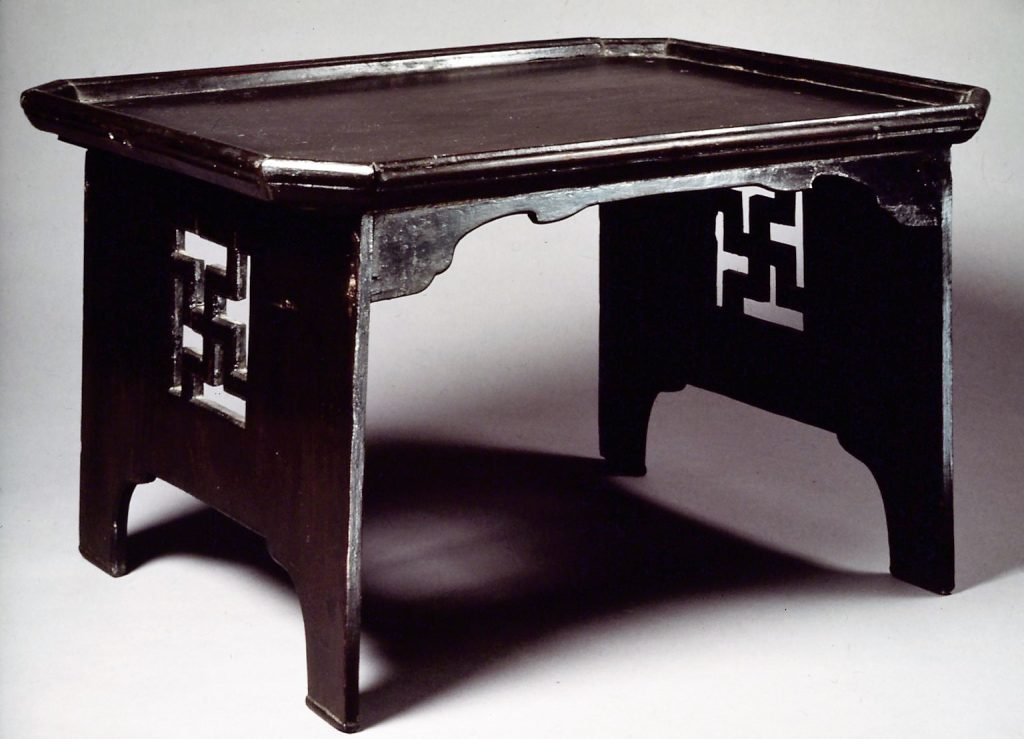
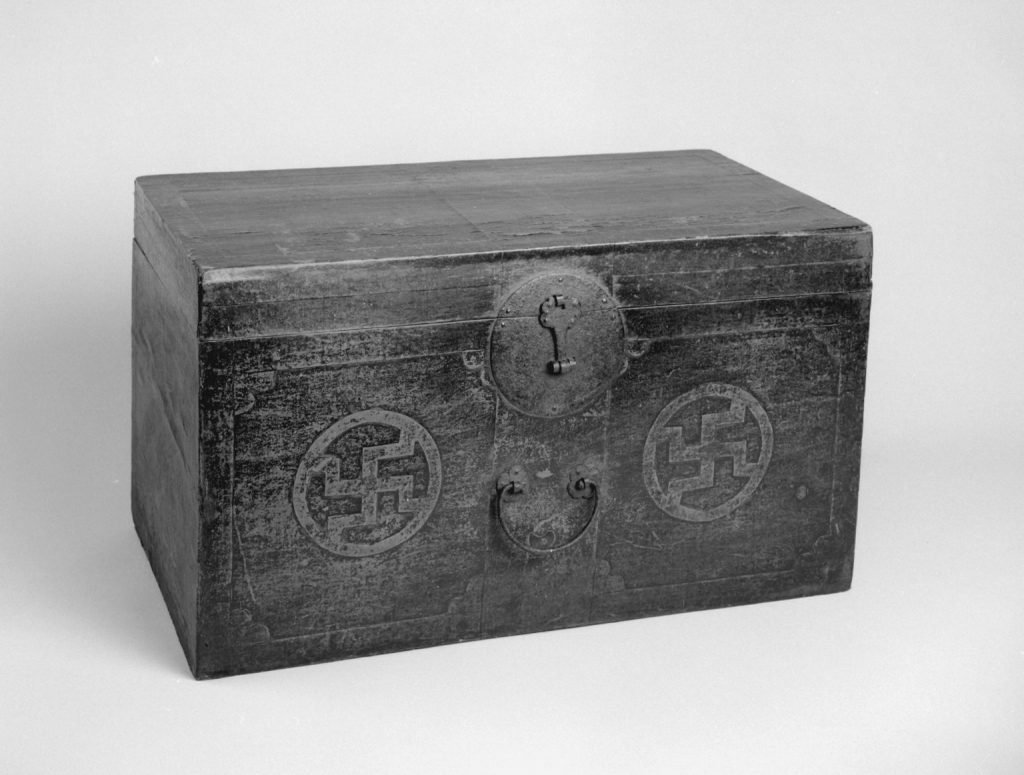
Early 20th century. 39 x 69.5 x 36.3 cm.

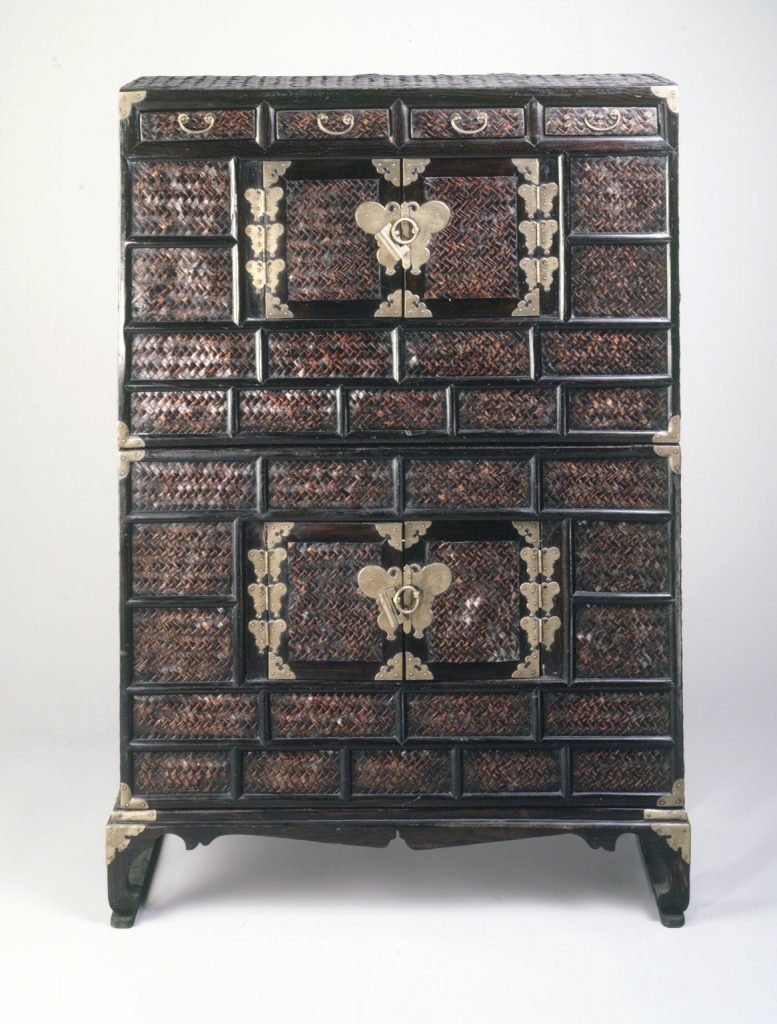

Early 20th century. 125.4 x 74.9 x 36.8 cm.
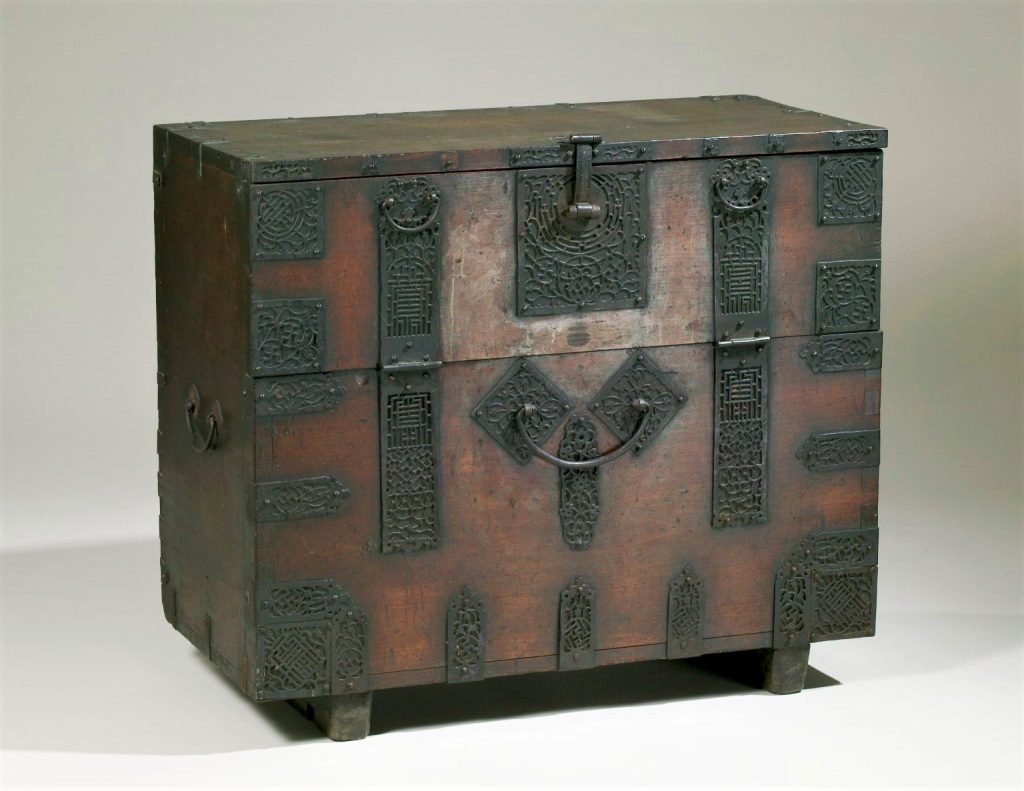
71 x 85.1 x 40.8 cm

DETROIT INSTITUT OF ARTS
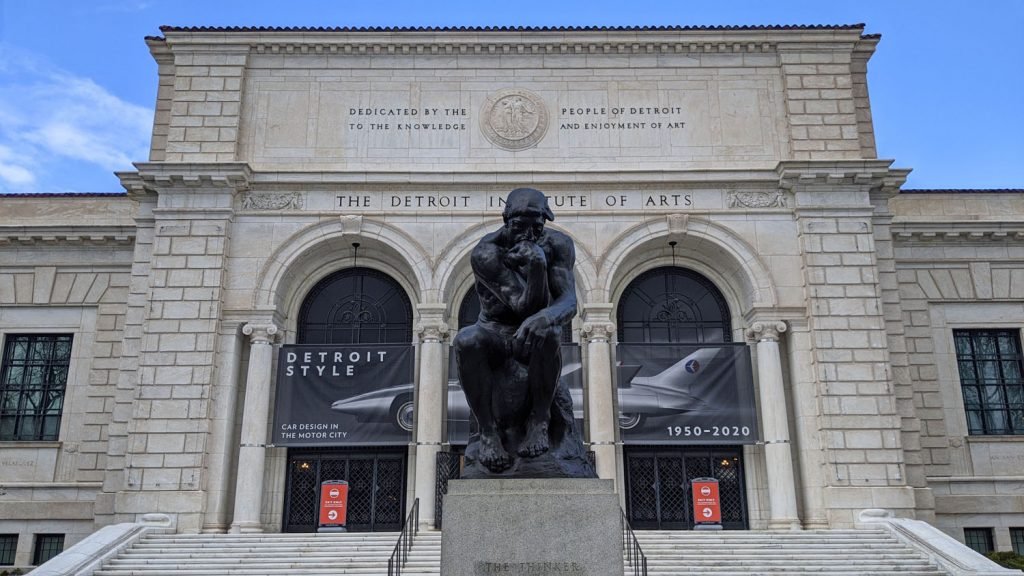

Korean
Lacquer inlaid with mother of pearl and twisted wire on wood
H. 14cm, W. 50,2cm, D. 27,9 cm.
Scholars were collectors of art and arbiters of taste. Small tables were used as trays and pedestals for useful objects. Floral scrolls are an enduring theme on Korean lacquer work. Koryŏ lacquers are noted for their impressive floral designs executed in inlaid wire and mother-of-pearl.
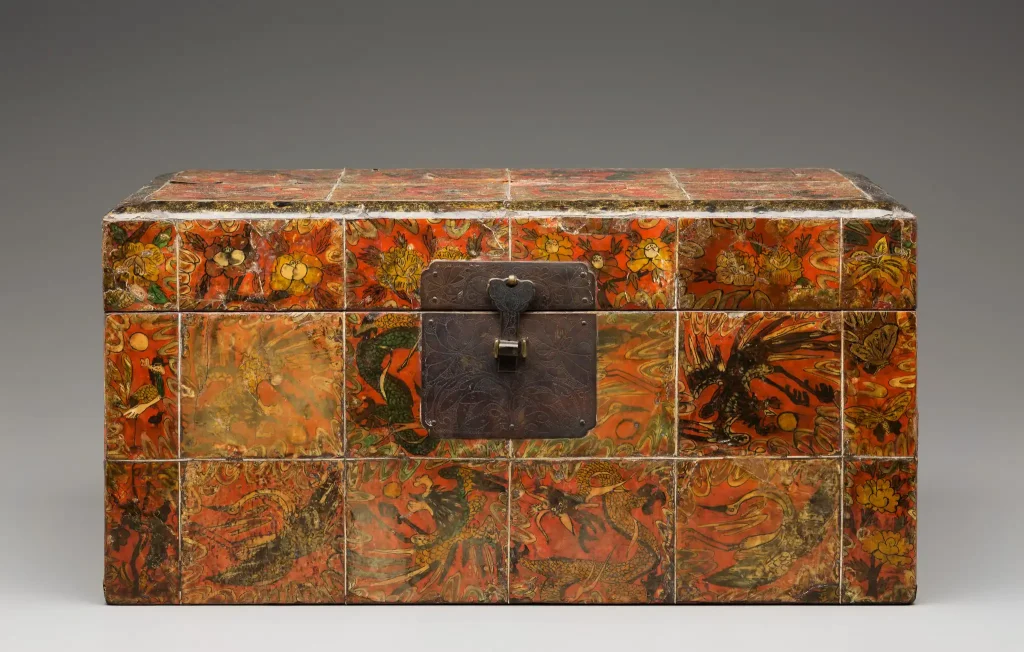
Korean
Ink and paint on ox horn panels on wood, ray skin, and metal
H. 26cm, W. 52,7cm, D. 31,1 cm.
Ox horn decoration, known as hwagak, was unique to Korea and mainly used for sewing boxes, small chests, and clothes boxes of high-born women. Each panel is a self-contained scene of propitious images: the paired dragon and phoenix are emblems of masculinity and femininity; the deer, crane and tortoise symbolize long life; and birds, flowers, and butterflies signify marital bliss. The laborious and time-consuming hwagak technique requires a horn to be soaked or steamed with water, flattened, separated into thin layers, cut into uniform rectangles, painted on the reverse side, and glued to a wooden frame with the painted side facing inward. Finally, the outer surface was polished to a brilliant luster. The finished work shows us an exuberant view of the Chosŏn woman’s world.
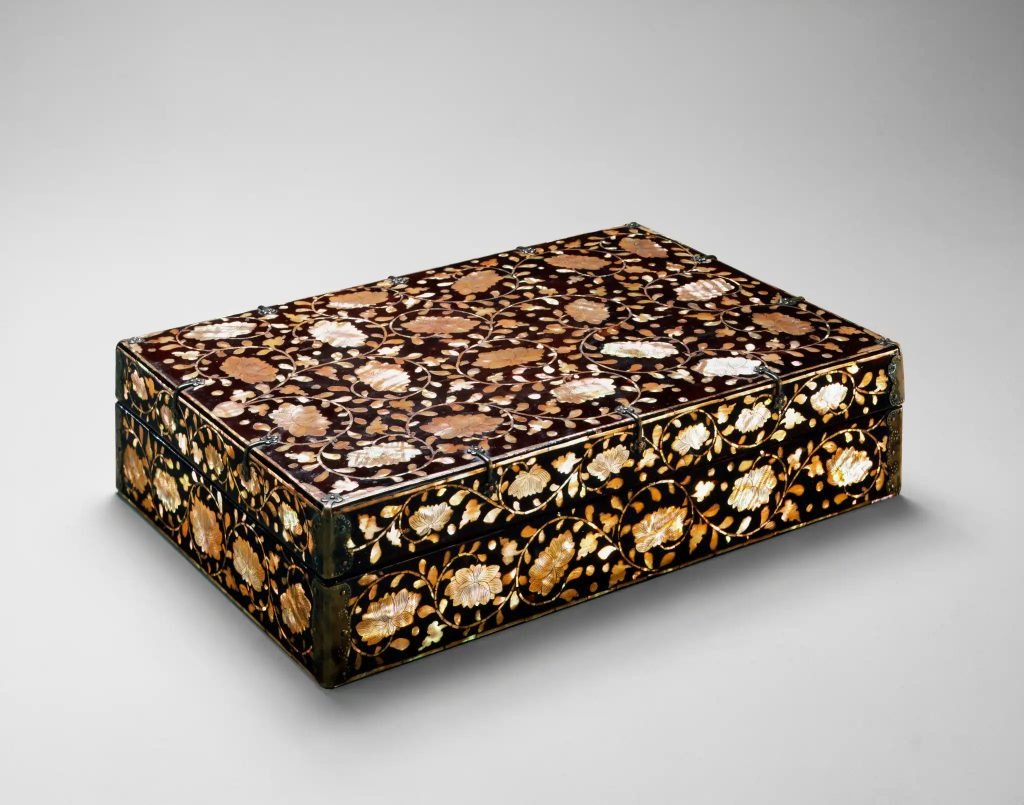
Lacquer on wood with mother-of-pearl inlay
H. 9,2cm, W. 39,4cm, D. 27,3 cm.
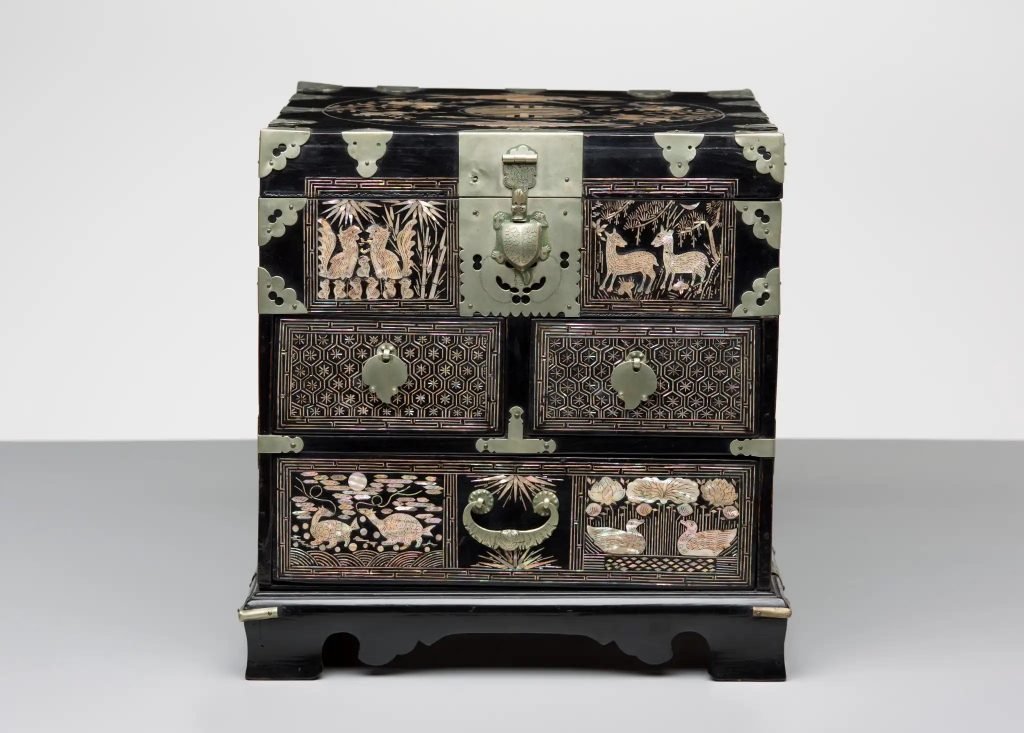
Korean
Wood, lacquer, mother-of-pearl, metal
H. 31,8cm, W. 29,8cm, D. 29,2 cm.
SMITHSONIAN- NATIONAL MUSEUM OF ASIAN ART.
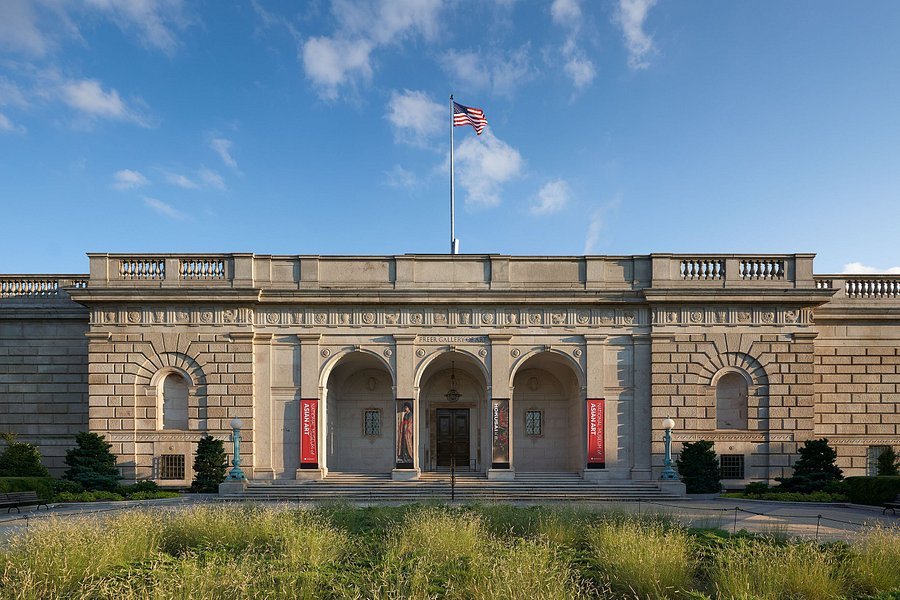
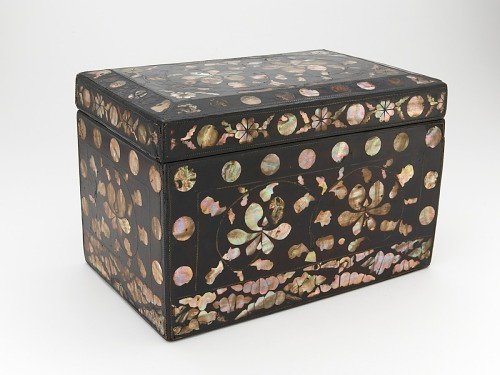

H x W x D: 8.3 × 19.8 × 1.5 cm

Burial chest, formed of six slabs of stone mortised and grooved; a separate slab bears an epitaph.
Stone. Brownish earth incrustation.
Decoration: incised on the inner walls, animals of the four quarters.
Inscription: Choe Hyo-jeo 崔孝著 (12th century)
HARN MUSEUM OF ART.


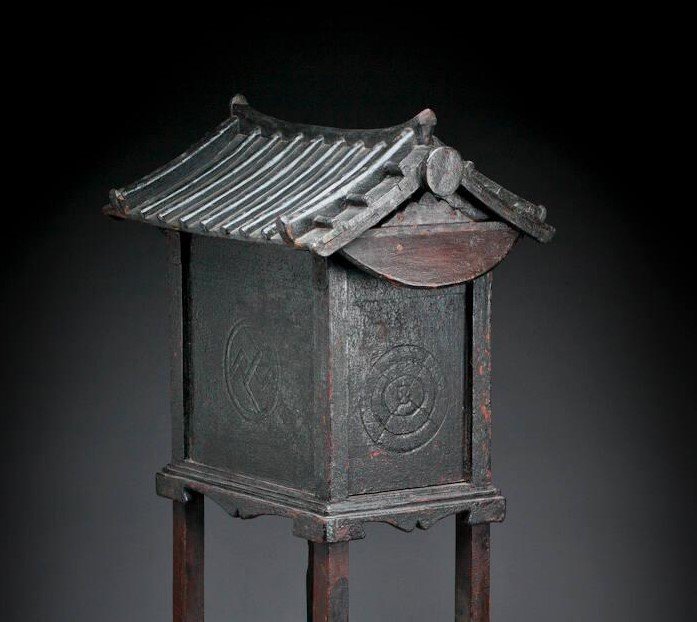
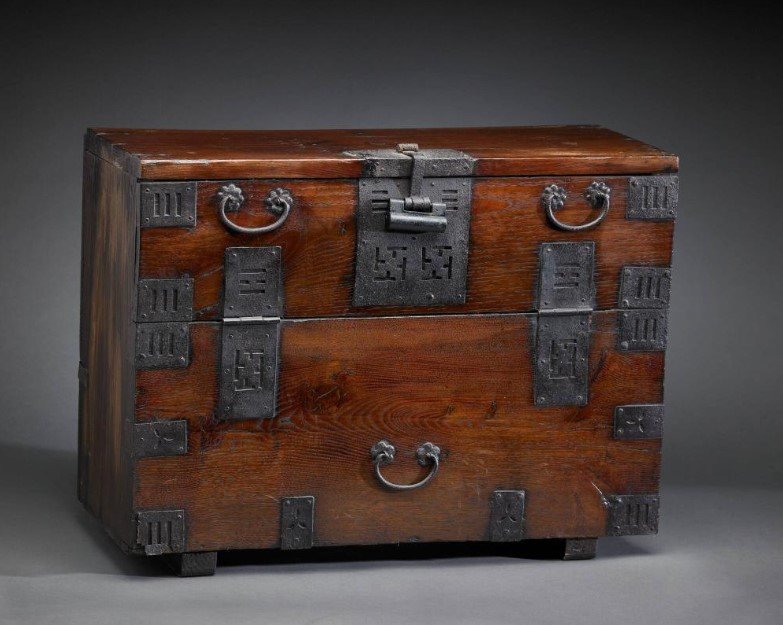
Late 19th-Very Early 20th Century. 46,4 × 60,3 × 25,4cm.

85,7 x 48,3 x 101cm.

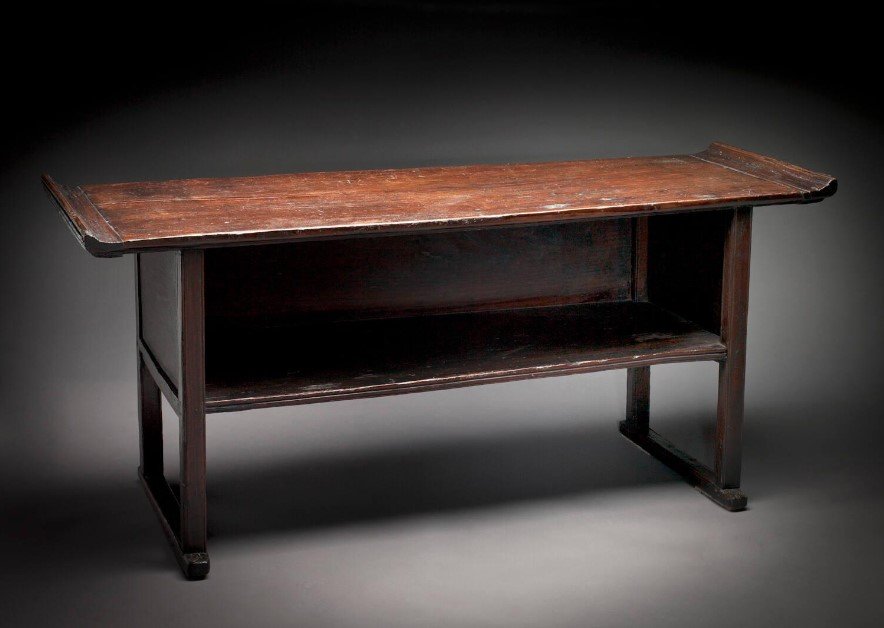
JORDAN SCHNITZER MUSEUM OF ART.


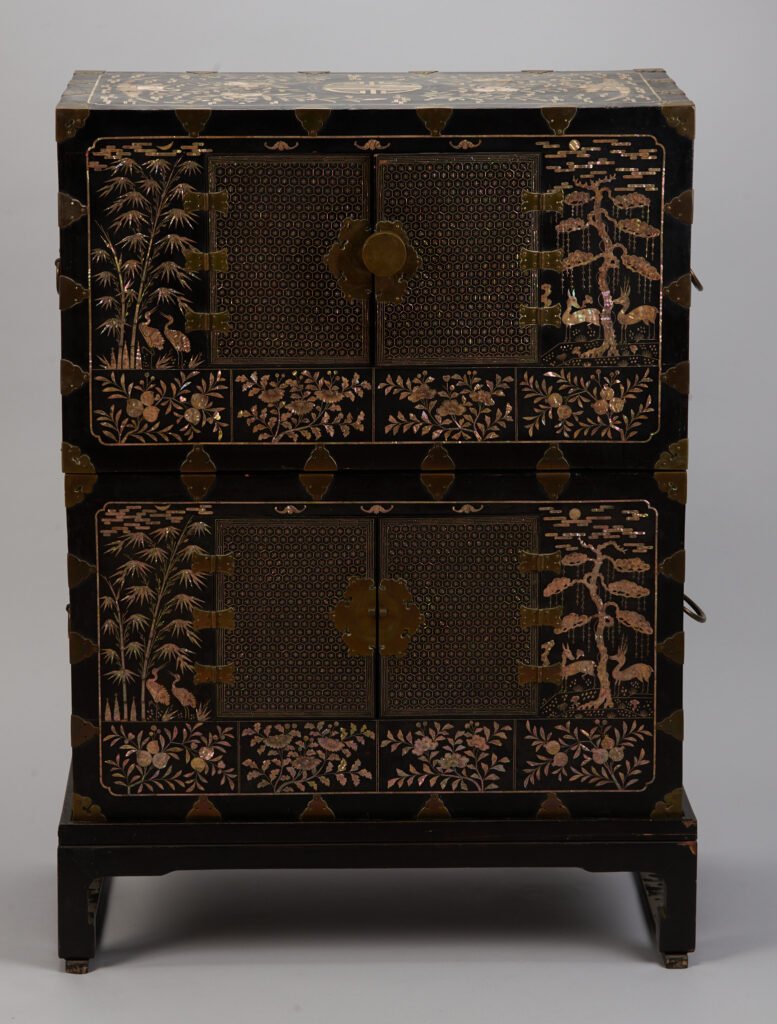
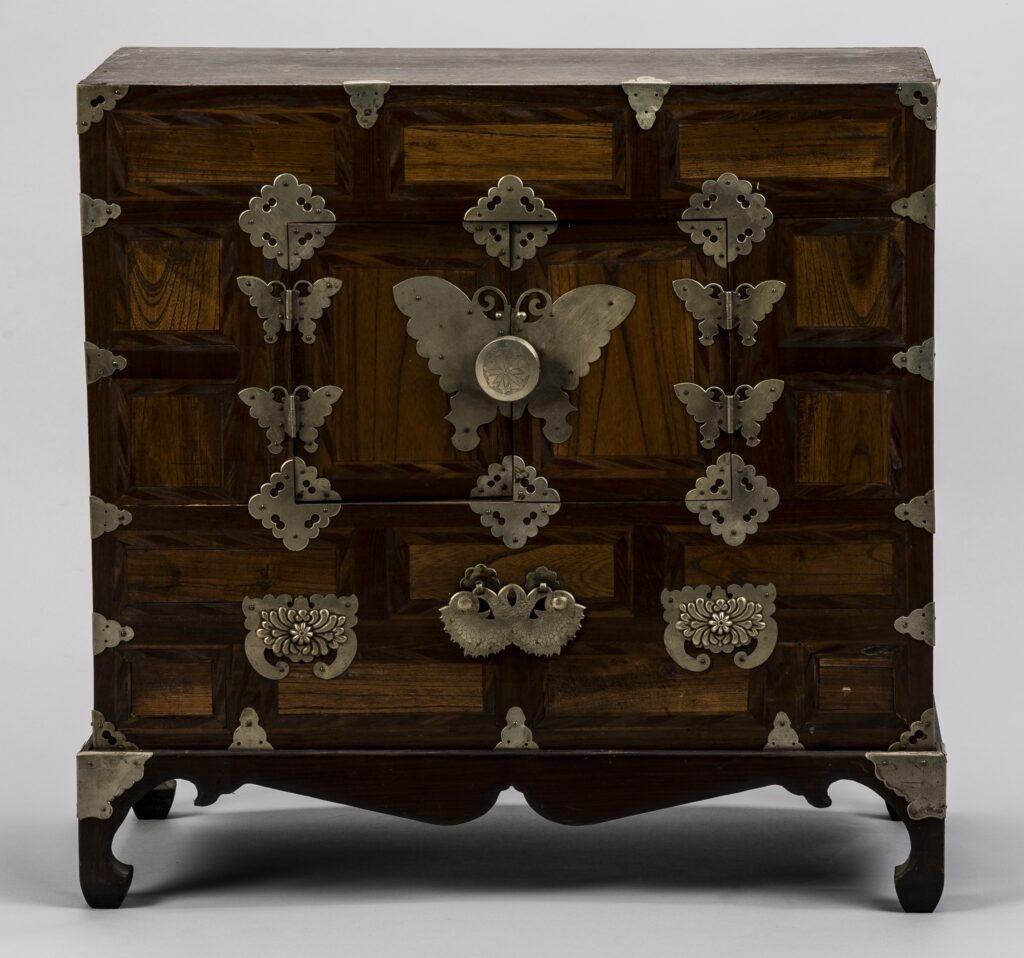
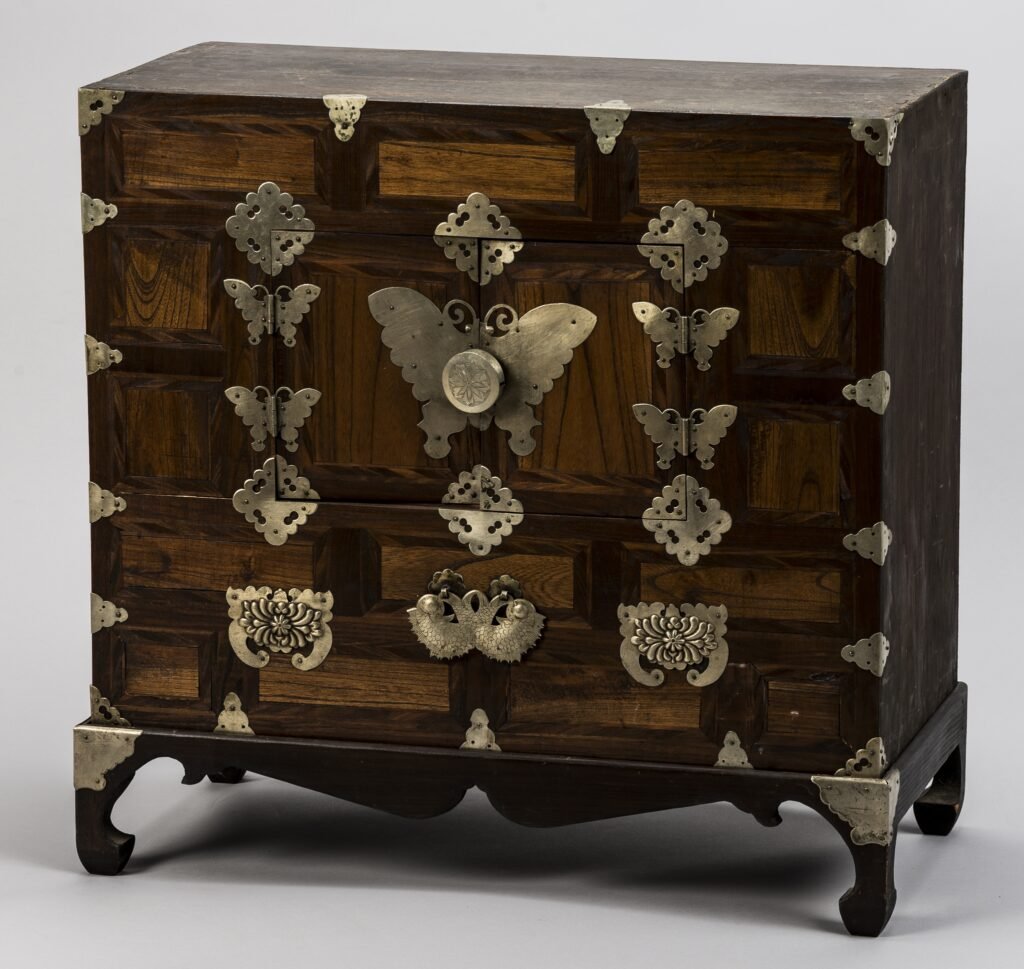
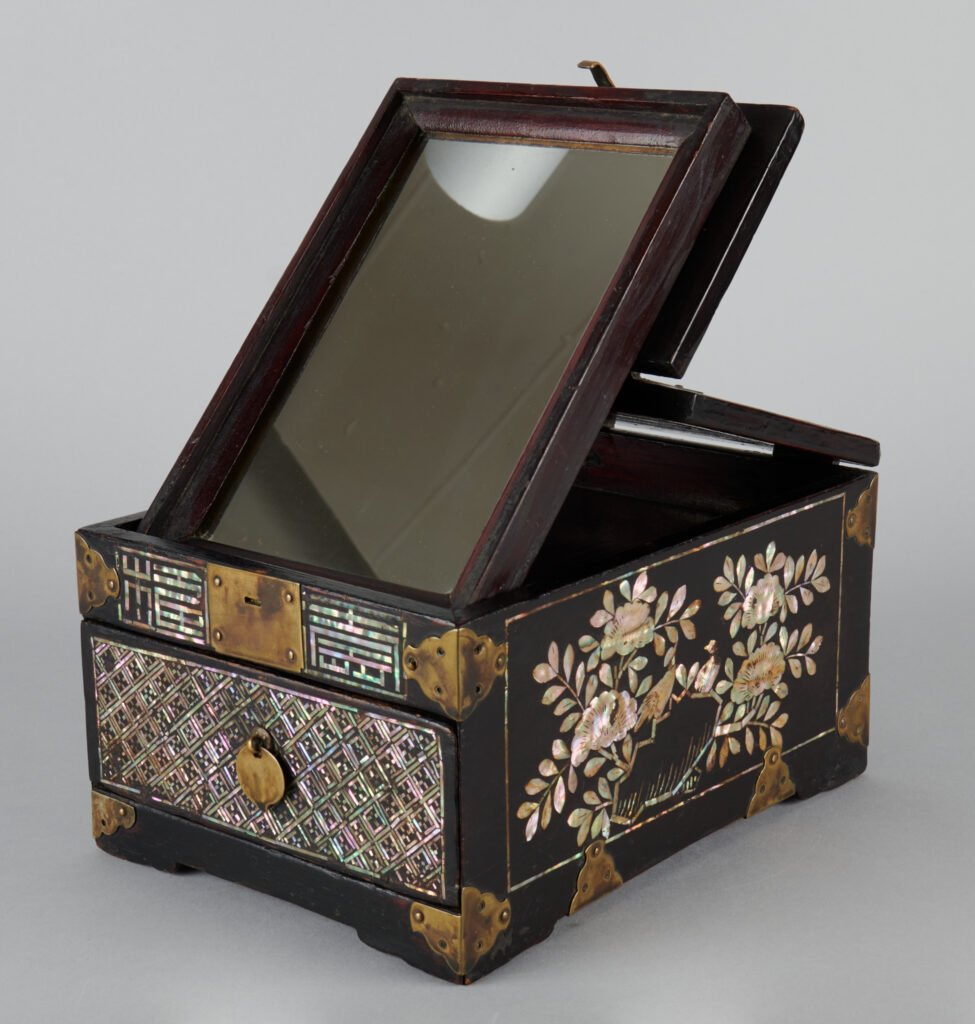
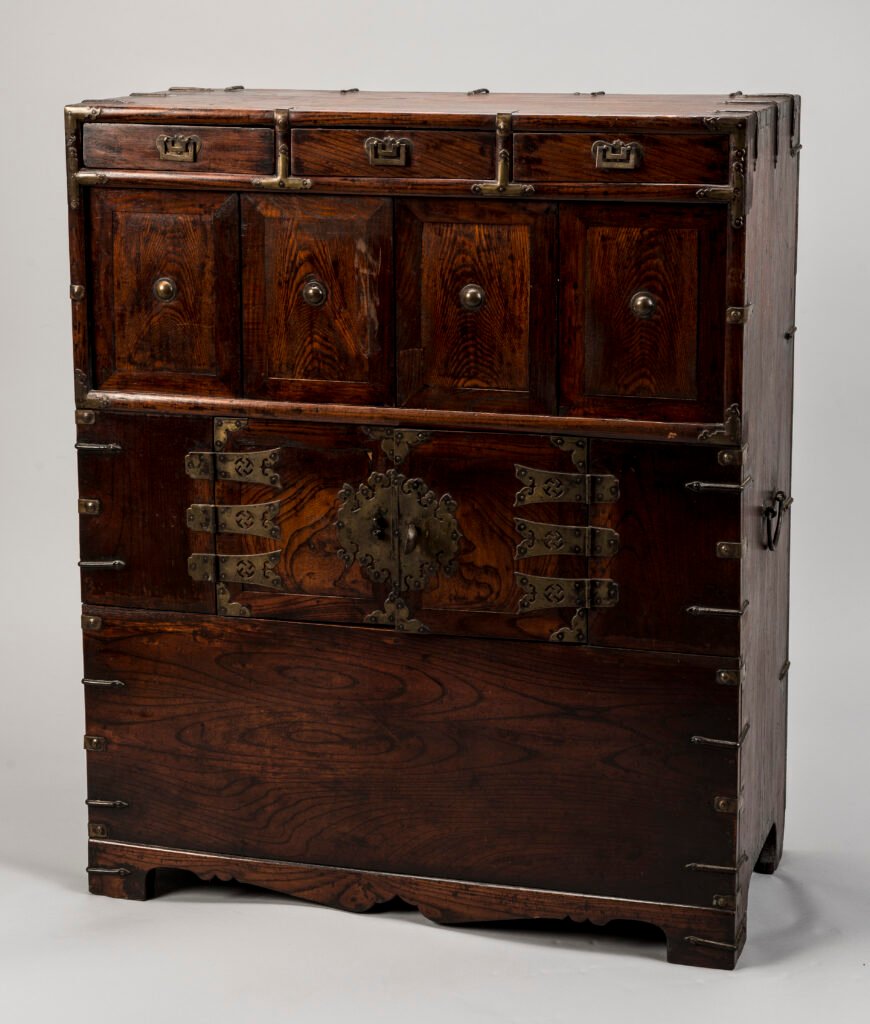
H. 94cm, W. 78,7cm, D. 38,1cm.
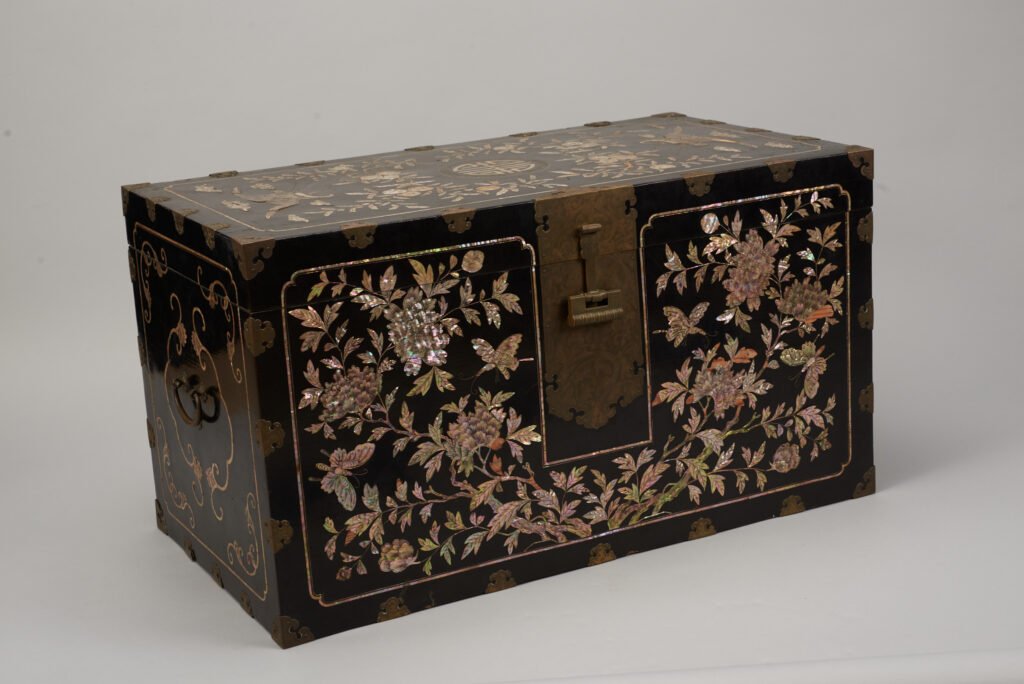
H. 44,5cm, W. 81,3cm, D. 45,7cm.
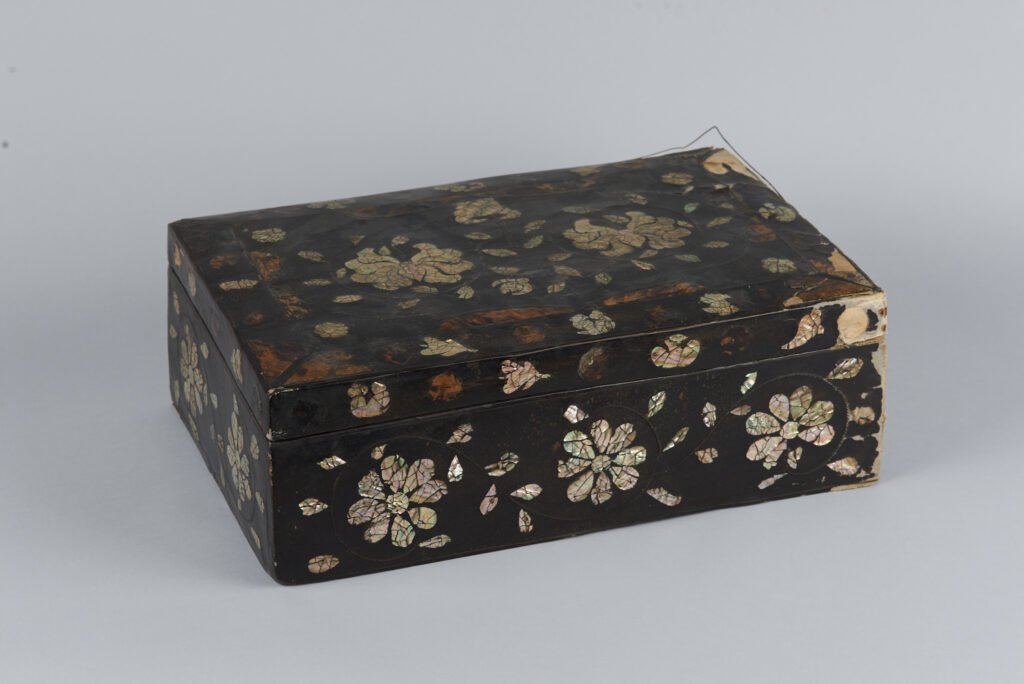
H. 15,6cm, W. 46,5cm, D. 31,1cm.

